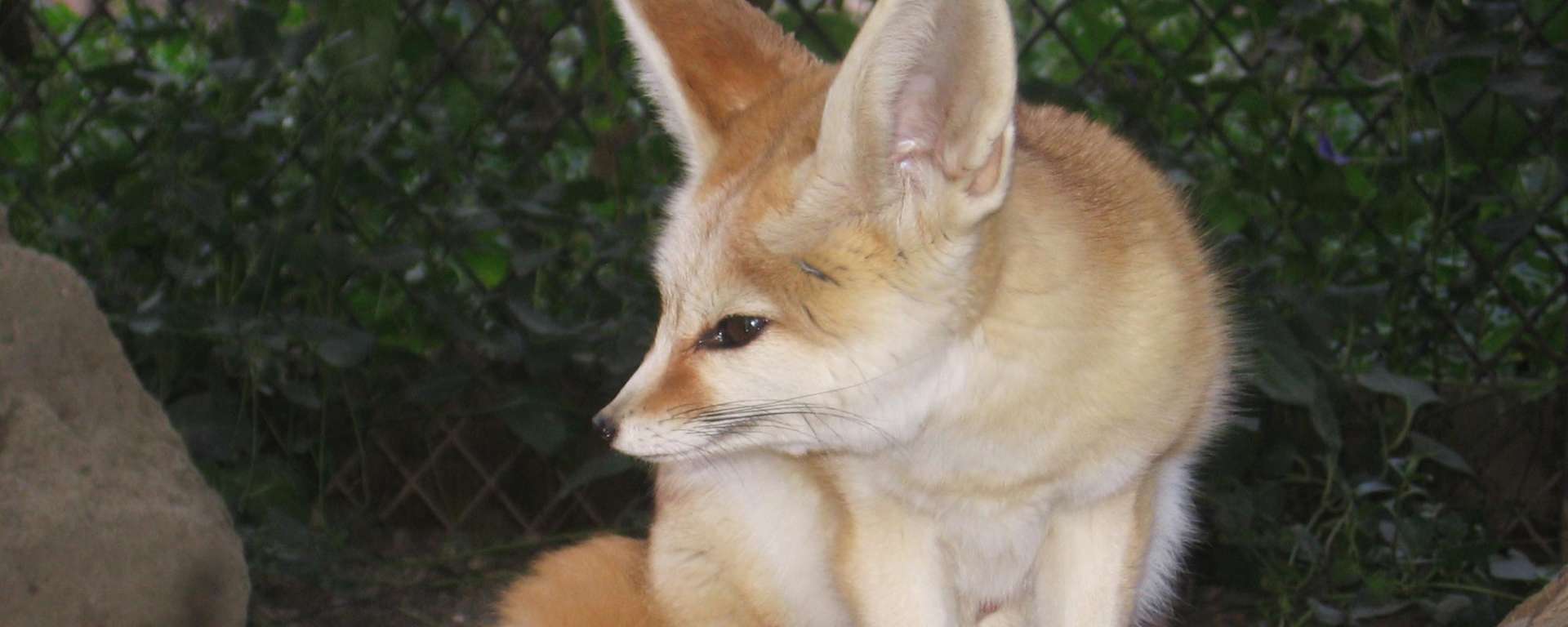
- Fox, Fennec
- Information
- Conservation

Description
Fennec foxes are a fantastic example of the biological concept “form fits function”— all of their most recognizable physical traits can be directly tied to the extreme selective pressures of their natural habitat: the hot, dry Sahara desert of north Africa.
The fennec fox is the world’s smallest naturally occurring canid species. The descriptor “naturally occurring” is important, as there are likely some dog breeds that are smaller than the fennec fox, but these dog breeds reached this size through selective breeding by humans, not through natural selection. There are a variety of benefits to being small in a desert. There is less vegetation in a desert, and therefore less herbivores can be supported and less food is available for predators, so a smaller size means a larger population of carnivores can be supported. Being small also makes it easier to dissipate body heat and stay cool, as well as dig networks of tunnels under the sand.
The physical trait often first noticed on the fennec fox is their massive ears. The ears make up ~20% of the body surface on a fennec fox, and fennec foxes have the largest ear to body ratio of any canid species. These ears work very well for the typical ear function of hearing their prey, but serve another extremely important function of assisting with heat loss. Fennec foxes can dilate the blood vessels in their ears, allowing more blood to to flow through these high surface area ears and more heat to be dissipated.
Fennec foxes have sandy, cream colored coats that both help them blend in with their desert habitat and reflect some sunlight, keeping them slightly cooler. They also have fur on their foot pads, which acts as a buffer to protect the soft pads of their feet from the hot desert sand.
A less outwardly visible but amazing trait of the fennec fox is the slowing of some of their bodily functions. A fennec fox’s metabolism functions at ~2/3rds the rate predicted for their body size, and their heart rate is ~40% lower than what would be expected for their body size. A higher metabolism and faster heart rate means higher food requirements and more heat being generated, so these are huge energy saving traits!
Classification
The IUCN Red List describes the fennec fox as a species of Least Concern , meaning conservationists around the world are not currently worried about the continuation of this species. A small animal that spends lots of time underground in a harsh desert is extremely difficult to survey, so there is no detailed information on fennec fox abundance. However, they seem to be very common in areas farther away from human settlement. In extensive camera trap surveys of Chad, they were the most commonly seen species.
While fennec fox populations as a whole seem to be stable for now, there have been populations near human settlements that have disappeared completely, likely due to their heavy involvement in the pet trade. Fennec foxes are very small and have large ears—traits that humans find extremely cute. Because of this, these foxes are becoming more and more popular as exotic pets. However, fennec foxes are non-domesticated wild animals, and do not make good pets! Their nocturnal and crepuscular (active at dawn and dusk) lifestyle means that they want to be active while you are asleep, their burrowing tendencies mean that your couches and carpets won’t last long, and their vocalizations have been described as extremely unpleasant high-pitched squeals and shrieks. If you love fennec foxes, consider one of the cute stuffed animal fennec foxes in the Safari West gift shop when you visit instead!
Social Life Fennec foxes are thought to be fairly social animals, but there is little data on the social behavior of wild individuals. Groups of parents and their offspring have often been observed together. Offspring have sometimes been observed staying with their parents even after a new litter is born. Under human care they are very social, and will often rest with their bodies touching. Play behavior is common, even in adults.
Habitat and Range Fennec foxes live almost exclusively in arid, sandy regions in the central Sahara Desert in northern Africa. Sand dunes that have been stabilized by vegetation seem to be the ideal habitat.
Diet The fennec fox hunts for a variety of prey including small rodents, small reptiles, insects, small birds, and eggs. Fennec foxes are omnivorous and will supplement their diet with various roots and fruits as needed. They will dig into dirt and sand to find prey and edible plant material, and will also “cache” food (store it for later) by burying it.
Predators There are few large predators in the central Sahara, so predation is likely not a large concern for most fennec foxes. However, these foxes have been observed being predated by large birds of prey such as eagle-owls, as well as jackals and caracals.
Reproduction Sexual maturity: 9 – 12 months Mating Season: January – February Birth Season: March – April Gestation: 50 – 53 days No. of Young: 1 – 6 per litter, usually 1 – 4
Wildlife Sidebar
Animal quick find.
- Antelope, Roan
- Buffalo, Cape
- Crane, Blue
- Crane, Demoiselle
- Crane, Gray Crowned
- Crane, Sarus
- Dove, Madagascar Turtle
- Duck, Laysan
- Duck, Mandarin
- Duck, Ruddy
- Duck, White-faced Whistling
- Duiker, Blue
- Egret, Cattle
- Eland, Common
- Flamingo, American
- Flamingo, Greater
- Flamingo, Lesser
- Gazelle, Dama
- Goose, African Pygmy
- Goose, Egyptian
- Guineafowl, Helmeted
- Guineafowl, Vulturine
- Hog, Red River
- Hoopoe, Green Wood
- Hornbill, Abyssinian Ground
- Hornbill, Southern Ground
- Hornbill, Trumpeter
- Hyena, Striped
- Ibis, Northern Bald
- Ibis, Sacred
- Ibis, Scarlet
- Junglefowl, Red
- Kookaburra, Laughing
- Kudu, Greater
- Lapwing, Spur-winged
- Lemur, Red Ruffed
- Lemur, Ring-tailed
- Lorikeet, Rainbow
- Lovebird, Fischer's
- Monkey, De Brazza's
- Monkey, Patas
- Oryx, Scimitar-Horned
- Pheasant, Great Argus
- Pigeon, Blue Crowned
- Pigeon, Green Imperial
- Pigeon, Nicobar
- Pigeon, Pied Imperial
- Pintail, White-cheeked
- Porcupine, Crested
- Rhinoceros, Southern White
- Screamer, Crested
- Secretary Bird
- Shelduck, Common
- Spoonbill, African
- Spoonbill, Roseate
- Stork, Saddle-billed
- Stork, White
- Stork, White-bellied
- Swamphen, Gray-headed
- Swan, Black
- Teal, Ringed
- Thick-knee, Cape
- Tortoise, Sulcata
- Turaco, Green
- Turaco, Violet
- Vulture, Hooded
- Weaver, Taveta Golden
Zebra, Plains
When fennec fox kits are born, their ears are folded flat to their heads and only lift and unfold at about 10 days old.
The name "fennec" is derived from the Arabic word "fanak" (فَنَك), which means "fox". The name "Sahara" is derived from the Arabic word "ṣaḥrāʾ", (صَحْرَاء ), which means "desert". Therefore, in English, the fennec fox from the Sahara desert is really the fox fox from the desert desert.

Animal encyclopedia
The adorable fennec fox: all you need to know.
Updated on: September 14, 2023

John Brooks
September 14, 2023 / Reading time: 5 minutes

Sophie Hodgson
We adhere to editorial integrity are independent and thus not for sale. The article may contain references to products of our partners. Here's an explanation of how we make money .
Why you can trust us
Wild Explained was founded in 2021 and has a long track record of helping people make smart decisions. We have built this reputation for many years by helping our readers with everyday questions and decisions. We have helped thousands of readers find answers.
Wild Explained follows an established editorial policy . Therefore, you can assume that your interests are our top priority. Our editorial team is composed of qualified professional editors and our articles are edited by subject matter experts who verify that our publications, are objective, independent and trustworthy.
Our content deals with topics that are particularly relevant to you as a recipient - we are always on the lookout for the best comparisons, tips and advice for you.
Editorial integrity
Wild Explained operates according to an established editorial policy . Therefore, you can be sure that your interests are our top priority. The authors of Wild Explained research independent content to help you with everyday problems and make purchasing decisions easier.
Our principles
Your trust is important to us. That is why we work independently. We want to provide our readers with objective information that keeps them fully informed. Therefore, we have set editorial standards based on our experience to ensure our desired quality. Editorial content is vetted by our journalists and editors to ensure our independence. We draw a clear line between our advertisers and editorial staff. Therefore, our specialist editorial team does not receive any direct remuneration from advertisers on our pages.
Editorial independence
You as a reader are the focus of our editorial work. The best advice for you - that is our greatest goal. We want to help you solve everyday problems and make the right decisions. To ensure that our editorial standards are not influenced by advertisers, we have established clear rules. Our authors do not receive any direct remuneration from the advertisers on our pages. You can therefore rely on the independence of our editorial team.
How we earn money
How can we earn money and stay independent, you ask? We'll show you. Our editors and experts have years of experience in researching and writing reader-oriented content. Our primary goal is to provide you, our reader, with added value and to assist you with your everyday questions and purchasing decisions. You are wondering how we make money and stay independent. We have the answers. Our experts, journalists and editors have been helping our readers with everyday questions and decisions for over many years. We constantly strive to provide our readers and consumers with the expert advice and tools they need to succeed throughout their life journey.
Wild Explained follows a strict editorial policy , so you can trust that our content is honest and independent. Our editors, journalists and reporters create independent and accurate content to help you make the right decisions. The content created by our editorial team is therefore objective, factual and not influenced by our advertisers.
We make it transparent how we can offer you high-quality content, competitive prices and useful tools by explaining how each comparison came about. This gives you the best possible assessment of the criteria used to compile the comparisons and what to look out for when reading them. Our comparisons are created independently of paid advertising.
Wild Explained is an independent, advertising-financed publisher and comparison service. We compare different products with each other based on various independent criteria.
If you click on one of these products and then buy something, for example, we may receive a commission from the respective provider. However, this does not make the product more expensive for you. We also do not receive any personal data from you, as we do not track you at all via cookies. The commission allows us to continue to offer our platform free of charge without having to compromise our independence.
Whether we get money or not has no influence on the order of the products in our comparisons, because we want to offer you the best possible content. Independent and always up to date. Although we strive to provide a wide range of offers, sometimes our products do not contain all information about all products or services available on the market. However, we do our best to improve our content for you every day.
Table of Contents
The Fennec fox is a fascinating creature that captures the hearts of many with its unique characteristics and adorable appearance . In this article, we will explore the world of the Fennec fox, from its physical characteristics and habitat to its diet, social behavior, and its interaction with humans. Join us on this journey to discover all you need to know about these delightful creatures.
Understanding the Fennec Fox
Before delving into the specifics of the Fennec fox, it is important to gain a general understanding of this extraordinary animal. The Fennec fox, known scientifically as Vulpes zerda, is a small fox species native to the sandy deserts of North Africa. With its distinctively large ears and small body size, the Fennec fox is well adapted to its desert habitat.
Physical Characteristics of the Fennec Fox
One of the most notable features of the Fennec fox is its oversized ears, which can grow up to 6 inches in length. These ears serve multiple purposes, including heat regulation and keen hearing. The Fennec fox also possesses long, dense fur that helps insulate it from the extremes of desert temperatures.
In addition to its ears and fur, the Fennec fox has other unique physical characteristics. Its paws are covered in thick fur, acting as natural snowshoes, allowing it to walk effortlessly on the soft desert sand. The Fennec fox also has sharp claws that help it dig burrows, providing shelter from the scorching sun and predators.
The Fennec Fox’s Unique Adaptations
To survive in the harsh environment of the desert, the Fennec fox has developed several unique adaptations . One such adaptation is its ability to conserve water. The Fennec fox obtains most of its water through the food it eats, reducing its reliance on external water sources.
Another remarkable adaptation of the Fennec fox is its ability to withstand extreme temperatures. Its large ears play a crucial role in regulating body temperature by dissipating heat. During the scorching daytime heat, the Fennec fox’s blood vessels in its ears dilate, allowing heat to escape. At night, when temperatures drop, these blood vessels constrict, minimizing heat loss.
The Habitat of the Fennec Fox
The Fennec fox primarily inhabits the Sahara Desert and other arid regions of North Africa. Its geographic distribution extends from Morocco and Algeria in the west to Egypt and Sudan in the east. These foxes have adapted to thrive in the desert environment, where food and water can be scarce.
Geographic Distribution
Across its range, the Fennec fox can be found in a variety of desert habitats, including sandy dunes, rocky outcrops, and shrub-covered plains. It is well-suited to live in these areas due to its unique physical adaptations, which allow it to navigate the sandy terrain and withstand the challenges of the desert landscape.
Living Conditions in the Wild
Life in the wild can be tough for the Fennec fox. With scorching daytime temperatures and frigid nights, it must adapt to survive. Despite the harsh conditions, the Fennec fox has developed remarkable strategies to cope with the desert environment. Its burrows provide shelter and protection from predators and temperature extremes.
The Fennec Fox’s Diet and Hunting Habits
The diet of the Fennec fox consists of a wide range of food sources, enabling it to survive in the desert where resources are scarce. These resourceful foxes are omnivorous, meaning they consume both plant matter and animal prey .
What Does a Fennec Fox Eat?
Plant matter forms a significant part of the Fennec fox’s diet. It feeds on a variety of desert vegetation , including fruits, roots, and leaves. Additionally, the Fennec fox is adept at hunting small prey, such as insects, rodents, and birds. This flexibility in its diet allows the Fennec fox to adapt and survive even when traditional food sources are limited.
Hunting Techniques and Predators
The Fennec fox employs various hunting techniques to secure its prey. It uses its exceptional hearing and keen senses to locate food sources. Once a potential meal is detected, the Fennec fox pounces on its prey with agility and precision .
Despite its speed and agility, the Fennec fox still faces threats from predators in the desert. Foxes are preyed upon by larger carnivores , including jackals and birds of prey. However, their burrows provide essential protection, allowing them to escape from predators and seek refuge when needed.
The Social Behavior of Fennec Foxes
Fennec foxes are social animals that live in small family groups or colonies. Understanding their social behavior gives us insight into their complex lives and interactions with one another.
Mating and Reproduction
During the mating season, which occurs between January and February, male Fennec foxes engage in vocal displays and mark their territories to attract females. Once a pair forms, they usually stay monogamous for life, working together to raise their offspring.
Female Fennec foxes give birth to litters of typically one to four kits after a gestation period of about 50 days. Both parents actively participate in caring for the newborn kits, with the male being responsible for hunting and feeding the family while the female nurses and protects the young.
Communication and Social Structure
Communication plays a vital role in the social structure of Fennec foxes. They utilize a combination of vocalizations, body postures, and scent marking to establish social bonds and signal intentions. Vocalizations include barks, purrs, and growls , which are used for various purposes, such as mating calls, warning signals, or territorial disputes.
Within their social groups, Fennec foxes exhibit a hierarchical structure that ensures order and cooperative living. The alpha male and female typically take on leadership roles and make most of the decisions for the group.
The Fennec Fox and Human Interaction
The undeniable cuteness of the Fennec fox has sparked interest in keeping them as pets. However, it is essential to understand the implications of this interaction and the conservation status of these remarkable animals.
Fennec Foxes as Pets
While the idea of having a Fennec fox as a pet may be appealing to some, it is important to consider the welfare and legalities surrounding their ownership. Fennec foxes have specific care requirements and needs that may not be easily met in domestic settings.
Additionally, the capture and trade of Fennec foxes for pets can contribute to their decline in the wild. It is crucial to promote responsible pet ownership and consider the impact on the conservation of these species before deciding to keep a Fennec fox as a pet.
Conservation Status and Threats
The Fennec fox is currently listed as a species of least concern by the International Union for Conservation of Nature (IUCN). However, this does not mean they are free from threats. Habitat loss, human encroachment, and climate change pose significant challenges to their survival.
Efforts are underway to protect their natural habitats and raise awareness about the importance of conserving these unique desert dwellers. By supporting conservation initiatives and promoting sustainable practices, we can help ensure the preservation of the Fennec fox and its desert ecosystem.
In conclusion, the Fennec fox is a captivating creature with an array of unique characteristics and adaptations that allow it to thrive in the harsh deserts of North Africa. From their physical attributes and habitat to their diet, social behavior, and interaction with humans, there is so much to appreciate and learn about these adorable foxes. By understanding and respecting their needs, we can contribute to the conservation of these fascinating creatures and ensure their continued existence in the wild.
Related articles
- Fresh Food for Cats – The 15 best products compared
- The Adorable Zuchon: A Guide to This Cute Hybrid Dog
- Exploring the Unique Characteristics of the Zorse
- Meet the Zonkey: A Unique Hybrid Animal
- Uncovering the Secrets of the Zokor: A Comprehensive Overview
- Understanding the Zebu: An Overview of the Ancient Cattle Breed
- Uncovering the Fascinating World of Zebrafish
- Watch Out! The Zebra Spitting Cobra is Here
- The Fascinating Zebra Tarantula: A Guide to Care and Maintenance
- The Yellow-Bellied Sapsucker: A Closer Look
- Uncovering the Mystery of the Zebra Snake
- The Amazing Zebra Pleco: All You Need to Know
- Discovering the Fascinating Zebra Shark
- Understanding the Impact of Zebra Mussels on Freshwater Ecosystems
- Caring for Your Zebra Finch: A Comprehensive Guide
- The Fascinating World of Zebras
- The Adorable Yorkshire Terrier: A Guide to Owning This Lovable Breed
- The Adorable Yorkie Poo: A Guide to This Popular Dog Breed
- The Adorable Yorkie Bichon: A Perfect Pet for Any Home
- The Adorable Yoranian: A Guide to This Sweet Breed
- Discover the Deliciousness of Yokohama Chicken
- Uncovering the Mystery of the Yeti Crab
- Catching Yellowtail Snapper: A Guide to the Best Fishing Spots
- The Brightly Colored Yellowthroat: A Guide to Identification
- Identifying and Dealing with Yellowjacket Yellow Jackets
- The Yellowish Cuckoo Bumblebee: A Formerly Endangered Species
- The Yellowhammer: A Symbol of Alabama’s Pride
- The Benefits of Eating Yellowfin Tuna
- The Yellow-Faced Bee: An Overview
- The Majestic Yellow-Eyed Penguin
- The Yellow-Bellied Sea Snake: A Fascinating Creature
- The Benefits of Keeping a Yellow Tang in Your Saltwater Aquarium
- The Beautiful Black and Yellow Tanager: A Closer Look at the Yellow Tanager
- The Fascinating Yellow Spotted Lizard
- What You Need to Know About the Yellow Sac Spider
- Catching Yellow Perch: Tips for a Successful Fishing Trip
- The Growing Problem of Yellow Crazy Ants
- The Rare and Beautiful Yellow Cobra
- The Yellow Bullhead Catfish: An Overview
- Caring for a Yellow Belly Ball Python
- The Impact of Yellow Aphids on Agriculture
- Catching Yellow Bass: Tips and Techniques for Success
- The Striking Beauty of the Yellow Anaconda
- Understanding the Yarara: A Guide to This Unique Reptile
- The Yakutian Laika: An Overview of the Ancient Arctic Dog Breed
- The Fascinating World of Yaks: An Introduction
- Everything You Need to Know About Yabbies
- The Xoloitzcuintli: A Unique Breed of Dog
- Uncovering the Mystery of Xiongguanlong: A Newly Discovered Dinosaur Species
- Uncovering the Mysteries of the Xiphactinus Fish
- Camp Kitchen
- Camping Bags
- Camping Coolers
- Camping Tents
- Chair Rockers
- Emergency Sets
- Flashlights & Lanterns
- Grills & Picnic
- Insect Control
- Outdoor Electrical
- Sleeping Bags & Air Beds
- Wagons & Carts
- Beds and furniture
- Bowls and feeders
- Cleaning and repellents
- Collars, harnesses and leashes
- Crates, gates and containment
- Dental care and wellness
- Flea and tick
- Food and treats
- Grooming supplies
- Health and wellness
- Litter and waste disposal
- Toys for cats
- Vitamins and supplements
- Dog apparel
- Dog beds and pads
- Dog collars and leashes
- Dog harnesses
- Dog life jackets
- Dog travel gear
- Small dog gear
- Winter dog gear
© Copyright 2024 | Imprint | Privacy Policy | About us | How we work | Editors | Advertising opportunities
Certain content displayed on this website originates from Amazon. This content is provided "as is" and may be changed or removed at any time. The publisher receives affiliate commissions from Amazon on eligible purchases.

Search form

- CLASS: Mammalia (Mammals)
- ORDER: Carnivora
- FAMILY: Canidae
- GENUS: Vulpes
- SPECIES: zerda

Meet the fennec fox: While it is the smallest fox in the world, the fennec fox possesses tons of cuteness and charm. With their most notable characteristic being their large ears, they are always a favorite. These pint-sized canids are extremely adaptable in their native desert environment.
The fennecs are most recognizable by their large ears, reaching 4 to 6 inches in length. Those ears not only help them listen for prey underground, but also serve to dissipate excess heat of the desert. They have a thick, sandy-colored coat that keeps them warm at night and reflects the sunlight during the day. They even have fur on their feet that protects their footpads from the scorching ground.
Safety in burrows: Humans are an ominous predator of the fennec fox, as the animals are trapped in some areas and sold into the pet trade or even hunted for their lush fur. Large diurnal predators such as birds of prey or hyenas could catch them if the foxes journey outside the burrow, so staying inside during the day is sensible for this little creature. Their nocturnal nature keeps them safe from animal predators. Their heat-reflecting coat also provides excellent camouflage in their surroundings.
HABITAT AND DIET
Fennec foxes live in deserts and semi-desert habitats. The home range of these foxes is widespread throughout the deserts of the Sahara and throughout North Africa. They burrow into sand dunes during the day, to avoid the extreme heat. These cool dens can be up to 3 feet deep. Although considered to be solitary, Fennec foxes live in small communities of around 10 individuals, with dens being close in proximity or in some cases connected to one another.
Fennec foxes are mostly nocturnal animals. They spend most of the day in an underground burrow avoiding the desert heat. They emerge from their dens at dusk to begin the search for food.
These foxes are omnivores, feasting on a variety of prey as nighttime hunters. They enjoy insects, rodents, snails, lizards, plants, fruits, roots, and eggs. Their large ears provide impeccable hearing to locate prey. Being desert dwellers, they have adapted to living with very little water; most of the water they need comes from the plants they consume.
At the San Diego Zoo the fennec fox receives canine kibble, carnivore meat diet, and mixed vegetables. Insects are tasty enrichment items.
FAMILY LIFE
Family starter "kit": Breeding season occurs annually in January and February, with females giving birth in March or April. Fennec foxes are monogamous and mate for life.
Litters consist of 2-5 kits, after a gestation period of about 50 days. Females stay with the kits until they are weaned, after 60 to 70 days; and males venture to hunt for food for the family. Kits reach sexual maturity at 10 months old.
Like other canids, fennec foxes bark, as well as whimper and whine to communicate. Like other canids, fennec foxes mark their territory by urinating around the perimeter.
CONSERVATION
The fennec fox is currently listed as a species of least concern , according to the International Union for Conservation of Nature (IUCN) Red List of Threatened Species. While there are no major threats to the desert-dwelling wild populations, habitat loss still occurs in their native range. They are also at risk from the illegal pet trade. In Northern Africa, they are in danger of being trapped or hunted and sold commercially.
By supporting San Diego Zoo Wildlife Alliance, you are our ally in saving and protecting wildlife worldwide.

10 years in the wild; 13 years in zoos
Gestation: About 50 days
Number of young at birth: 2 to 5 kits per litter
Age of maturity: 10 months
Length: 9 to 16 inches (29 to 41 centimeters)
Weight: About 3.5 pounds (1.6 kilograms)
Tail length: up to 12 inches (30.5 centimeters)
The fennec fox is one of the only carnivores that seems to do well in the Sahara desert because of its ability to survive with very little water.
While their legs may not be long, fennec foxes can run 20 miles per hour.
Fennec foxes' ears can be half as long as their body.
DISCOVER WILDLIFE
More animals & plants from san diego zoo and san diego zoo safari park.
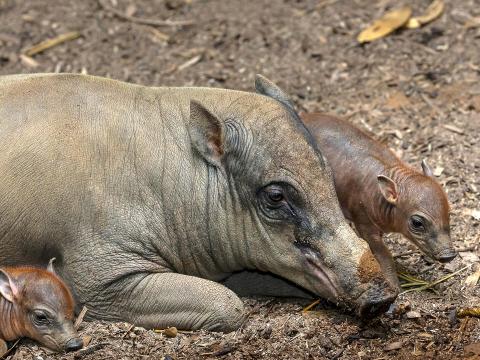
The fennec fox is the smallest of all the world's foxes, but its large ears, measuring 6 inches, appear to be on loan from a bigger relative.
Desert Adaptations
Fennec foxes dwell in the sandy Sahara and elsewhere in North Africa. Their nocturnal habits help them deal with the searing heat of the desert environment, and some physical adaptations help as well.
Their distinctive, batlike ears radiate body heat and help keep the foxes cool. They also have long, thick hair that insulates them during cold nights and protects them from hot sun during the day. Even the fox's feet are hairy, which helps them perform like snowshoes and protects them from extremely hot sand. The fox's feet are also effective shovels for frequent digging—fennec foxes live in underground dens.
Diet and Behavior
These foxes dwell in small communities, each inhabited by perhaps ten individuals. Like other canids, male fennecs mark their territory with urine and become aggressive competitors when mating season arrives each year.
Fennec foxes are opportunistic eaters. They forage for plants but also eat rodents, eggs, reptiles, and insects. Like most desert dwellers, the fennec fox has developed the ability to go for long periods without water.
These foxes are cream-colored with black-tipped tails. Their adorable appearance makes them favorites of the captive pet trade, and local peoples also hunt the fennec fox for its fur. Little is known about the status of wild fennec fox populations.
- Environment
- Perpetual Planet
History & Culture
- History & Culture
- History Magazine
- Mind, Body, Wonder
- Paid Content
- Terms of Use
- Privacy Policy
- Your US State Privacy Rights
- Children's Online Privacy Policy
- Interest-Based Ads
- About Nielsen Measurement
- Do Not Sell or Share My Personal Information
- Nat Geo Home
- Attend a Live Event
- Book a Trip
- Inspire Your Kids
- Shop Nat Geo
- Visit the D.C. Museum
- Learn About Our Impact
- Support Our Mission
- Advertise With Us
- Customer Service
- Renew Subscription
- Manage Your Subscription
- Work at Nat Geo
- Sign Up for Our Newsletters
- Contribute to Protect the Planet
Copyright © 1996-2015 National Geographic Society Copyright © 2015-2024 National Geographic Partners, LLC. All rights reserved

- South Africa
- Philippines
- Faroe Islands
- Netherlands
- United States
- French Polynesia
- New Zealand
Get To Know The Fennec Fox
Whether you’re a die-hard animal lover or just looking to amp up your trivia game, this journey into the Fennec Fox’s world is guaranteed to spice up your knowledge and maybe even your Instagram feed.
What is the Fennec Fox?
Imagine the desert, vast and unforgiving. Now, picture the most adorable creature with oversized ears popping up from behind a dune. That, my friend, is the Fennec Fox, the fluffiest, most eye-catching character of the Sahara. Officially tagged as Vulpes zerda in the science world, this little fox could win the “Miss Universe” of the animal kingdom based on cuteness alone.
Native to the Sahara Desert and parts of North Africa, these pint-sized predators are built to thrive in some of the harshest conditions on Earth. They’re the smallest members of the canine family, but don’t let their size fool you; these foxes are more than meets the eye.
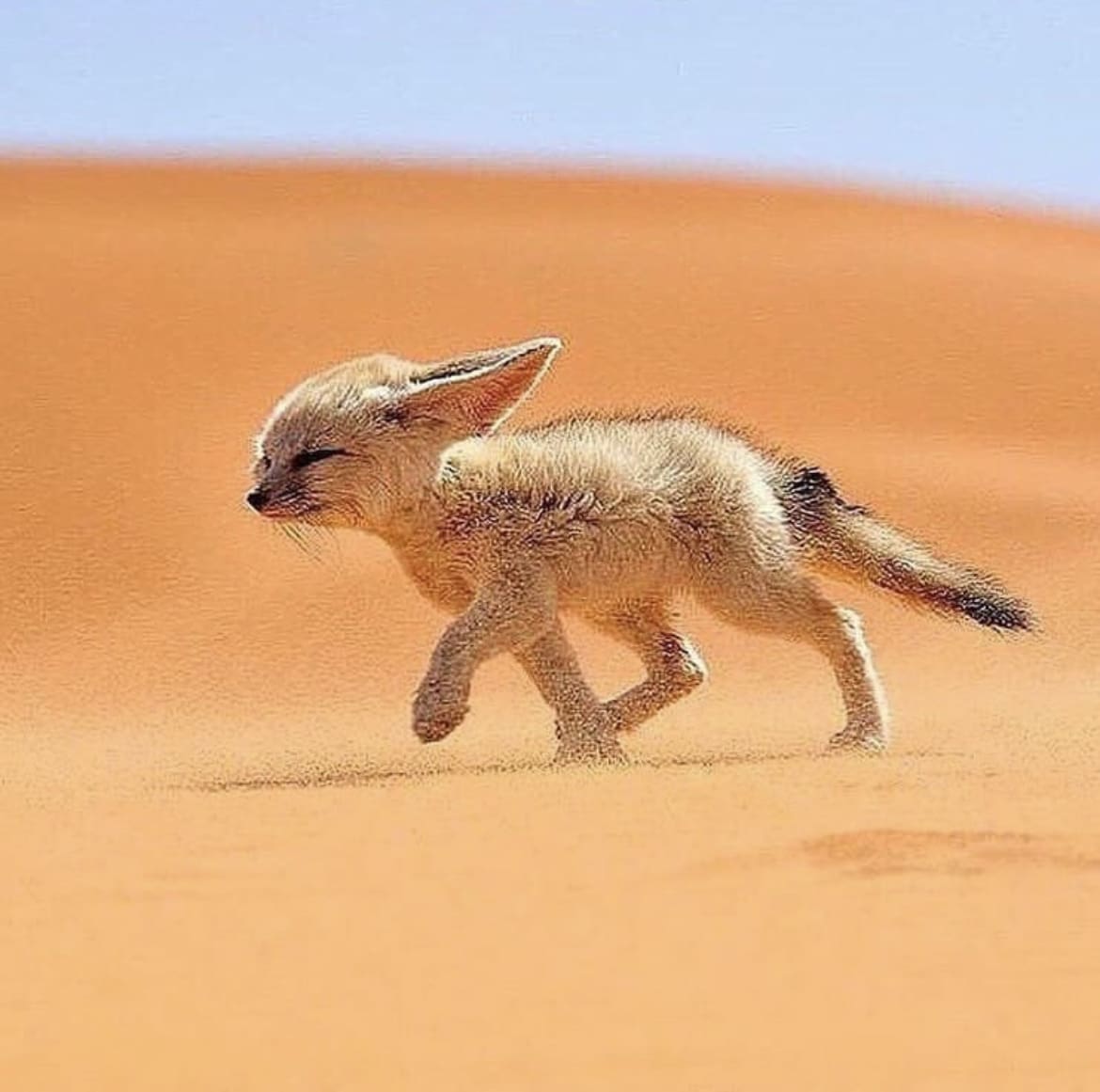
What do Fennec Foxes look like?
Okay, picture this: a mix between a high-quality plush toy and an anime character. Fennec Foxes sport a cream-colored fur that can range from soft white to light brown, designed to reflect the desert’s scorching sun. But their most striking feature has to be those enormous, bat-like ears. Not just for show, these satellite dishes can be half as long as their body and are perfect for dissipating heat and listening for prey under the sand.
With dark, almond-shaped eyes that sparkle like jewels in their fluffy faces, it’s no wonder these creatures look like they’ve jumped straight out of a magical realm.
How big are Fennec Foxes?
Ever held a chihuahua? Then you’ve got a pretty good idea of how big (or should I say, small) Fennec Foxes are. Weighing in at just 2 to 3.5 pounds (1 to 1.5 kilograms) and measuring about 14 to 16 inches (35 to 40 centimeters) in body length, they’re the tiniest canines around.
But let’s not forget the tail—a bushy, black-tipped marvel that adds another 7 to 12 inches (18 to 30 centimeters) to their length. This tail isn’t just for show; it’s a versatile tool for communication, balance, and even warmth during those chilly desert nights.
Fennec Fox Skin
When it comes to surviving in the desert, every feature counts, and for Fennec Foxes, their skin is a key player. It’s like they’re wearing a built-in, all-weather coat tailored for extreme conditions.
Their skin is thick enough to handle the midday sun yet sensitive enough to lose excess heat when the cool night rolls in. Covered in that soft, fluffy fur, their skin helps regulate their body temperature, ensuring they stay cool under the scorching sun and warm during those brisk desert nights.
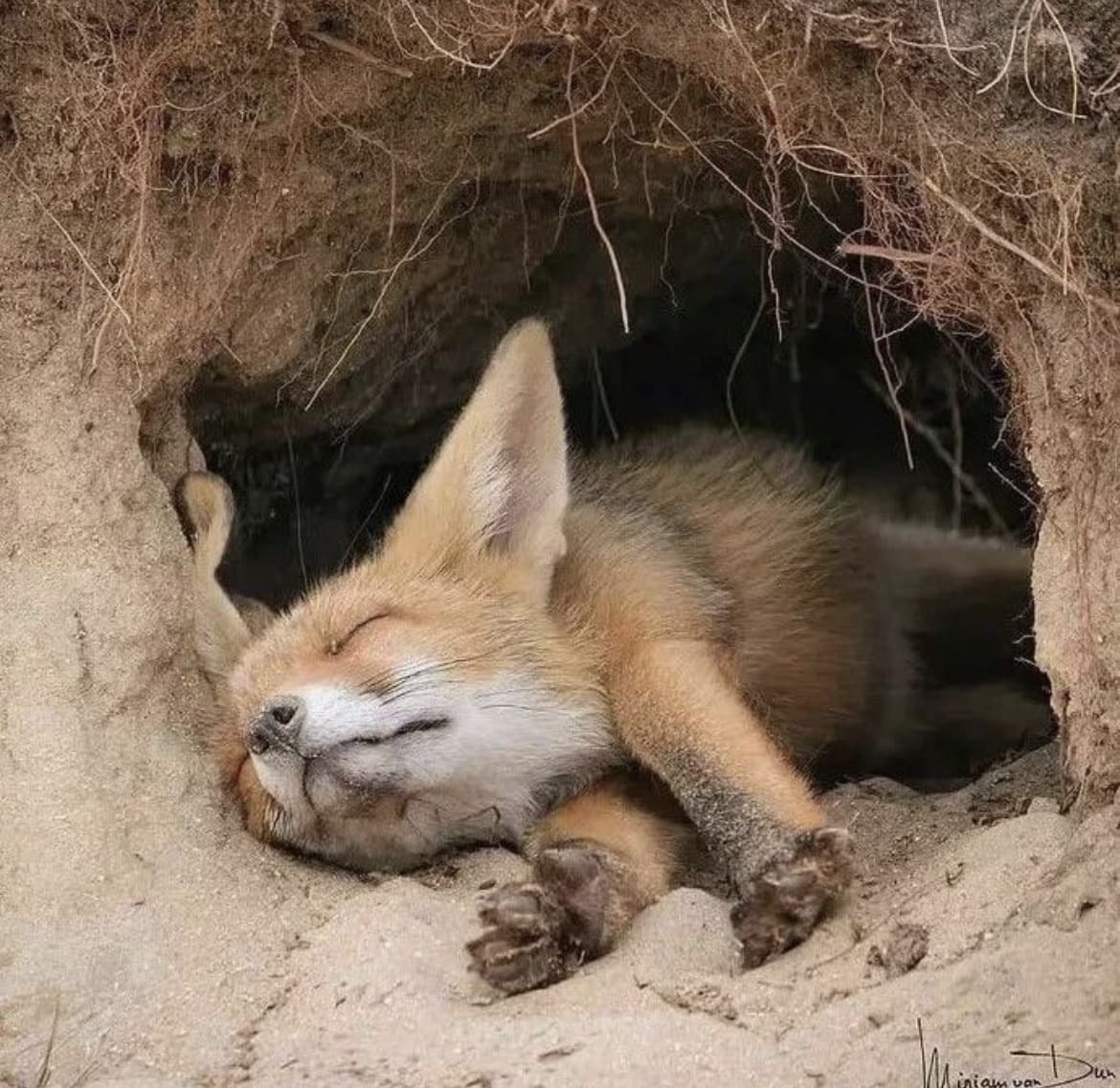
Fennec Fox Teeth
Fennec Foxes are omnivores, which means their dental toolkit needs to handle both the crunch of insects and the occasional tenderness of fruits. Their teeth are small but mighty, designed to efficiently crunch down on their varied diet. The sharp canines? Perfect for snagging a quick-moving meal. The molars? Ideal for grinding down plant material.
It’s this adaptability in their diet, mirrored by their versatile teeth, that lets them thrive in an environment where food can be scarce and every calorie counts.
Fennec Fox Ears
Ah, the crowning glory of the Fennec Fox—the ears. If you thought they were just for show, think again. These oversized audio receivers serve multiple survival functions. First, they’re like personal air conditioners, radiating heat away from the body to keep these little guys cool. Then there’s their incredible hearing, allowing Fennec Foxes to detect prey moving underground, even at great distances.
Whether it’s the scuttle of a beetle beneath the sand or the distant patter of a fellow fox’s feet, those ears miss nothing. It’s this combination of thermal regulation and acute hearing that makes their iconic ears more than just a cute accessory.
What do Fennec Foxes eat?
The Fennec Fox’s diet is as diverse as the desert is vast. These omnivorous little adventurers aren’t picky eaters. Their menu includes everything from insects and small rodents to birds, eggs, and even fruits.
This versatility in their diet is a testament to their adaptability, allowing them to thrive in an environment where food sources can be unpredictable. The Fennec Fox’s ability to switch gears based on availability ensures they’re always able to rustle up something to munch on, making them the ultimate desert foragers.
How do Fennec Foxes hunt?
Now, onto the hunt. Fennec Foxes are nocturnal creatures, which means they do most of their hunting under the cover of night. Their large ears aren’t just for show; they play a crucial role in locating prey hidden beneath the sand. Once they’ve homed in on their target, they use their agile, lightweight bodies to dig or pounce with surprising speed.
Their hunting strategy is a blend of patience, precision, and prowess, allowing them to snag meals that other predators might overlook. It’s this combination of keen senses and agility that makes the Fennec Fox a master hunter of the night.
Fennec Fox Social Structure
You might think that in the vast expanse of the desert, Fennec Foxes would lead solitary lives, but you’d be mistaken. These creatures are surprisingly social, forming tight-knit family groups known as “skulks.” Each skulk is a little community unto itself, with pairs or small families sharing dens and cooperating in the care of their young.
This social structure not only provides safety in numbers but also facilitates the sharing of resources and responsibilities. From hunting to den maintenance, Fennec Foxes work together to ensure the well-being of the group, showcasing a level of social cohesion that belies their wild, untamed nature.
How do Fennec Foxes reproduce?
The dance of Fennec Fox reproduction is as intriguing as their desert life. Mating season turns the desert into a stage for courtship displays and pair bonding. These foxes are monogamous, often forming bonds that last a lifetime. After a gestation period of about 50 days, the female gives birth to a litter of 2 to 5 kits.
These underground dens become nurseries, where both parents play active roles in nurturing their offspring. The kits are born blind and helpless, relying entirely on their parents for warmth, protection, and nutrition. By about 10 weeks, they’re weaned, venturing out of the den with a mix of caution and curiosity. This close-knit family structure emphasizes the importance of parental investment in the harsh desert environment, where survival is a communal effort.
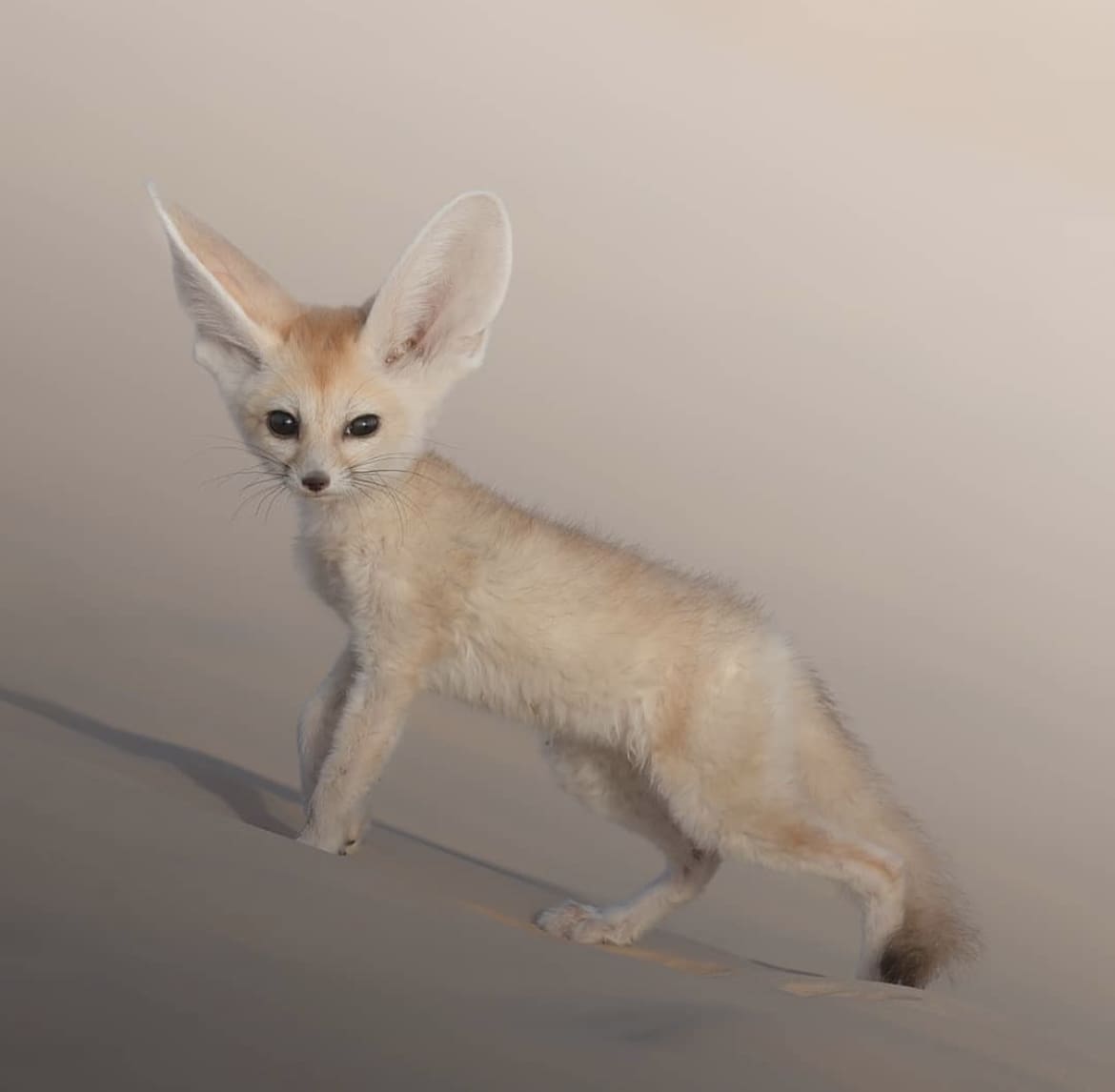
How long do Fennec Foxes live?
In the wild, the life of a Fennec Fox is fraught with challenges, from finding food to evading predators. Despite this, they have a surprisingly robust lifespan, typically living up to 10 years in the wild.
In captivity, where threats are minimized, and healthcare is provided, they can live up to 14 years. This longevity is remarkable for such small creatures, attesting to their resilience and the effectiveness of their adaptations to the desert life. It’s a testament to the saying, “tough things come in small packages,” showcasing that size isn’t always indicative of strength or the ability to endure.
Are Fennec Foxes aggressive?
Despite their wild nature, Fennec Foxes are not inherently aggressive towards humans. They are, however, wild animals, and their behavior can be unpredictable. In their natural habitat, they’re more likely to flee from danger than confront it. This cautious demeanor is a survival strategy, prioritizing escape over aggression.
However, like any animal, they can display defensive behavior if they feel threatened or cornered. In captivity, where they can become accustomed to human interaction, they generally show a docile and curious nature. But it’s essential to remember, no matter how cute and cuddly they might seem, they’re not domesticated pets and should be respected as the wild animals they are.
Are Fennec Foxes territorial?
Absolutely, Fennec Foxes take their personal space quite seriously. Despite their cute appearance, they’re not the type to share their sandbox willingly. Each pair or family group claims a territory, which they mark and defend passionately against intruders. These territories can be quite expansive, considering the need to roam for food.
However, they’re not about pointless showdowns; their primary goal is to avoid conflict by clearly marking their domain with urine and feces, a kind of “keep out” sign that’s hard to miss. This territorial behavior ensures they have enough resources to survive in their challenging environment, minimizing conflict and promoting harmony within their own group.
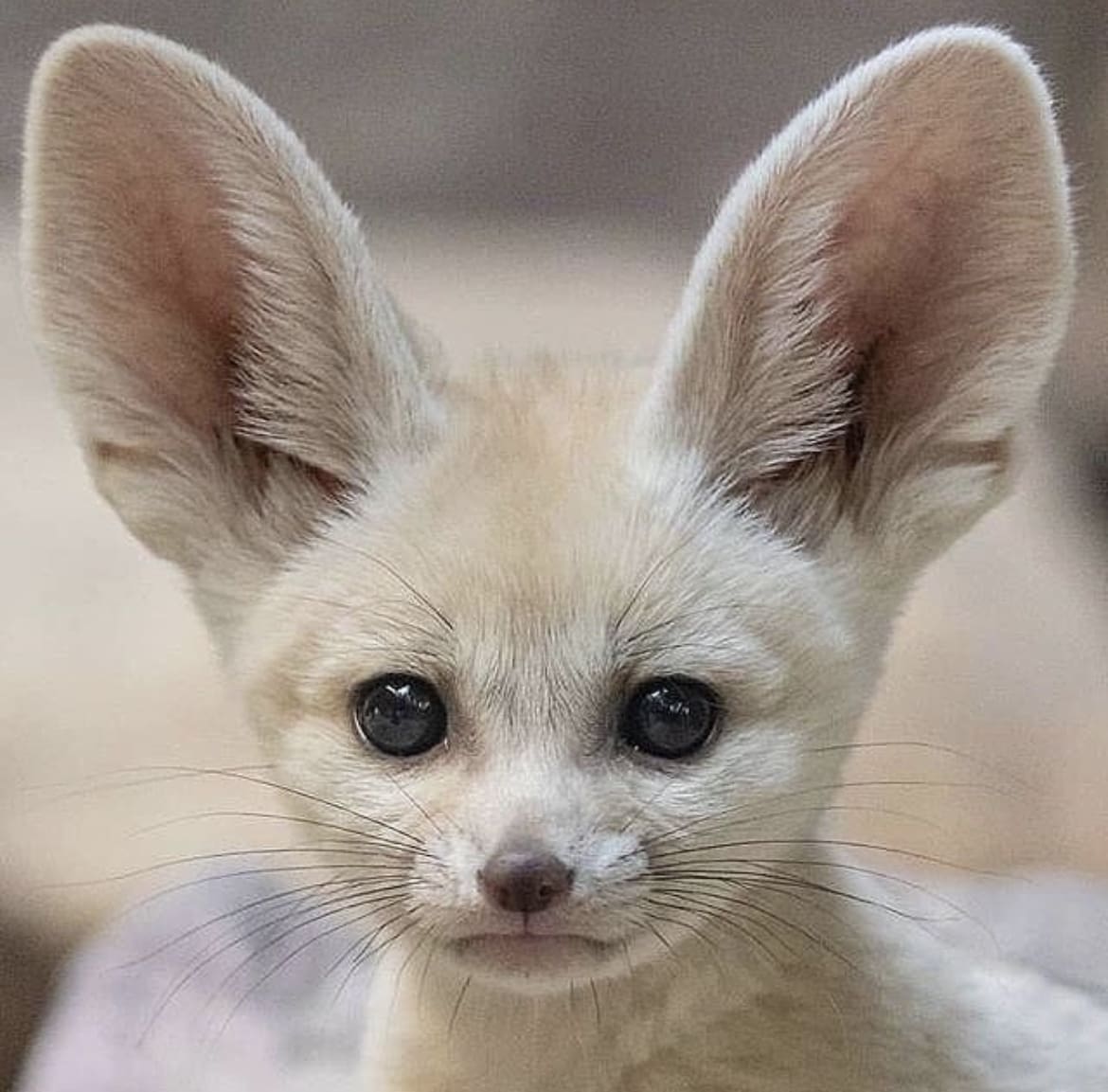
Are Fennec Foxes fast?
When it comes to speed, Fennec Foxes might not break any records, but they’re certainly no slouches. Their compact bodies are built for agility and quick bursts of speed, crucial for both catching prey and evading predators. They can dart across the sand with surprising quickness, a skill that’s especially handy when they need to make a swift retreat into the safety of their burrows.
While they might not outrun every threat, their speed and agility are perfectly suited to the twist-turns and sharp maneuvers needed in the tight spaces of their desert home.
Where do Fennec Foxes live?
Fennec Foxes are the epitome of desert dwellers. Their primary stomping grounds are the sandy Sahara and other parts of North Africa, where they’ve adapted beautifully to life in one of the harshest climates on Earth. Their homes are not the simple burrows you might imagine but intricate networks of tunnels and chambers, providing protection from predators and the extreme weather.
These dens can be quite elaborate, reflecting the social and territorial nature of these foxes. It’s here, in the vast, open desert, under the cover of night, that the Fennec Fox truly thrives, perfectly attuned to its environment with every sense sharpened for survival.
How many Fennec Foxes are there in the wild?
Quantifying the exact number of Fennec Foxes in the wild is a bit like trying to count grains of sand in the desert—it’s tricky. Their elusive nature, nocturnal habits, and vast, inhospitable habitats make accurate population assessments challenging.
However, they are currently not considered endangered, suggesting that their population, while not precisely known, is stable enough to withstand their natural environment and the threats they face. Ongoing research and conservation efforts aim to better understand their numbers and ensure their survival amidst changing desert landscapes and human encroachment.
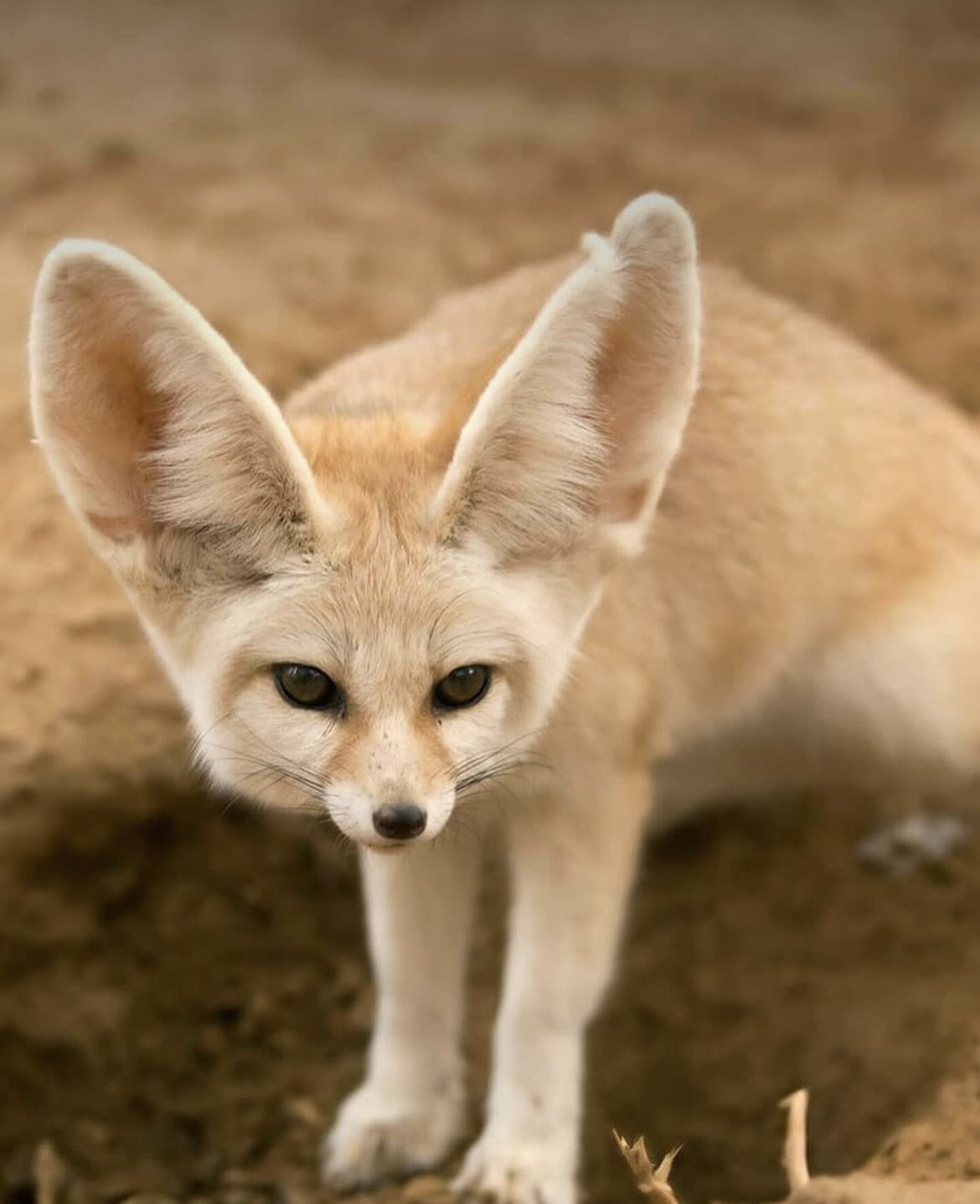
Fennec Foxes as pets
The charm of the Fennec Fox is undeniable, and it’s no surprise that some people dream of keeping them as pets. However, the reality of having a wild animal at home is far from the idyllic companionship some might imagine. Yes, they’re adorable, and yes, they can form bonds with humans, but they require specific care, diets, and environments that mimic their natural habitat.
Additionally, their nocturnal lifestyle and natural behaviors can pose challenges in a typical household setting. While legal in some places, the ethics of keeping Fennec Foxes as pets are complex, touching on issues of conservation, welfare, and the intrinsic value of wildness. It’s a debate that prompts us to reconsider our relationship with nature and the creatures we share it with.
Are Fennec Foxes endangered?
Currently, Fennec Foxes are not classified as endangered. They’re listed as “Least Concern” by the International Union for Conservation of Nature (IUCN), indicating a relatively stable population. However, this status should not lead to complacency. Habitat loss, illegal pet trade, and climate change pose ongoing threats to their survival.
Their resilience in the face of adversity is admirable, but it’s a fragile balance, dependent on both their adaptability and our willingness to mitigate the impacts of human activity on their natural environments.
Threats to Fennec Foxes in the wild
Despite their adaptability, Fennec Foxes face significant threats from both natural and human-induced changes. Habitat destruction, due to expanding agriculture and settlements, reduces their living space and food sources. The illegal wildlife trade, driven by demand for exotic pets, poses a serious risk, often resulting in poorly treated animals and disruption of natural populations.
Climate change, altering precipitation patterns and desert ecosystems, further complicates their survival. These challenges underscore the importance of conservation efforts to protect Fennec Fox habitats and regulate the pet trade.
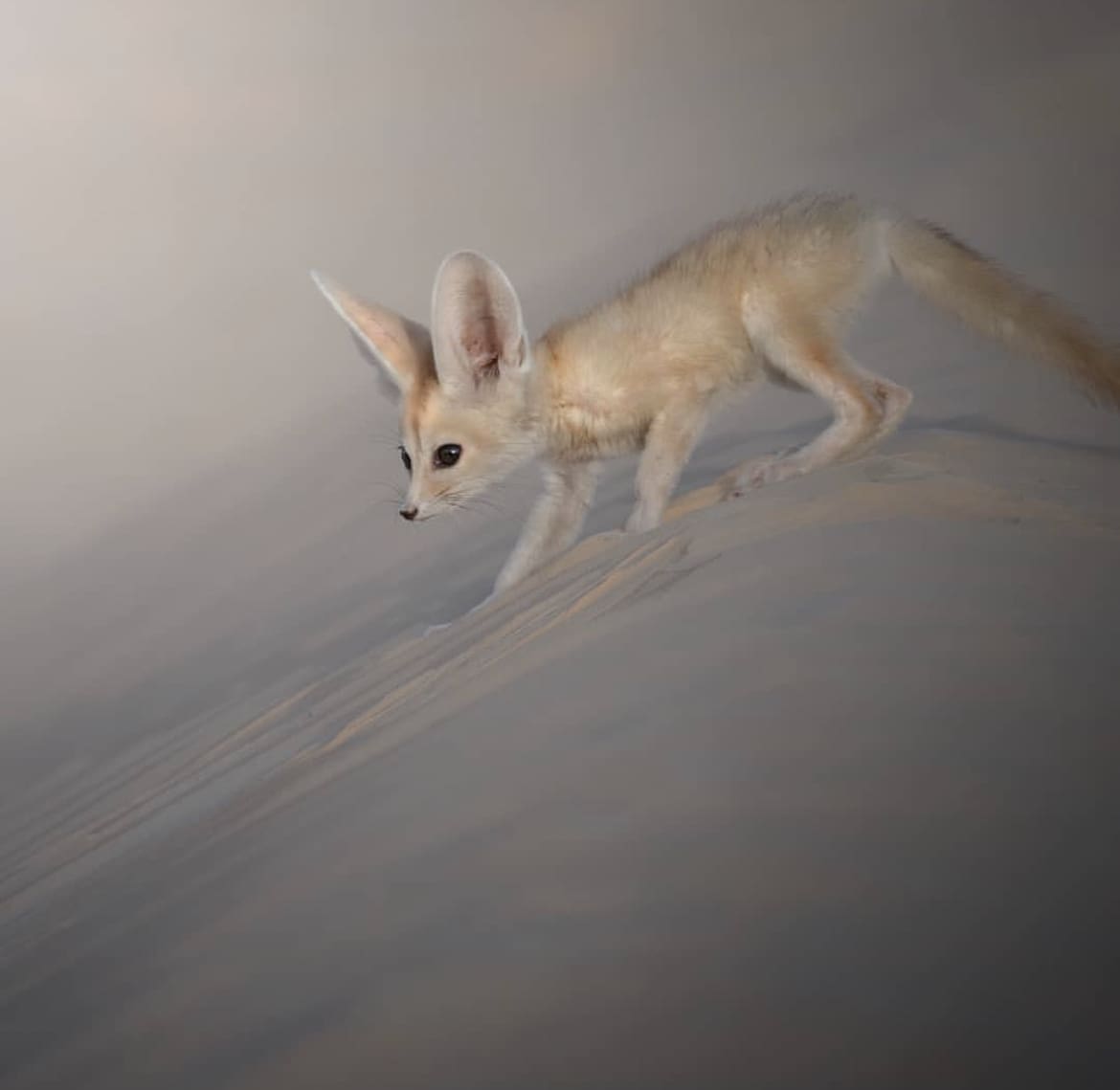
Where to see Fennec Foxes
For those yearning to witness the magic of Fennec Foxes firsthand, several locations offer a glimpse into their world. National parks and reserves in North Africa, such as the Sahara Desert, provide opportunities to observe these animals in their natural environment.
Zoos and wildlife sanctuaries around the world, committed to conservation and education, also offer a chance to see Fennec Foxes up close.
Responsible tourism and support for conservation-focused organizations can contribute to the protection of these enchanting creatures and their habitats.
Tips for spotting Fennec Foxes
Spotting a Fennec Fox in the wild requires patience, respect for nature, and a bit of luck. These nocturnal animals are best seen during the early morning or late evening. Quietly exploring areas near their dens, with minimal disturbance, increases your chances of an encounter.
Guided tours by knowledgeable locals can provide insights into their habits and preferred locations. Always maintain a respectful distance, ensuring your presence does not stress or threaten these delicate animals.
Facts about The Fennec Fox
- The Fennec Fox’s ears can be up to 6 inches long, serving both for heat dissipation and exceptional hearing.
- They have fur on the soles of their feet to protect them from the hot sand.
- Fennec Foxes can go without water for extended periods, getting most of their moisture from food.
- Their night vision is enhanced by a reflective layer behind their eyes, aiding their nocturnal lifestyle.
Myths about The Fennec Fox
- Myth : Fennec Foxes make perfect pets. Fact : They are wild animals with specific needs that can be difficult to meet in a domestic setting.
- Myth : They are silent creatures. Fact : Fennec Foxes are quite vocal, using a variety of sounds to communicate with each other.
- Myth : They can be found in deserts worldwide. Fact : Fennec Foxes are native only to the Sahara Desert and parts of North Africa.
As we conclude our journey through the life and lore of the Fennec Fox, it’s clear these creatures are as complex as they are captivating. They are not just survivors of the desert but symbols of resilience and beauty in the face of adversity.
By understanding and appreciating these remarkable animals, we can play a role in ensuring they continue to thrive in their sandy realms. The Fennec Fox, with its ethereal charm and spirited determination, invites us to marvel at the wonders of the natural world and reminds us of our responsibility to protect it.
STAY UPDATED
Join our community of keen travellers, wildlife enthusiasts and adventure seekers..

The Best Time Of Year To Visit Bordeaux, France

World’s Largest Wildlife Crossing Will Save Thousands Of Animals In California

WATCH: Lioness Teaches Her Cubs to Climb in Sabi Sands

The 15 Top Budget Hotels in Central Paris

California’s Beaches Play Host To Moonlit Fish Orgies
April 22, 2024
The Moonlit Dance of the Grunion: California's Coastal Phenomenon
Under the glow of the full or new moon, a spectacle unfolds on the sandy shores of Southern California that could rival any scene from a blockbuster movie.
Imagine a scene straight out of a marine version of Mad Max —thousands of small, silvery fish, known as grunion, hurl themselves onto the beaches in a frenzied, nocturnal ritual that is as chaotic as it is captivating.
This isn't just any animal behavior; it's the grunion run, a mating dance dictated by lunar cycles and tides, where survival and reproduction intermingle on the sand.
What is The Grunion Run?
The grunion run is one of nature's most extraordinary reproductive events, where grunion emerge en masse on select Southern California beaches. This remarkable phenomenon occurs strictly under the darkness of the new or full moon, when tides are high enough to reach the upper stretches of sandy shores.
During these nocturnal events, female grunion ride the high tides up the beach, where they proceed to dig themselves tail-first into the sand to lay their eggs. Males follow suit, wrapping themselves around the females to fertilize the eggs externally. This synchronized dance ensures that the eggs are safely nestled in the wet sand, where they incubate for about ten days. The timing is crucial; the eggs must remain undisturbed until the next set of high tides, which will facilitate the hatching process and allow the newborn grunion to be swept into the ocean.
The grunion run is unique not just for its spectacle but for the precise environmental conditions it requires. The beaches where grunion spawn are often the same stretches popular with tourists and locals for recreational activities. This overlap makes the grunion particularly vulnerable to disturbances from human activity, such as beach grooming and pollution, which can endanger both the eggs laid in the sand and the adult fish during their spawning.
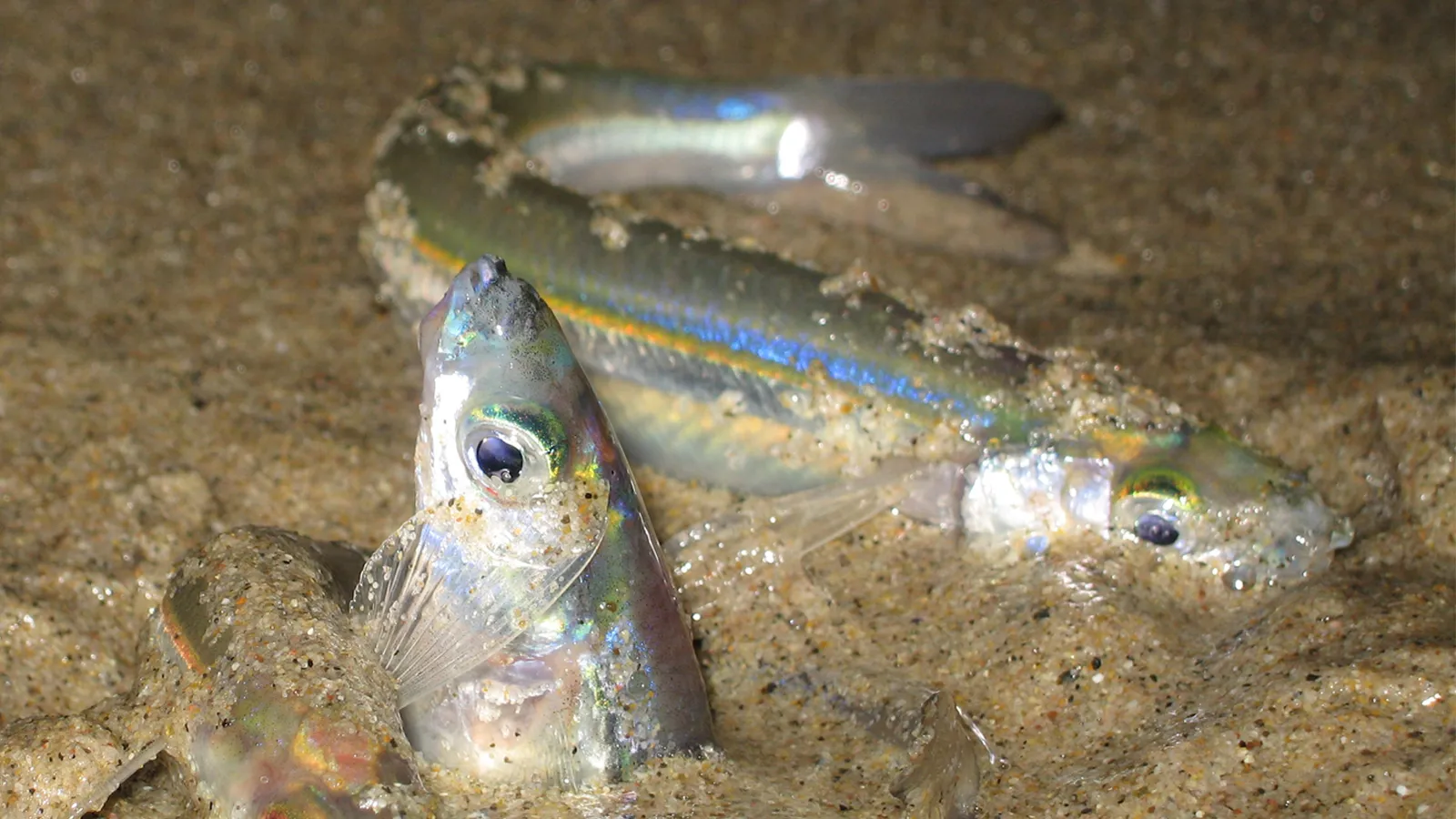
At the heart of understanding these unique creatures is a community-driven initiative led by Karen Martin, a seasoned scientist from Pepperdine University. Since 2002, over 5,000 volunteers, affectionately dubbed "grunion greeters," have played a pivotal role in gathering data about these fish at 50 designated beaches across California. Martin asserts, "We couldn't do it without them. There is no other way for us to get this kind of data. It's pretty remarkable, actually."
These citizen scientists are crucial because grunion, smart and elusive, defy traditional methods of population assessment. They dodge nets, ignore bait, and, as a result, remain somewhat of an enigma in terms of exact numbers. Their conservation status hangs in a precarious balance, underscored by a noticeable decline in their populations over the past decade due to beach erosion, light pollution, coastal development, and the indirect impacts of tourism and local activity.
Regulation and Preservation Efforts
Efforts to protect the grunion have a storied history, with initial regulations dating back to 1927 when the California Department of Fish and Wildlife first observed the grunion's vulnerability during their onshore spawning. The restrictions have evolved from banning certain fishing gear to implementing no-take seasons, extending from April through June, thanks to sustained advocacy and accumulated data from the grunion greeters.
These regulations have become more stringent over the years. For instance, in 2020, the fishing restrictions were further tightened, with limits set on how many grunion one could harvest even outside the no-take season, reflecting the growing concern over their declining numbers.
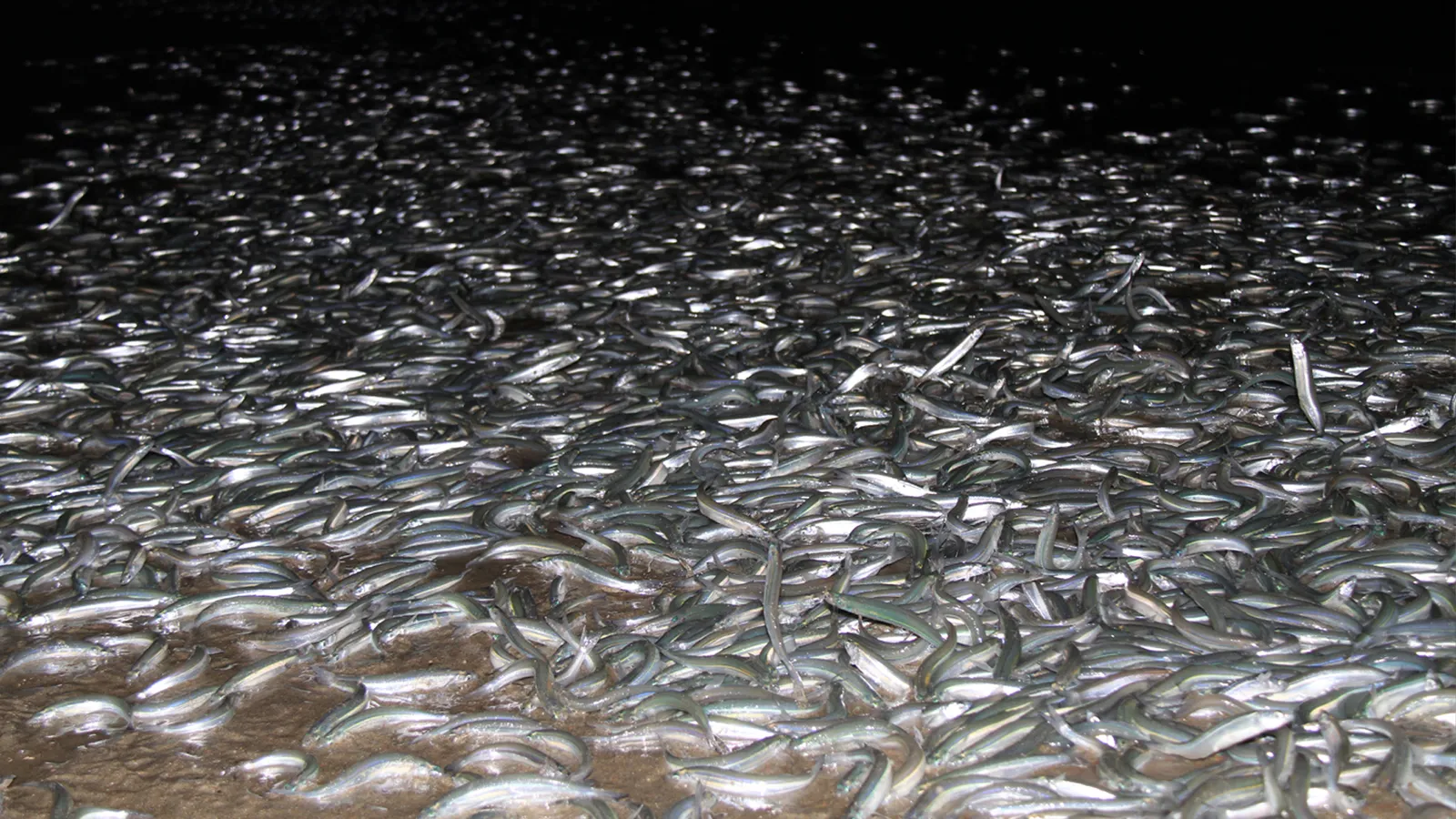
The Ripple Effect of Citizen Science
The data collected by the grunion greeters has not only informed regulatory changes but also fostered a broader awareness and appreciation for these marine creatures. The community's involvement has turned local residents into staunch defenders of the grunion, often educating others about the importance of adherence to the fishing regulations.
Karen Martin reflects on the transformation in perception towards citizen scientists, from skepticism to a valued partnership. "People are excited to know that they've made this sighting and that their knowledge is useful—that somebody cares about what they've seen," she says. This shift signifies a deeper societal connection to local wildlife and ecosystems, proving that community involvement in scientific endeavors can yield substantial environmental stewardship.
A Dance Worth Preserving
The grunion run is more than just a biological curiosity; it's a testament to the intricate ties between lunar cycles, marine life, and human interaction. As Southern California continues to grapple with the challenges of conservation and urban development, the fate of the grunion underscores the broader dialogue about our role in safeguarding not only these spectacular fish but also the delicate balance of the ecosystems they inhabit.
In essence, the dance of the grunion is a call to action—a reminder of the beauty and fragility of nature and our enduring responsibility to protect it. As we look towards the future, the ongoing collaboration between scientists, citizen volunteers, and policymakers will be crucial in ensuring that the grunion runs continue to enchant and educate future generations.
Source: BBC / Cover Image: Karen Martin
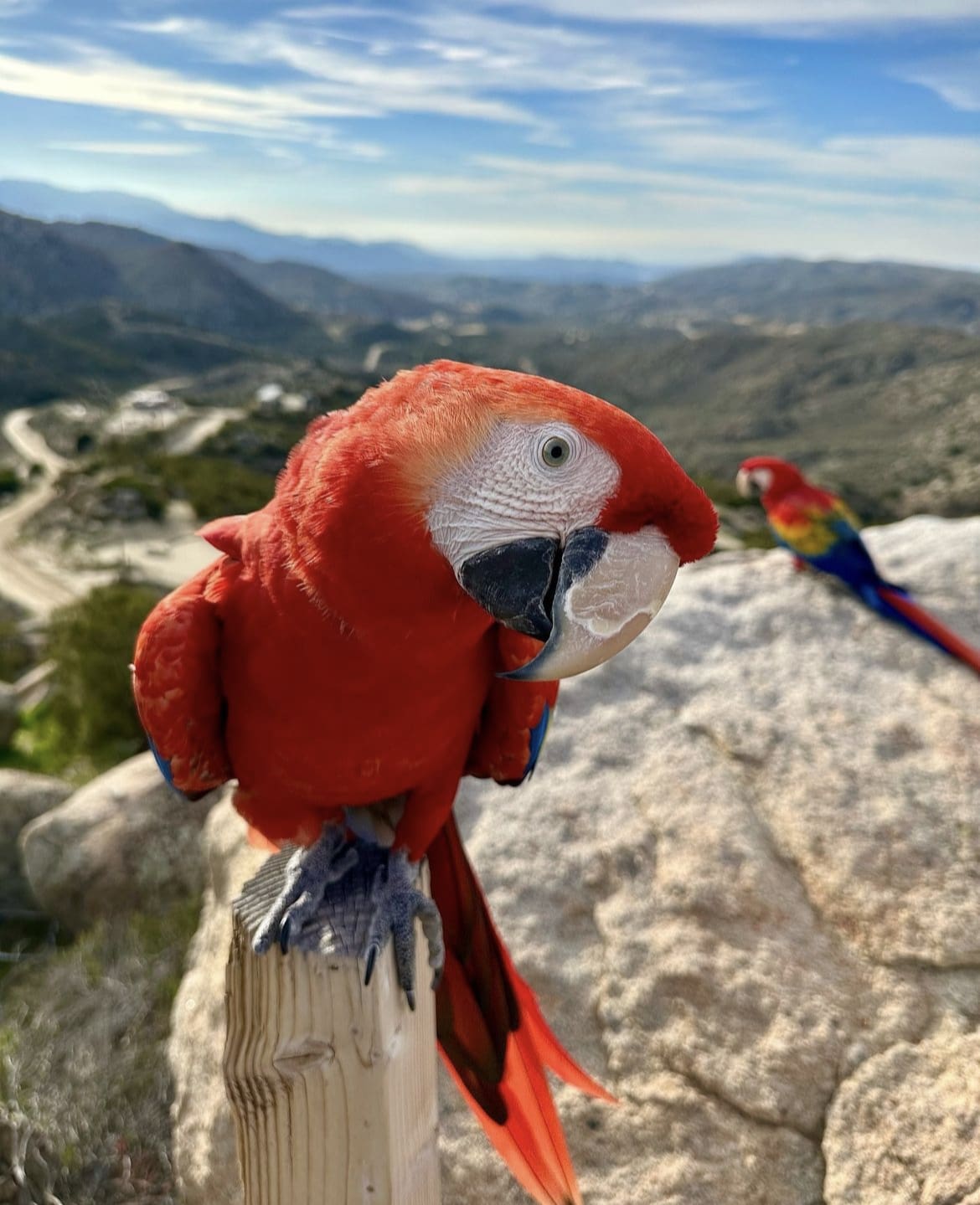
Get To Know The Macaw
April 19, 2024
Get to Know the Macaw: Facts, Myths and Photos
Ever marvel at the vibrance of a rainbow? Now, imagine that splashed across a lively creature with a personality as colorful as its feathers. Welcome to the world of macaws, those eye-popping birds that seem to have leaped straight out of a vivid dream into our reality.
These members of the parrot family are not just a feast for the eyes; they're intelligent, social, and full of quirks.
Stick around as we dive deep into what makes macaws truly spectacular—from their flamboyant feathers to their complex social lives. Ready to get up close and personal with nature’s own winged rainbows? Let’s fly right in!
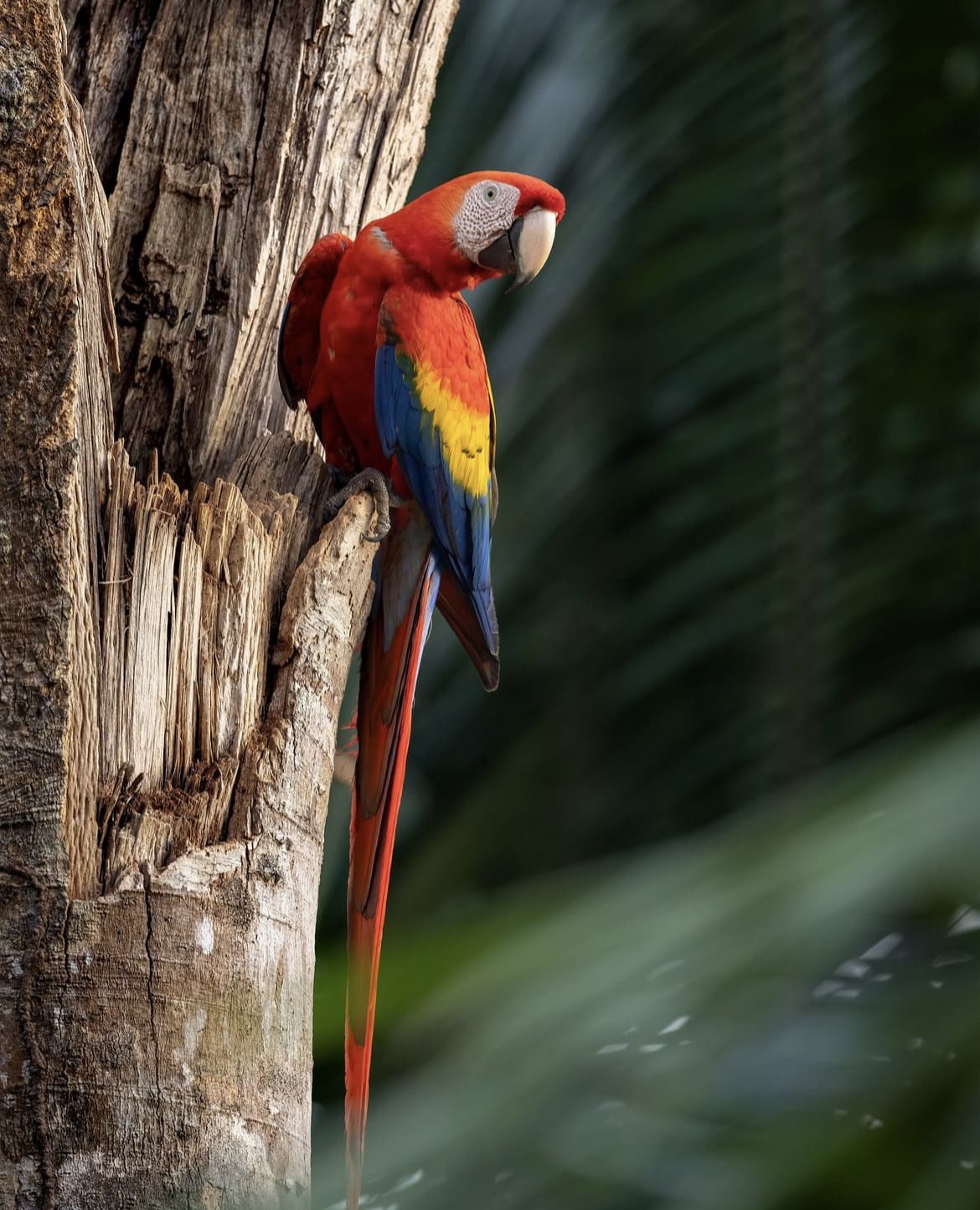
What is the Macaw?
So, what exactly is a macaw? In the simplest terms, it's a type of parrot—a really large, really colorful parrot. But not just any parrot; macaws are like the celebrities of the parrot world, known for their striking colors and impressive size. These birds belong to the family Psittacidae , which includes all parrots, and they're predominantly found in Central and South America. The macaw family is pretty diverse, with about 19 species making up the group. Each species brings its own flair to the macaw lineup, ranging from the giant Hyacinth Macaw, stretching over three feet in length, to the more petite Hahn's macaw, which is just a fraction of the size.
Biologists and bird lovers get geeky about macaws not just because of their looks but because of their brains. These birds are known for their high intelligence and remarkable ability to mimic human speech, which makes them both fascinating and a bit of a handful as pets. They're deeply social creatures, which might explain their complex behaviors and why they seem so attuned to human emotions.
What do Macaws look like?
Imagine a bird that decided to wear the entire spectrum on its wings. Macaws are exactly that—bold and beautiful, with feathers that can make just about anyone’s jaw drop. They sport a range of colors, often vivid blues, reds, and yellows, which can vary widely between species. For instance, the Blue and Gold Macaw has a stunning azure back with a golden underbelly, while the Scarlet Macaw flaunts a brilliant red plumage with blue and yellow highlights.
But macaws aren't just about pretty faces (or feathers, in this case). They have large, curved beaks that seem almost oversized for their faces but are perfect for cracking nuts and seeds. Their beaks are as functional as they are symbolic, representing the adaptability and survival skills of these birds in the wild. Speaking of functionality, let's not overlook their eyes—sharp and penetrating, they reflect a keen intelligence that complements their striking looks.
Visual diversity is key among macaws, with each species having its own unique patterns and color blends. This not only makes them a subject of endless admiration but also an interesting topic for those keen on genetics and the environmental factors that influence avian aesthetics.
How Big are Macaws?
When it comes to size, macaws really stretch the spectrum. These birds are generally recognized as some of the largest members of the parrot family. The smallest species, like the Noble Macaw, might only reach about 12 inches in length, which is pretty petite for a parrot. On the other end of the scale, you've got the majestic Hyacinth Macaw, which can stretch up to 40 inches from beak to tail tip. That’s longer than some dogs!
A key thing to remember with macaws is that their size isn’t just for show. It plays a crucial role in their survival. Larger macaws, with their powerful wings and sturdy bodies, can travel long distances in search of food, mates, or nesting sites, which is essential in the vast habitats they occupy. So, when you see a macaw spreading its wings, it’s not just a beautiful sight—it’s a glimpse into a lifestyle crafted by nature to thrive in the wild.
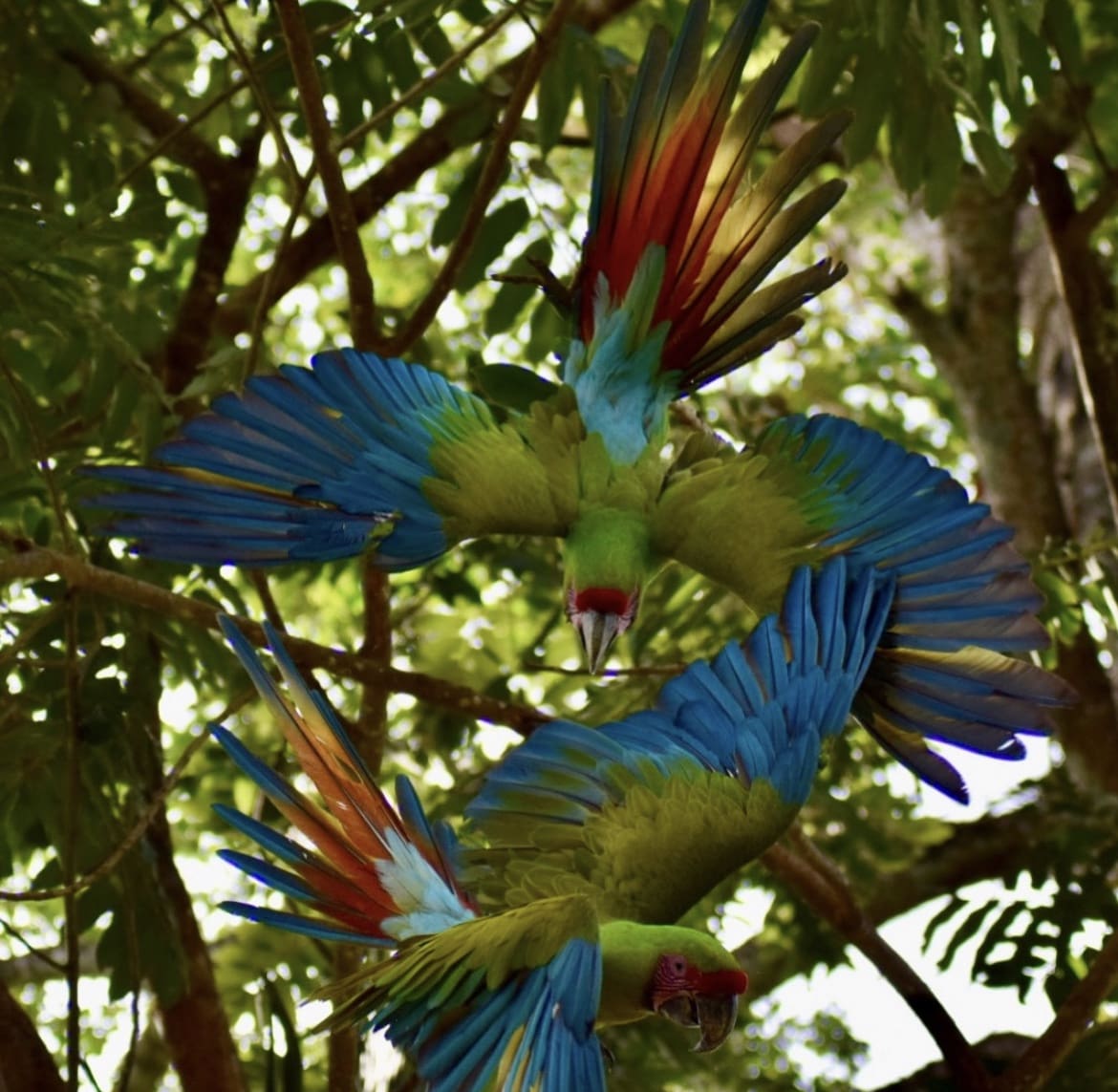
Macaw Feathers and Colors
Ah, the colors! If there’s one thing you can’t ignore about macaws, it’s their stunning plumage. These birds are the living embodiment of a painter’s palette. Each species flaunts a unique blend of vibrant feathers that aren't just about beauty—they serve some pretty practical purposes too.
For starters, the bright colors help macaws communicate. In the dense rainforests they call home, these colors can be a major advantage for social interactions like attracting mates or warding off rivals. And let's not forget camouflage. Yes, those bright blues and greens can actually blend in well with the lush foliage and shadowy light of the rainforest, helping them stay hidden from predators.
The feather quality of macaws is also top-notch. These are tough, glossy feathers that can withstand the wear and tear of rainforest life. Plus, they’re waterproof, which is handy for a bird that lives in some of the wettest environments on earth.
Now, the beak—macaws' multi-tool. It’s not just there to make them look serious; it’s essential for their survival. The strong, curved beak of a macaw is a perfect example of nature’s engineering. It can crack open hard nuts and seeds, which make up a significant part of their diet, and it's delicate enough to handle softer fruits and berries.
But the macaw’s beak is more than just a nutcracker. It’s a climbing aid as well. These birds use their beaks to help them climb and hang from branches, almost like an extra limb. Imagine trying to scale a tree without hands, and you’ll get a sense of how ingenious this adaptation really is.
It’s fascinating to see how macaws use their beaks to interact with their environment, from feeding and climbing to grooming and even playing. Observing a macaw in action, using its beak to explore and manipulate objects, really highlights their curious and intelligent nature.
Macaw Claws
When you think about macaws, their claws might not be the first feature that springs to mind, but these tools are just as crucial as their beaks. Each macaw is equipped with four strong, sharp claws, arranged in a zygodactyl pattern—two toes pointing forward and two backward. This special arrangement is perfect for a lifestyle spent mostly among the trees.
Macaw claws are all about grip. Whether it’s clinging to a vertical tree trunk, hanging upside down to reach a tantalizing fruit, or simply perching securely as they sleep, these claws make it all possible. Their ability to grasp and hold is vital not only for feeding and mobility but also for interacting with other macaws and their environment.
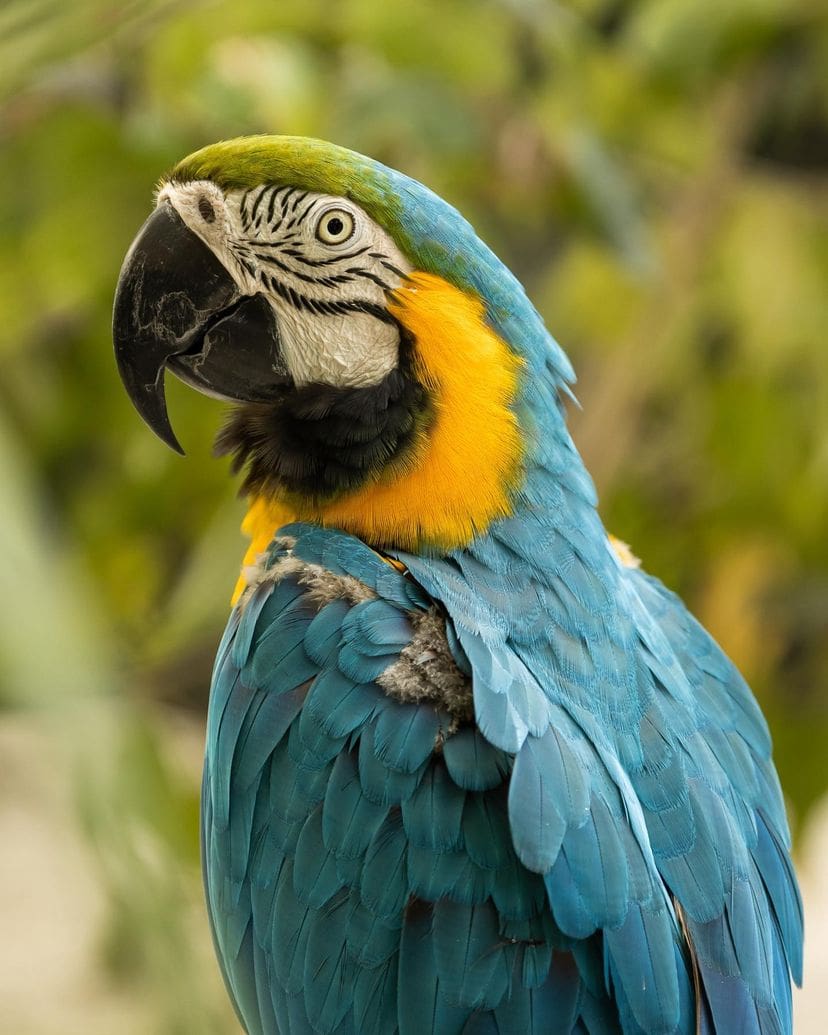
The tail of a macaw isn’t just a trailing feather arrangement; it's a critical balance tool and a striking visual display. Long and pointed, macaw tails can often be nearly as long as the rest of their body. In flight, these tails are magnificent rudders, helping the birds steer and maneuver through their dense forest habitats with agility and grace.
On top of their functional importance, macaw tails add to the visual spectacle of the birds. During courtship displays, macaws will fan out their tails, showing off the brilliant colors and patterns to potential mates. The tail feathers, often a different color from the body, add an extra layer of allure to these already captivating creatures.
What Do Macaws Eat?
Diving into a macaw's diet is like exploring a tropical buffet. These birds are primarily herbivores, and they have quite the varied palate. Their diet mainly consists of nuts, fruits, and seeds, which they skillfully extract and consume using their powerful beaks. But macaws are also known to enjoy the occasional leaf, flower, and even insect or small reptile, adding some protein to their colorful diet.
Macaws have a particularly interesting relationship with "clay licks," natural riverbanks where the soil is rich in minerals. These birds will often gather in large numbers to eat the clay, which helps them detoxify any poisonous substances they might have ingested from unripe seeds or toxic fruits. This not only highlights their dietary diversity but also their remarkable adaptability to their environment.
The diet of a macaw can vary widely depending on the species and their natural habitat. For instance, the Scarlet Macaw might have a different dietary preference than the Blue and Gold Macaw, reflecting the ecological diversity of their respective environments.
Macaw Social Structure
Macaws are anything but loners; these birds are the social butterflies of the avian world. Typically, macaws live in flocks that can number from a few pairs to hundreds of birds, especially in popular feeding areas or at clay licks. This social arrangement helps them protect each other from predators and increases their efficiency in finding food.
The structure within a macaw flock is quite sophisticated. While they are communal and cooperative, there’s also a clear hierarchy, often determined by age, size, and temperament. Within the flock, macaws pair off into monogamous relationships that can last a lifetime. These pairs are rarely seen apart, whether they are foraging, flying, or resting. The bond between mated macaws is strong, characterized by mutual grooming and shared food, which helps strengthen their relationship and ensures cooperative parenting.
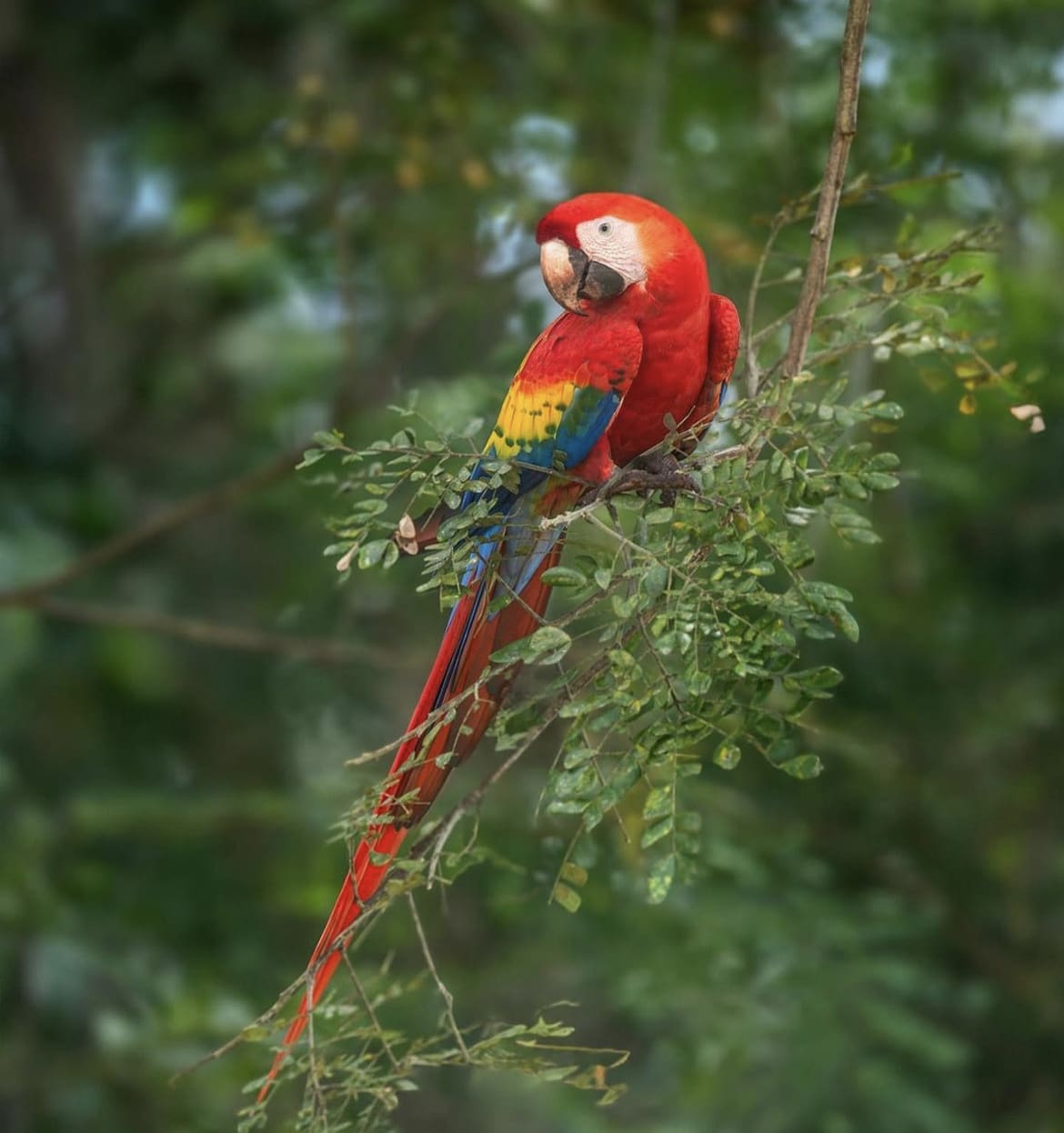
How do Macaws Reproduce?
Speaking of parenting, let's dive into the reproductive life of macaws. These birds don't start breeding until they are quite mature, often not until they are several years old. Once they form a pair, macaws are monogamous and will typically mate for life, which is a rarity in the animal kingdom.
The breeding season for macaws is usually aligned with the rainy season, when food is most abundant. This timing ensures that there are plenty of resources available for the demanding task of chick rearing. The female lays between two to four eggs per clutch, which she incubates for about 24 to 28 days. During this time, the male takes on the role of the protector and provider, bringing food to the nest and standing guard against any threats.
Macaw nests are typically found high up in the cavities of dead or dying trees. This elevated location helps protect the eggs and young chicks from ground-level predators. Once hatched, the chicks are entirely dependent on their parents for food and protection for up to three months, a period during which the parents are exceptionally attentive and busy.
How Long Do Macaws Live?
Macaws are among the longer-lived bird species, with lifespans that can extend well beyond 50 years in captivity. In the wild, however, their lifespan is usually shorter, often due to environmental pressures, disease, and predation, but it's not uncommon for a macaw to reach 30 to 35 years of age.
The longevity of macaws in captivity highlights the importance of long-term commitment when considering these birds as pets. Their extended lifespan also allows them to form lasting bonds with their human caregivers, often becoming a lifetime companion. The challenge, however, lies in ensuring that they receive appropriate mental and physical stimulation throughout their lives, as boredom and isolation can lead to behavioral issues in these intelligent creatures.
READ NEXT: GET TO KNOW THE AFRICAN FISH EAGLE
Are macaws territorial.
Macaws, with their sociable nature, may not seem the type to defend turf aggressively, but they do exhibit territorial behaviors, particularly around their nesting sites. During the breeding season, macaws can become quite protective of the area surrounding their nest. This territoriality ensures that they have enough space and resources to successfully raise their chicks.
Outside of the breeding season, macaws tend to be more gregarious and less concerned with territory, often seen mingling freely with other birds at communal feeding sites or clay licks. This adaptability in their social behavior highlights their intelligence and complex social dynamics, where the need for community often outweighs the instinct for territorial defense.
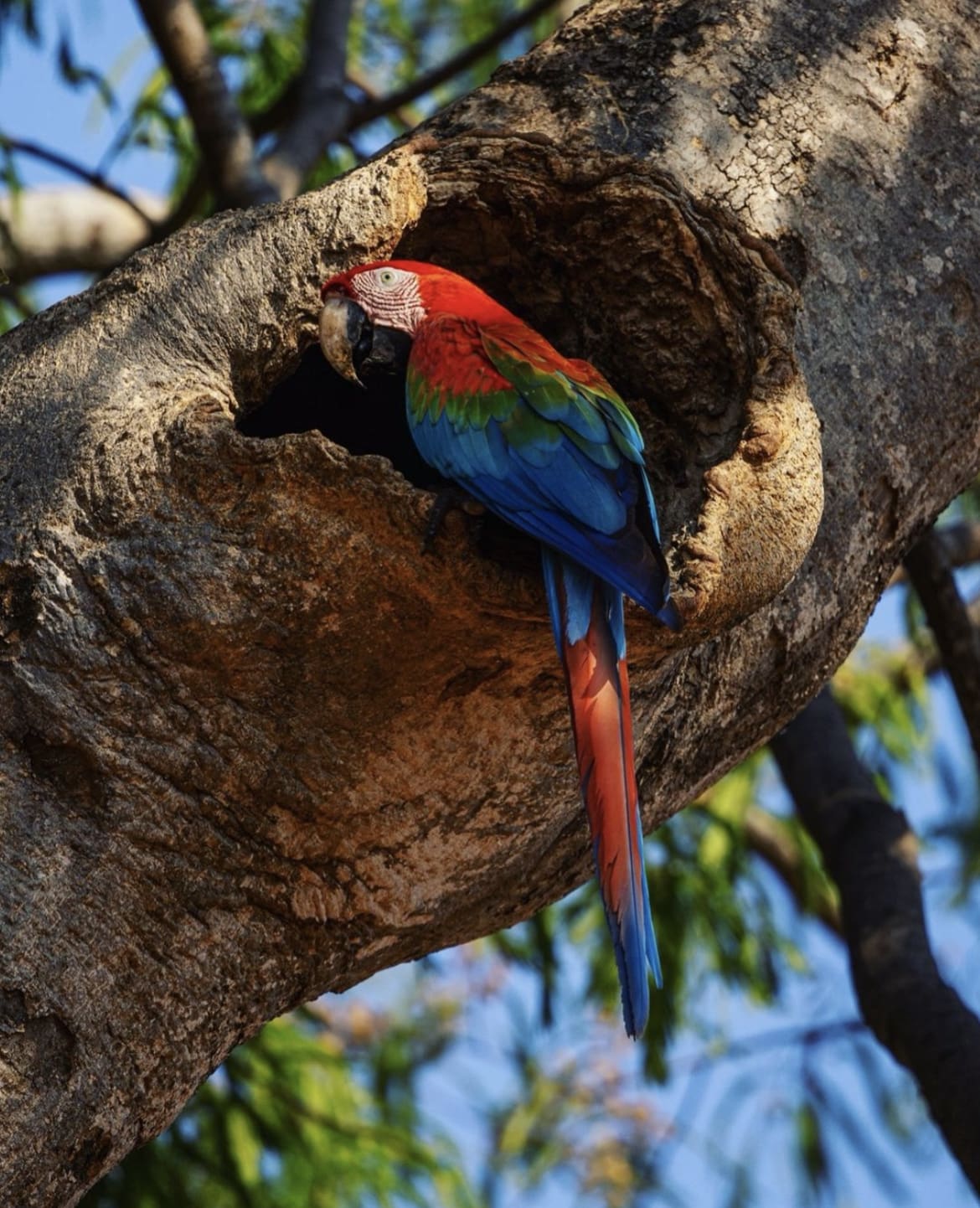
How Fast are Macaws?
When it comes to speed, macaws are no slouches. These birds are built for flying through the challenging landscapes of dense rainforests or open skies above the canopy. While exact speeds vary by species, macaws can reach flying speeds of up to 35 miles per hour. This swiftness allows them to travel long distances in search of food, mates, or new nesting sites, a necessity in the expansive habitats they occupy.
Macaws use their speed not just for efficient travel but also as a tactic to evade predators. Their agile flight, combined with bright, confusing color patterns, makes them a challenging target for would-be attackers. Additionally, their loud calls, which can be heard over long distances, help keep flock members in contact even when flying at high speeds.
Where do Macaws Live?
Macaws are native to a variety of habitats across Central and South America, with a range that spans from the dense Amazon rainforest to the drier savannah regions. These diverse environments influence the specific adaptations and behaviors of different macaw species. For example, while some macaws, like the Scarlet Macaw, thrive in humid, tropical rainforests, others, such as the Blue-throated Macaw, are found in more arid woodland areas.
The habitat of a macaw affects everything from its diet and social behavior to its reproductive strategies. Rainforest-dwelling macaws often benefit from a constant supply of various fruits and nuts, while those in drier areas might rely more on specific seasonal resources. This ecological diversity is crucial for the survival of different macaw species, allowing them to specialize and thrive in various environmental conditions.
How Many Macaws are There in the Wild?
Estimating the exact number of macaws in the wild can be challenging due to their wide distribution and the often inaccessible nature of their habitats. However, it's clear that the populations of many macaw species are under threat. The primary reasons include habitat loss, illegal pet trade, and environmental degradation. Species like the Spix's Macaw have seen populations plummet to the point of being declared extinct in the wild, only surviving due to intensive conservation and breeding programs.
For species that are still found in the wild, such as the Blue and Gold Macaw or the Scarlet Macaw, conservation efforts are crucial to maintaining their numbers. These efforts include habitat preservation, anti-poaching measures, and education campaigns aimed at local communities and potential pet buyers globally. While some macaw species maintain stable populations in large protected areas, others are rare and face ongoing risks from human activity.
Are Macaws Endangered?
Many macaw species are indeed listed as endangered or threatened by the International Union for Conservation of Nature (IUCN). The varying degrees of threat depend largely on their habitat conditions and the impact of human activity. For instance, the Hyacinth Macaw is considered vulnerable due to its specific habitat needs and the illegal trade of exotic pets.
Conservation status not only highlights the risk these birds face but also the global responsibility to ensure their survival. International cooperation is needed, along with strict enforcement of wildlife trade laws and significant efforts to restore and protect macaw habitats. Thankfully, there are numerous success stories where conservation initiatives have stabilized or even increased macaw populations, showing that with concerted effort, positive change is possible.
Threats to Macaws in the Wild
The beautiful plumage and engaging personalities of macaws that make them so beloved are unfortunately also the reasons they are under threat. The illegal pet trade has a devastating impact on wild populations, as juvenile birds are often captured and sold on the black market. This not only reduces the number of individuals in the wild but also disrupts the social structure of macaw flocks, which can have broader ecological consequences.
Habitat destruction is another significant threat. As forests are cleared for agriculture or mining, macaws lose both their homes and their food sources. Climate change further exacerbates these challenges, altering the ecosystems macaws depend on for survival. Pollution, especially in the form of pesticides and heavy metals, can also poison these birds or their food supplies, leading to decreased fertility and higher mortality rates.
Where to See Macaws
If you're keen on seeing macaws in their natural habitat, there are several destinations where these magnificent birds can still be found flying freely. The Amazon rainforest across countries like Brazil, Peru, and Colombia offers vast tracts of untouched forests that are home to numerous macaw species. National parks and wildlife reserves often provide the best chances of sightings, with guided tours that help spot these colorful birds in the canopy.
Another excellent location is Costa Rica, particularly in areas like Corcovado National Park, where Scarlet Macaws are a common sight. Similarly, the Pantanal in Brazil is known for its large populations of Hyacinth Macaws, especially near conservation areas dedicated to this species. These trips not only offer the chance to see macaws but also support eco-tourism, which plays a crucial role in their conservation.
Tips for Spotting Macaws
Spotting macaws, while exciting, can be challenging due to their often elusive nature and the dense habitats they prefer. Here are some tips to increase your chances of a memorable encounter:
- Early Morning or Late Afternoon : Macaws are most active during these times, making them easier to spot as they feed and socialize.
- Listen for Their Calls : Macaws are noisy creatures. Their loud calls can help you locate them even before they are visible.
- Use Binoculars : A good pair of binoculars is essential to get a clear view of these birds as they often stay high in the treetops.
- Stay Near Fruit Trees : Macaws often visit specific trees that bear fruit, so these spots can be excellent for sightings.
- Be Patient : Like any wildlife spotting, seeing macaws requires patience. They are wild animals with their own routines and timetables.
Facts About the Macaw
- Macaws can eat some toxic seeds and unripe fruits that are harmful to other animals because clay from clay licks helps neutralize the toxins.
- The largest macaw species is the Hyacinth Macaw, which can grow up to 40 inches in length.
- Macaws have a strong sense of community, often seen preening each other, which helps strengthen their social bonds.
- They are known for their incredible memory, which is essential for recalling the locations of fruiting trees throughout their vast territory.
- Macaws can fly up to 35 miles per hour, using their powerful wings to navigate through and above the rainforest canopy.
Myths About the Macaw
- Myth : Macaws can talk like humans. Fact : While they can mimic human speech, they do not understand or communicate in human languages.
- Myth : All macaws are colorful. Fact : While most are vividly colored, some species have more subdued hues to blend into their environments better.
- Myth : Macaws live only in rainforests. Fact : Macaws inhabit a range of environments from rainforests to savannahs, depending on the species.
- Myth : Macaws eat only fruits. Fact : Their diet is diverse, including nuts, seeds, leaves, and occasionally insects and small animals.
Macaws are not just birds; they are a spectacular display of nature's brilliance, with their vivid colors, complex behaviors, and fascinating ecological roles. As we continue to encroach on their habitats, the responsibility to protect these magnificent creatures grows.
By supporting conservation efforts and responsible eco-tourism, we can help ensure that macaws continue to thrive in the wild. Witnessing a macaw in its natural setting is more than just a sighting; it’s an encounter with one of the planet’s most extraordinary creations, reminding us of the beauty and fragility of the world we share.
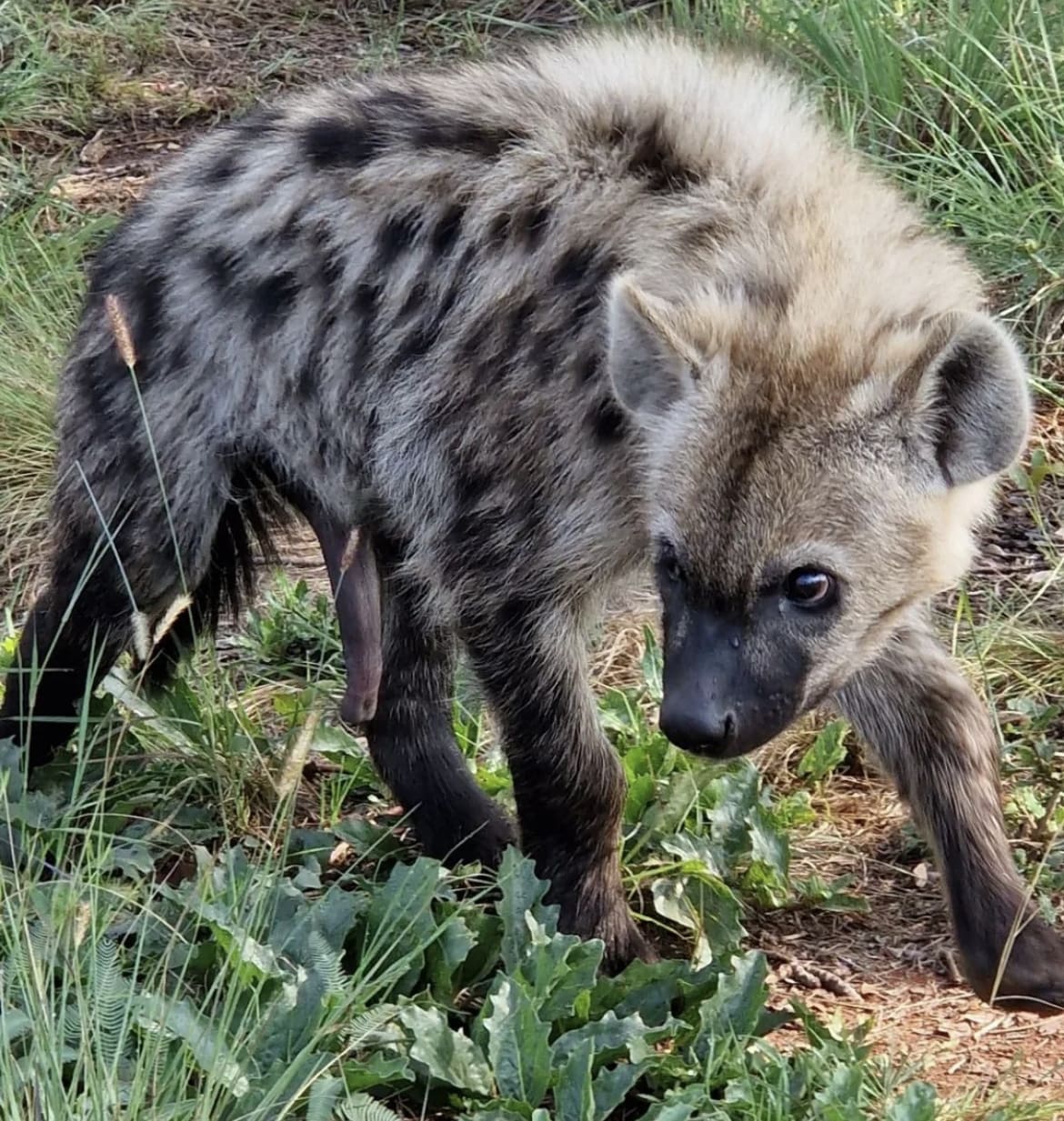
Hyena Pseudopenis: Why Do Female Spotted Hyenas Have a Fake Penis?
The spotted hyena is a creature that's as enigmatic as it is misunderstood. They challenge the very foundations of gender roles in nature.
While these animals often get a bad rap in movies and folklore, they harbor one of the most fascinating biological secrets of the animal kingdom: the female sports what appears to be a penis. Yes, you read that right—a pseudopenis! This article isn't just a dive into one of nature's oddities; it’s an exploration into the evolutionary marvels that drive the complex lives of these fierce creatures.
Why do female hyenas have this unusual organ? What does it mean for their survival and social standing in the wild? In the coming sections, we'll unpack the anatomy of the pseudopenis, explore the theories behind its evolution, and see how it influences everything from mating to social dynamics.
Whether you're a wildlife enthusiast, a curious biologist, or just someone who loves a good nature mystery, stick around. You're about to discover why the female spotted hyena's reproductive anatomy is a game-changer in our understanding of evolutionary biology. Let's demystify the reasons behind the pseudopenis and delve into its implications on the social structure of these captivating animals.
What Exactly is a Pseudopenis?
To understand why female spotted hyenas are so unique, let's first delve into what a pseudopenis actually is. Essentially, it’s an enlarged clitoris that closely resembles the male penis, both in appearance and function.
This organ is capable of erecting and is used by females not only for urination but also for mating and giving birth. Yes, the complexities of hyena birth through such a structure are as challenging as they sound, which naturally raises the question of why such an anatomy exists in the first place.
The pseudopenis is complete with a false scrotum, which is actually the female's enlarged labia fused together. These features are not superficially male; they play an integral role in the female hyena's life, from social interactions to the reproductive process.
The anatomical structure is such that it gives female hyenas a distinctly masculine appearance, blurring the lines of gender roles within the animal kingdom. This phenomenon is not only rare but unique to spotted hyenas, setting them apart in the world of mammals.
READ NEXT: THE 10 DEADLIEST ANIMALS IN AFRICA
The evolution behind the masquerade.
Why would evolution favor the development of such a peculiar trait as the pseudopenis in female spotted hyenas? Theories abound, but most revolve around the idea of survival and social advantage. One prevalent theory suggests that high levels of androgen (a type of male hormone) exposure in utero could be responsible. This hormonal influence not only develops the pseudopenis but also contributes to the aggressive nature of female hyenas, giving them a significant edge in their matriarchal societies.
This adaptation could be seen as nature’s way of leveling the playing field. In the harsh environments where hyenas thrive, every member of the clan needs to be tough and competitive to survive. The females, often larger and more dominant than males, control mating and make key decisions for their clans. Their masculinized anatomy might be nature's strategy to ensure that female hyenas hold their own in this aggressive environment, handling both the roles of caregiver and leader effectively.
Moreover, the pseudopenis might serve as a natural deterrent against unwanted mating attempts. Only the most determined and fit males can navigate the complex mating process, which involves careful alignment and cooperation from the female. This ensures that only the strongest genes are passed down to offspring, a critical factor in the harsh reality of their ecosystem.
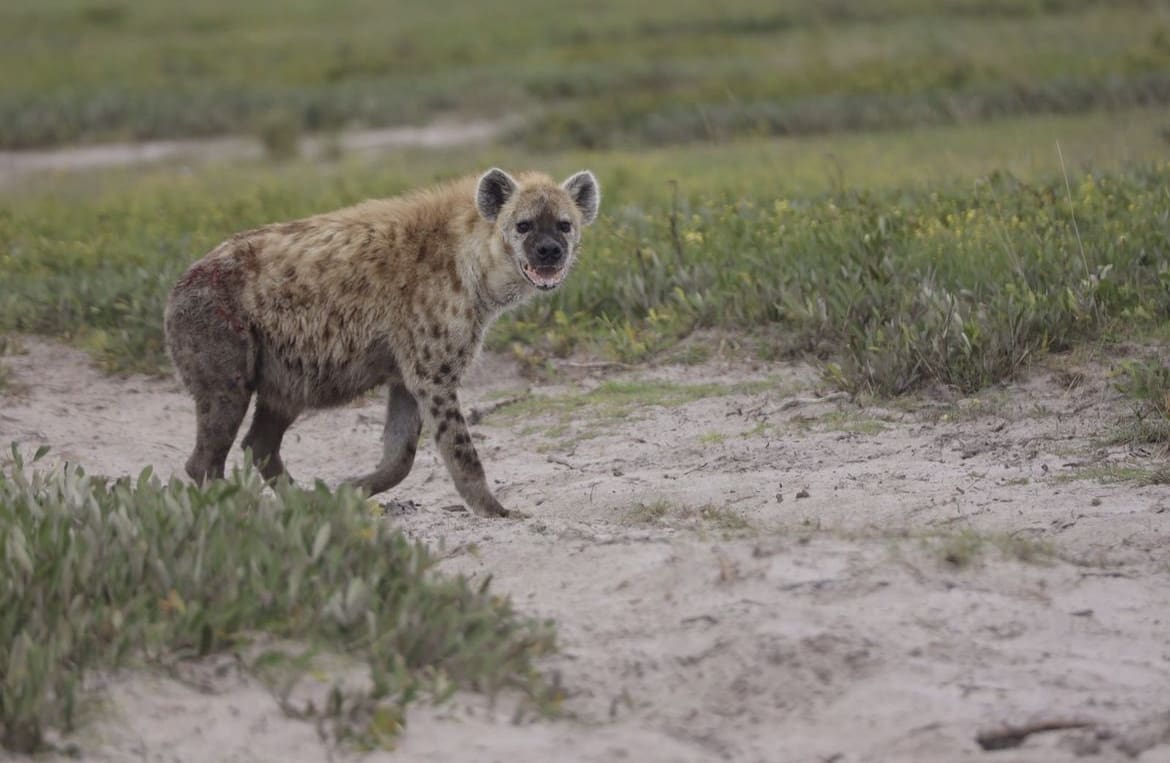
Reproduction and Mating
The mating rituals of spotted hyenas are as unconventional as their anatomy. To mate, a male hyena must be exceptionally patient and precise, as he has to navigate the female's pseudopenis. This process is not only physically demanding but requires a high level of cooperation from the female, who must invert her pseudopenis to allow copulatio n—a feat that seems almost acrobatic in nature. This unique mating system naturally complicates reproduction, but it also plays a crucial role in the social structure of hyena clans.
Due to the complexity and difficulty of the mating process, mating opportunities are less frequent and more selective in spotted hyenas than in many other mammals. This selectivity strengthens the social bonds within clans and ensures that only the most adept males reproduce, thereby enhancing the genetic quality of offspring. The female's control over mating further solidifies her dominant role within the clan, enhancing the matriarchal system that characterizes their social structure.
Additionally, the birth process through the pseudopenis presents significant challenges and risks. The birth canal of the pseudopenis is only slightly larger than the cubs she bears, often resulting in a laborious and dangerous delivery. This high-risk birthing process has profound implications for cub survival rates and the overall fitness of the species, influencing everything from individual health to population dynamics.
To lighten the mood in what might otherwise be a heavy read, it's worth noting some humorous yet true myth-busting about hyenas: No, they don't laugh because they find something funny. Their famous "laugh" is actually a form of communication used to express excitement and frustration, often during feeding or when a cub is in distress during the challenging birth process.
This fascinating blend of complex behaviors and biological adaptations makes the spotted hyena a creature as intriguing as it is formidable.
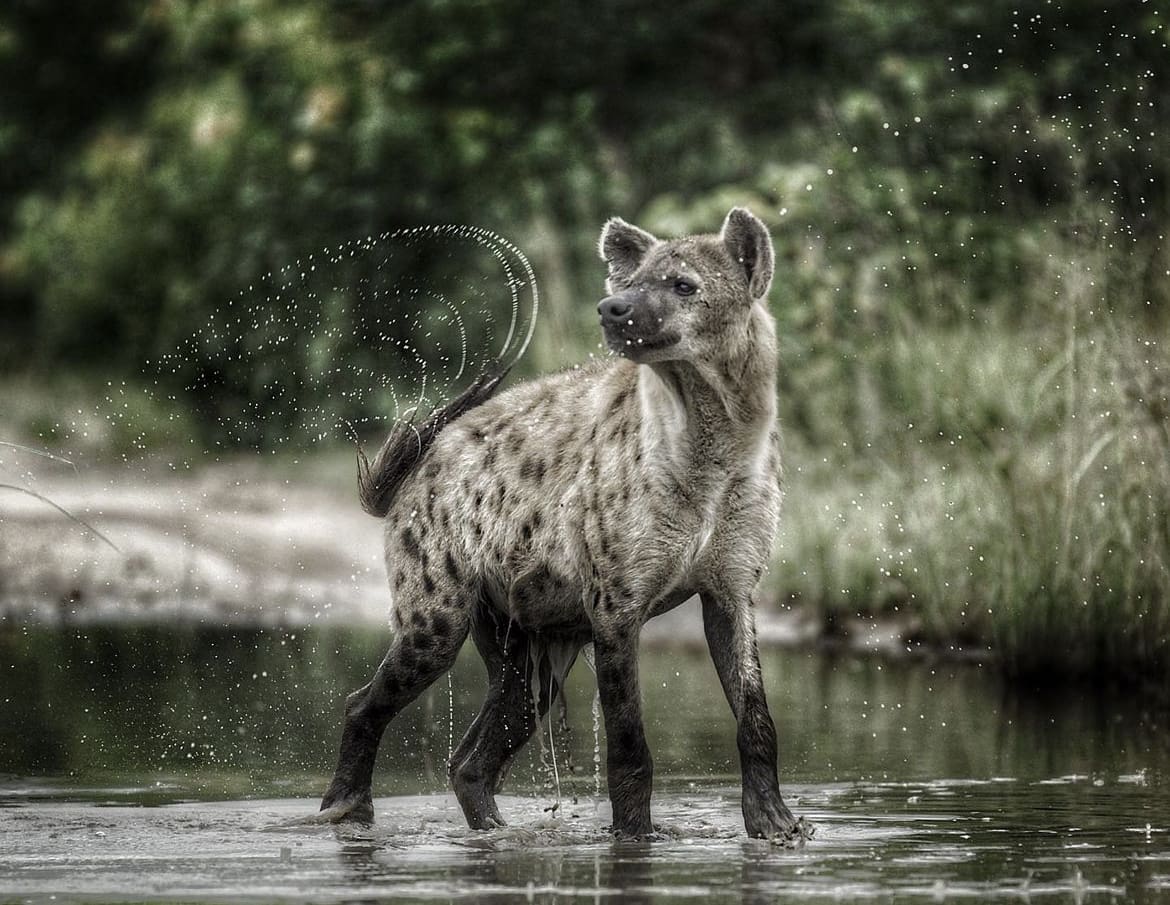
RELATED: THE TOP SAFARI DESTINATIONS IN SOUTHERN AFRICA :
Social dynamics and survival.
The pseudopenis isn't just a biological curiosity; it's a cornerstone of the social structure in spotted hyena clans. In this matriarchal society, females reign supreme, and their unique anatomy enhances their status and control within the group. The presence of the pseudopenis symbolizes strength and dominance, traits that are crucial for leadership in the competitive savannah.
Female hyenas leverage their anatomical advantage to maintain order and establish their authority. This dominance is visible not only in day-to-day interactions but also in critical moments such as food distribution and conflict resolution. The females' larger size, coupled with their aggressive demeanor (enhanced by higher androgen levels), allows them to monopolize food resources, which is vital for their survival and the nurturing of their cubs.
This dominance extends to reproductive choices as well. By controlling when and with whom they mate, female hyenas influence the genetic direction of their clan, ensuring the continuation of traits that reinforce their matriarchal system. This control over mating and the inherent selection pressure it creates shapes the evolutionary path of their species.
To put this in perspective, consider other matriarchal animal species, like elephants or orcas, where females also lead social groups and make critical decisions that affect the survival of their family units. However, unlike hyenas, their dominance does not stem from such pronounced physical masculinization but from social and intellectual prowess. This comparison not only highlights the uniqueness of the hyena's social structure but also underscores the diversity of matriarchal systems in the animal kingdom.
In the wild world of spotted hyenas, it's not just about being the strongest; it's about being the smartest and most adaptable. Their society challenges our human notions of gender and hierarchy, offering a fresh lens through which to view both animal behavior and evolutionary biology.
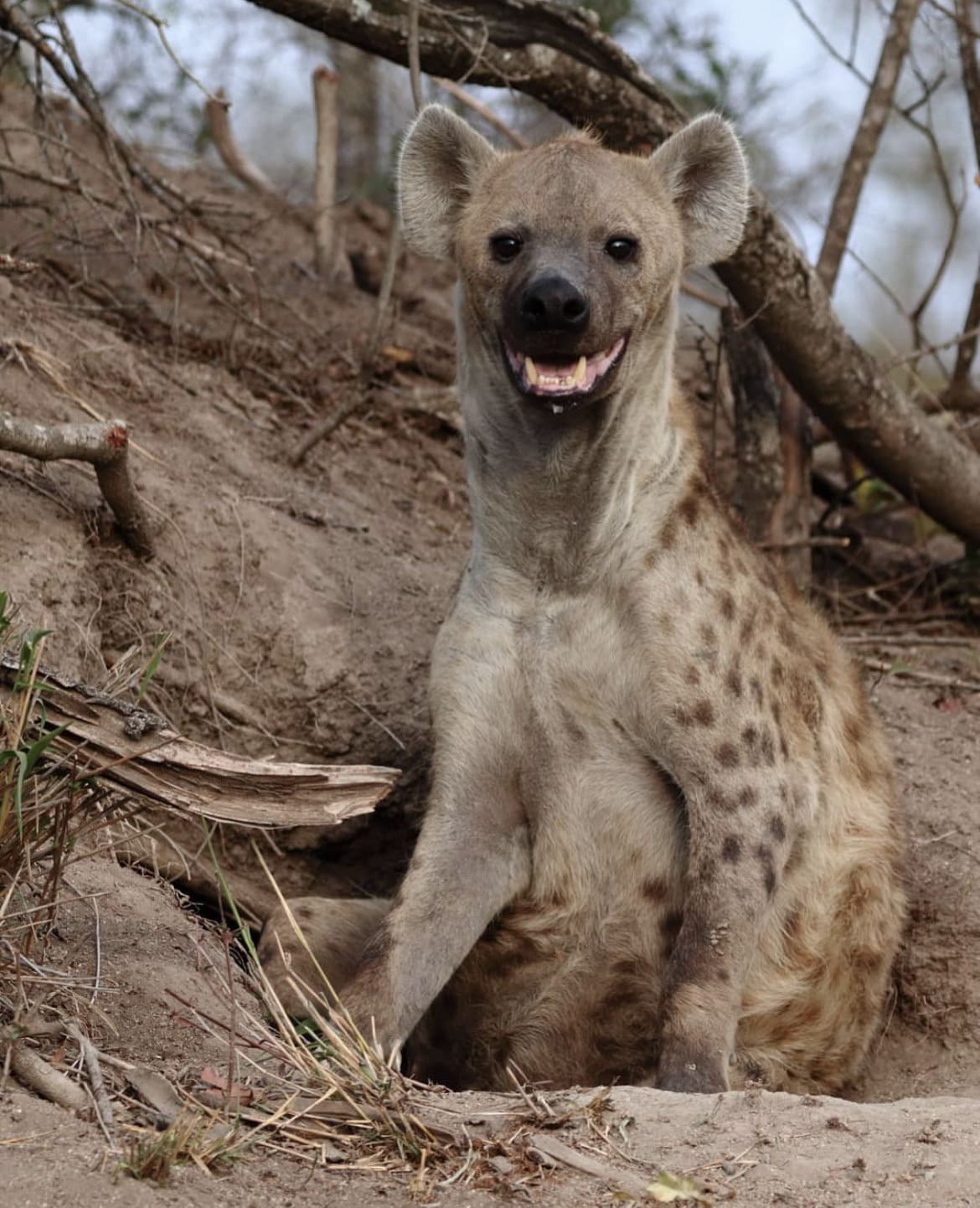
Hyenas in the Wild vs. Human Perception
From lion king to kingpin.
The portrayal of hyenas in popular media, like the sneaky and villainous trio in Disney's The Lion King , starkly contrasts with the complex and nuanced reality of these creatures. This section will dive into how spotted hyenas are viewed in the wild versus how they are often misrepresented in human culture.
In the wild, hyenas are not the cowardly scavengers as frequently depicted; rather, they are skilled hunters with a success rate that rivals that of lions. About 95% of their diet comes from their own hunting efforts, showcasing their prowess as top predators rather than mere opportunists. This misalignment between perception and reality extends beyond just their role in the ecosystem—it affects conservation efforts and our understanding of their true nature.
The spotted hyena's intelligence is another aspect that is often overlooked. They possess complex communication skills and demonstrate problem-solving abilities that are comparable to some primates. Their social interactions are intricate, with a clear structure and hierarchy that ensures group survival. This intelligence, however, is rarely highlighted in the tales told about them.
To further debunk myths and shift narratives, it's important to recommend resources that offer a more accurate depiction of hyenas. Documentaries, scientific publications, and wildlife blogs can provide insights into the real lives of these fascinating animals, promoting a better understanding and appreciation.
Conservation and Future Research
The unique reproductive anatomy and complex social structure of the spotted hyena are not just fascinating biological phenomena—they also underscore the importance of conservation efforts for this often-misunderstood species. As we delve into the needs for protecting these remarkable creatures, it becomes evident that conservation is not just about preserving an animal; it’s about maintaining the ecological balance they help uphold.
Spotted hyenas play a crucial role in their ecosystems as both predators and scavengers, helping control prey populations and clean up carcasses that could spread disease. However, they face threats from habitat loss, human-wildlife conflict, and misconceptions that lead to negative attitudes and policies. Conservation efforts need to focus on habitat preservation, conflict mitigation strategies, and education programs that shift public perception and increase ecological awareness.
Future research into hyena biology and behavior can also provide insights that enhance our conservation strategies. Understanding how hyenas adapt to changing environments, how their social structures evolve with shifts in their ecosystems, and the potential effects of climate change on their survival can inform more effective conservation practices. Additionally, studying their unique reproductive system may offer broader biological insights that could have implications for other species and even human medicine.
In closing, the conservation of spotted hyenas is a compelling chapter in the broader narrative of wildlife protection. By safeguarding these animals, we not only preserve an essential link in the African savannah but also protect a living library of evolutionary innovation and resilience. Encouraging reader engagement through support for wildlife conservation initiatives or participation in community-based protection programs can make a tangible difference in the lives of these fascinating animals and the health of our planet.
This article aims not only to educate but also to inspire action, fostering a connection between our readers and the wild world of the spotted hyena. Through understanding, respect, and proactive involvement, we can ensure that future generations will also be able to witness the incredible survival story of the spotted hyenas.
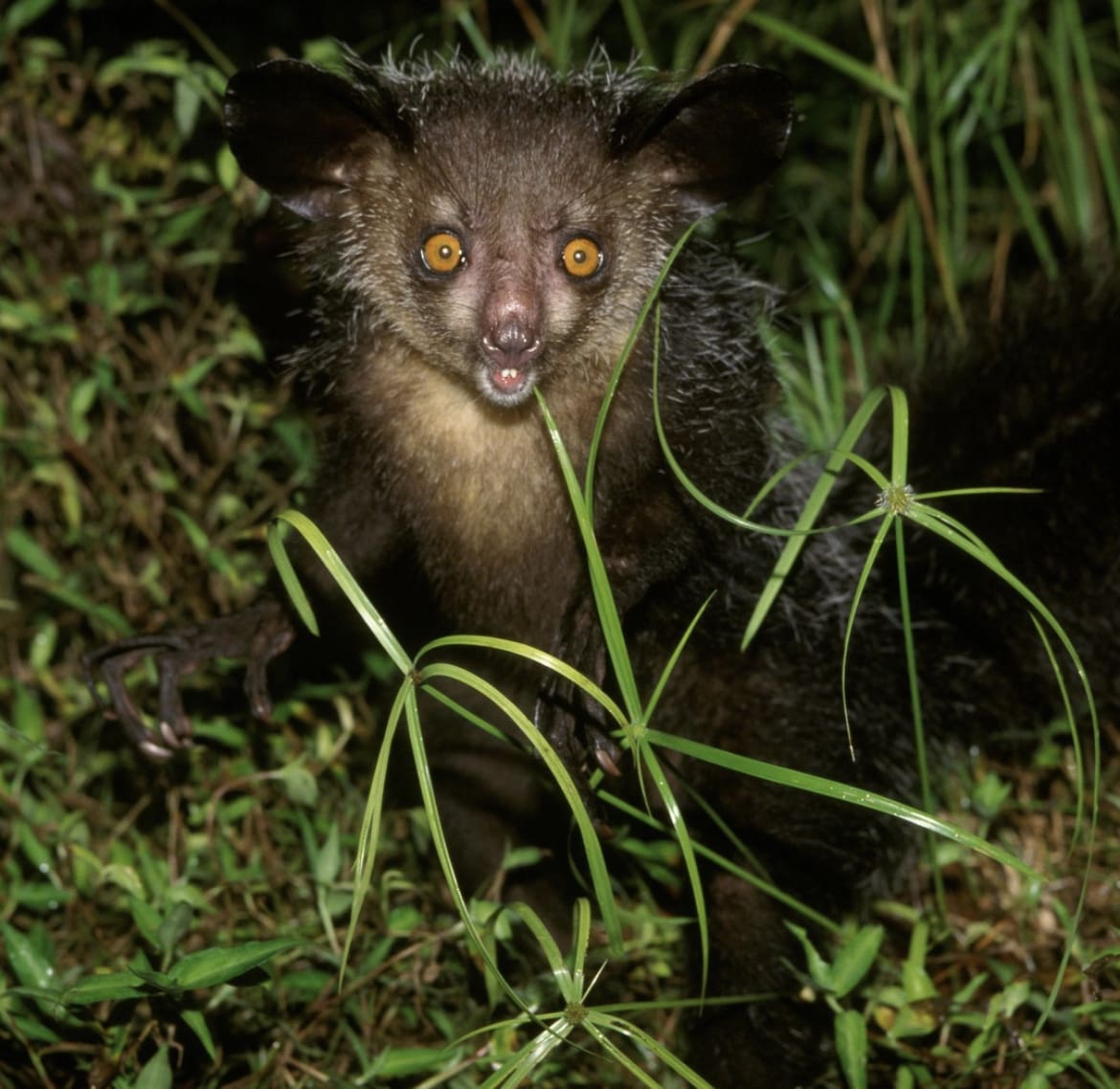
Get To Know The Aye-Aye
March 21, 2024
Alright, folks, let's dive into the world of one of the most bizarre creatures you've probably never heard of - the Aye Aye. This little critter is not your typical cute and cuddly pet material; it's more like the punk rocker of the animal kingdom, with its unconventional looks and nocturnal antics.
What is the Aye-Aye?
Native exclusively to Madagascar, the Aye Aye has the scientific community scratching their heads about where exactly it fits on the family tree. It's a lemur, but not just any lemur. It's like the black sheep of the lemur family, standing out with its unique features and behaviors.
Now, before you start thinking this is just another boring biology lesson, let me tell you, the Aye Aye is a creature that defies expectations. It's a symbol of Madagascar's incredible biodiversity and a testament to the island's evolutionary quirks. So, if you're into discovering the oddballs of the animal world, the Aye Aye is a goldmine.
What do Aye-Ayes look like?
Imagine a creature that looks like it's been assembled from parts of several different animals. Got it? Well, you're probably picturing something close to an Aye Aye. These guys have bushy tails that could rival any squirrel's, massive ears that look like they've been borrowed from a bat, and a face that's...well, let's just say it's got character.
But the real showstopper is the Aye Aye's hands, especially its middle finger. Thin, elongated, and downright eerie, this finger looks like it belongs in a horror movie. It's not just for show, though – more on that later. And their eyes? Big, bright, and reflective, these peepers are perfect for spotting dinner in the dead of night. So, while they might not win any beauty contests in the traditional sense, Aye Ayes are fascinatingly adapted to their unique lifestyle.
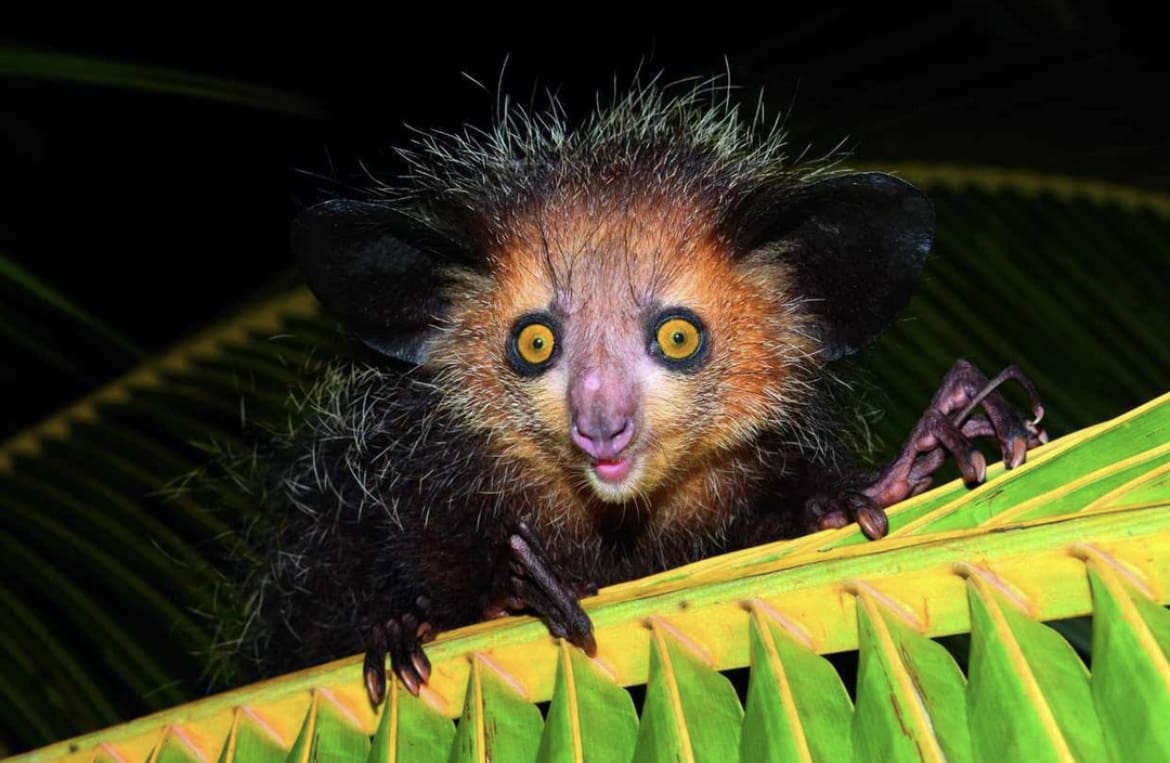
How big are Aye-Ayes?
When it comes to size, Aye Ayes are on the larger side for nocturnal primates but wouldn't exactly tip the scales. On average, they're about the length of a large house cat, but with much of that length coming from their bushy tails. Weighing in at around 2 to 2.5 kg (4 to 5.5 lbs), they're substantial enough to be impressive but still light enough to navigate the treetops with ease.
Aye-Aye Fur
Moving on from their size, let's talk about one of the Aye Aye's most noticeable features: its fur. If you're picturing something soft and cuddly, you might be a bit off the mark. The Aye Aye's coat is more on the coarse side, meant more for function than fashion. It ranges from dark brown to black, with a sprinkling of white or silver hairs that give it a slightly grizzled look. This isn't just about aesthetics, though; their fur is perfectly adapted to their nocturnal and arboreal life, providing camouflage among the trees and protection from the elements.
And here's a fun fact: the Aye Aye's bushy tail, which is longer than its body, isn't just for show. It acts as a kind of all-weather gear, wrapping around the body for warmth during those chilly Madagascar nights or fluffing out as a signal when the Aye Aye feels threatened or wants to assert its dominance. Talk about versatile fashion!
Aye Aye Teeth
But wait, there's more to the Aye Aye than just its funky fur and tail. Let's talk teeth. The Aye Aye's chompers are something else. Unlike other primates, its incisors grow continuously, much like those of a rodent. This might sound weird, but it's a key adaptation for its unique diet (hang tight; we'll get to that). These ever-growing front teeth allow the Aye Aye to gnaw through tough outer shells of nuts and insects' cocoons. So, while their dental situation might make an orthodontist wince, it's perfect for their lifestyle.
Aye Aye Finger
Now, onto the main attraction: the Aye Aye's infamous middle finger. If you thought the rest of the Aye Aye was odd, this slender, skeletal digit takes the cake. It's long, it's thin, and it's incredibly versatile. Primarily, this finger is a tool for foraging. The Aye Aye taps on wood with its other, more robust fingers and listens with its large ears for the echo that indicates hollow spaces where bugs might be lurking. Then, it uses that creepy-cool middle finger to fish out grubs and insects from the wood. Think of it as nature's own version of a Swiss Army knife.
But it's not just for feeding. This finger also has a role in grooming and perhaps even in social interactions among Aye Ayes. It's a prime example of how evolution can go down some pretty quirky paths when left to its own devices on an isolated island like Madagascar.
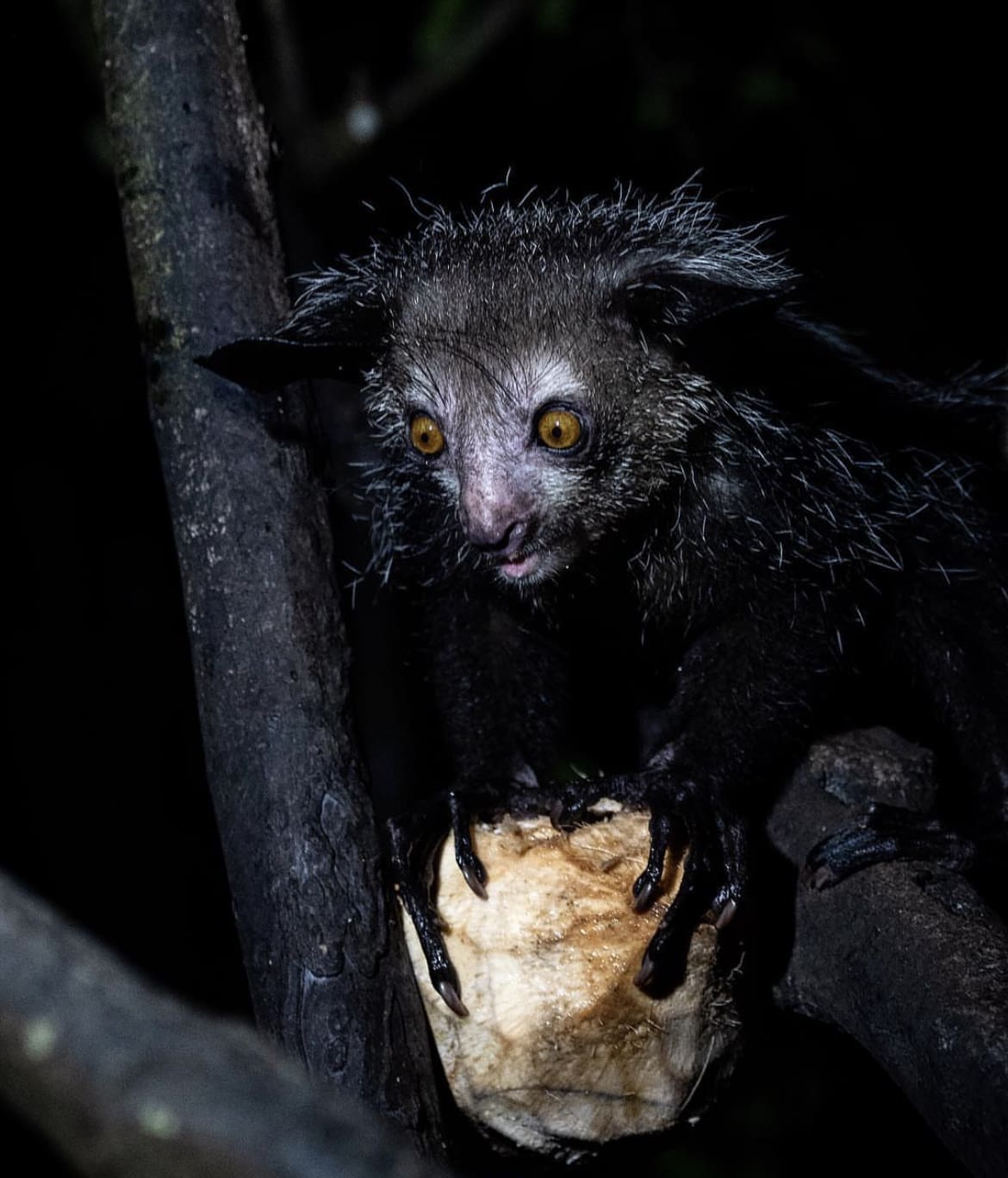
Aye-Aye Eyes
Delving deeper into the peculiar world of the Aye Aye brings us to their captivating eyes. Oversized and luminous, these orbs are the windows to the Aye Aye’s nocturnal soul, glowing eerily when caught in the light. Adapted to life under the cover of darkness, their eyes are large to capture as much moonlight as possible, allowing them to see in conditions that would leave us humans groping blindly. This exceptional night vision facilitates their unique foraging habits and keeps them alert to predators lurking in the shadows. It’s a mesmerizing feature that adds to the Aye Aye’s mysterious allure, proving that beauty truly is in the eye of the beholder.
Aye-Aye Colouration
The Aye Aye's coloration is as distinctive as its lifestyle. Its fur, a mix of black, brown, and occasionally with a hint of silver or white, isn't just about making a fashion statement in the animal kingdom. This mottled coat serves as excellent camouflage, blending seamlessly into the dark canopy of Madagascar's forests. It's a crucial adaptation for an animal that spends most of its life in the trees, allowing it to remain nearly invisible to predators and prey alike. The varying shades across its body and limbs also help break up its outline, making the Aye Aye a master of stealth. So, while its coloration may not win it any beauty contests, it's a vital part of the Aye Aye's survival kit, proving once again that in nature, function often trumps form.
What do Aye-Ayes eat?
Now, let's get to the juicy part - or should I say, the buggy part? The Aye Aye's diet is as unusual as the rest of its characteristics. These creatures are the animal kingdom's answer to a lock-picking kit, specializing in extracting hard-to-reach food sources with their unique set of tools. Primarily, Aye Ayes feast on insects and grubs, using their elongated middle finger to fish these critters out of tree bark or bamboo. But their diet isn't limited to just bug sushi; they also have a taste for fruit, nectar, and fungi.
This eclectic menu makes the Aye Aye a vital part of Madagascar's ecosystem, acting as both pest control and seed disperser. Their preference for certain types of nectar and fruit even helps with the pollination of some plant species. So, while their feeding habits might seem a bit odd to us, they play a crucial role in maintaining the health and diversity of their habitat. It’s a perfect example of how every creature, no matter how strange, has its place in the web of life.
Social Structure
Diving into the social world of the Aye Aye reveals a creature that values its personal space. Unlike the social butterflies of the animal kingdom, Aye Ayes are the introverts, preferring solitude over company. These nocturnal primates are mostly solitary creatures, coming together only for breeding purposes. Their social structure is loosely organized, with individuals having overlapping home ranges that they defend vigorously from others of the same sex.
Communication among Aye Ayes involves a mix of vocalizations, body postures, and even scent marking to convey messages across the treetops. These signals help maintain their solitary lifestyles, allowing them to come together when necessary but otherwise live independently. This preference for solitude is not just a quirky trait but a reflection of their specialized feeding habits, which require a large foraging area to support their diet. In the dense forests of Madagascar, the Aye Aye whispers its secrets, a solitary guardian of the night.
How do Aye-Ayes reproduce?
When it comes to matters of the heart, Aye Ayes are decidedly low-key. Their mating system is polygynous, meaning males may mate with multiple females when the opportunity arises. However, encounters between potential mates are rare, given their solitary nature and the vastness of their territories. When they do meet, courtship is a subtle affair, with much of the interaction focused on gentle pursuits and vocal communications.
Female Aye Ayes have a gestation period of about five months, after which they give birth to a single offspring. The young Aye Aye is weaned and begins to explore solid foods around two months but remains dependent on its mother for up to two years. This extended care period is crucial for the young Aye Aye to learn the complex skills needed for survival, from foraging techniques to navigating the treetops. The bond between mother and offspring is a testament to the Aye Aye's intricate life, hidden away in the heart of Madagascar's forests.
How long do Aye-Ayes live?
In the wild, the lifespan of an Aye Aye can be quite variable, but they are known to live for up to 20 years or more under the right conditions. In captivity, where threats are minimized, and nutrition is consistent, Aye Ayes have been known to reach ages of over 30 years. This longevity is remarkable for a creature of its size and is a testament to the Aye Aye's adaptability and resilience.
However, life in the wild is fraught with challenges, from finding enough food to avoiding predators and human threats. The Aye Aye's long lifespan allows it multiple breeding opportunities over the years, a crucial factor for the survival of this rare species. Each year in the life of an Aye Aye is a victory against the odds, a silent testament to the enduring spirit of Madagascar's most mysterious resident.
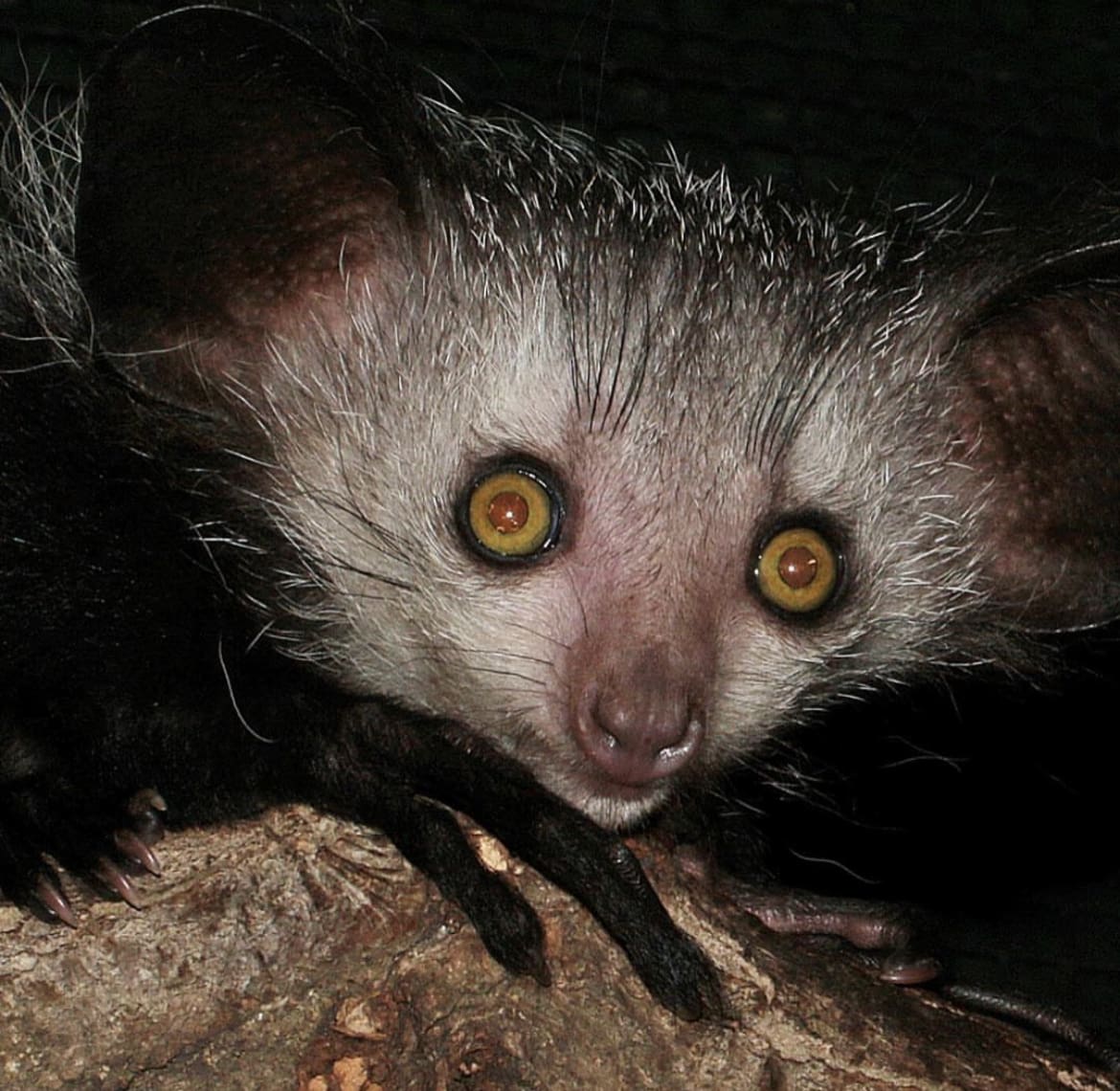
Is the Aye-Aye dangerous?
Let's debunk one of the biggest myths right off the bat: despite its somewhat ghoulish appearance and nocturnal habits, the Aye Aye is far from dangerous to humans. In fact, it's quite the opposite. These creatures are incredibly shy and will do their best to avoid human contact. The folklore surrounding them, however, paints a different picture, often depicting Aye Ayes as omens of bad luck or even harbingers of death. This unfortunate reputation has contributed to the persecution of Aye Ayes by locals in some areas of Madagascar, driven by fear and misunderstanding.
Scientifically speaking, Aye Ayes pose no threat. They're not aggressive unless cornered or captured, and their diet is primarily focused on insects and fruit. The biggest danger they pose is to the larvae of wood-boring insects. So, if you're not a grub hiding in a tree, you're probably safe. It's time we look past the superstitions and appreciate the Aye Aye for the unique and fascinating creature it is, not the mythical monster it's been made out to be.
Are Aye-Ayes territorial?
Indeed, Aye Ayes are quite territorial, especially when it comes to their feeding grounds. Given their specialized diet, they require large areas of forest to provide enough food, which means they're not too keen on sharing. Males have larger territories that may overlap with those of several females, and they spend a significant amount of time patrolling and marking their territory with scent. This territorial behavior ensures that they have exclusive access to the resources within their domain, critical for their survival.
Despite their solitary nature, Aye Ayes maintain a complex network of territories that intersect and overlap, allowing for the necessary interaction during mating seasons. These territories are not just random patches of forest but carefully chosen areas that offer the best opportunities for foraging and nesting. So, while they may not be social butterflies, Aye Ayes have a deep connection to their home turf, defending it with surprising vigor against intruders.

How fast are Aye-Ayes?
When it comes to speed, Aye Ayes are not the sprinters of the animal kingdom. Their movement is more deliberate, adapted to their nocturnal lifestyle and arboreal habitat. In the dense forests of Madagascar, agility and precision are more valuable than speed. Aye Ayes navigate the treetops with a slow, methodical grace, using their long fingers to probe for food and their large eyes to scan for danger.
However, don't let their slow pace fool you. When threatened, Aye Ayes can make a quick getaway, leaping from branch to branch with surprising agility. Their movement through the trees is a blend of creeping and climbing, carefully calculated to avoid drawing attention. So, while they might not win any races, Aye Ayes are perfectly tuned to the rhythms of the forest, moving at a pace that keeps them safe and well-fed.
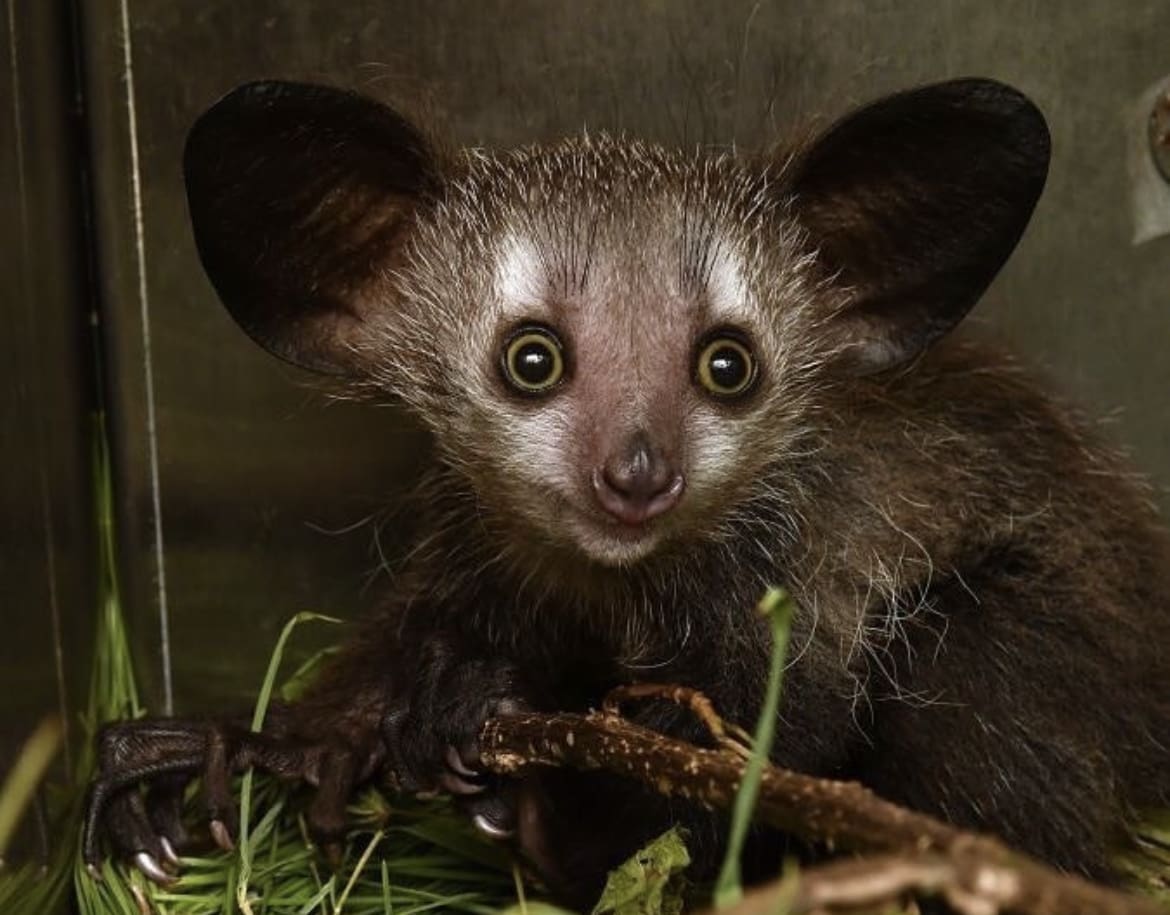
Where do Aye-Ayes live?
Aye Ayes call the lush and diverse forests of Madagascar their home, showcasing a remarkable adaptability to various habitats across the island. From the rain-drenched northern forests to the dry deciduous regions in the west and the bamboo groves of the east, Aye Ayes make themselves comfortable wherever there’s wood to be gnawed and insects to feast on. Their presence across such varied environments highlights not just the Aye Aye’s versatility but also the richness of Madagascar’s ecosystems.
These solitary creatures are masters of their realm, weaving through the treetops in the cover of night. The dense canopies of Madagascar offer more than just shelter and food; they provide a secluded haven far from human disturbances. However, the encroachment of civilization and the clearing of forests for agriculture are shrinking these habitats, pushing the Aye Aye into increasingly isolated patches of wilderness.
How many Aye-Ayes are there in the wild?
Quantifying the Aye Aye population is a challenging task, thanks to their elusive nature and the dense habitats they prefer. Estimates vary, but the consensus among conservationists is that their numbers are declining. The exact count of Aye Ayes in the wild remains a mystery, a reflection of the difficulties in studying these nocturnal creatures. Researchers rely on indirect methods, such as sightings, nest counts, and acoustic monitoring, to gauge their population density and distribution.
What is clear, however, is that the Aye Aye is under threat. Habitat destruction, hunting, and persecution due to local superstitions are the primary culprits behind their dwindling numbers. Conservation efforts are in place, aiming to protect the Aye Aye’s habitat and educate local populations about the vital role these animals play in the ecosystem. The survival of the Aye Aye is a crucial indicator of the health of Madagascar’s forests, making their protection a priority for conservationists worldwide.
Are Aye-Ayes endangered?
Yes, the Aye Aye is classified as Endangered on the IUCN Red List of Threatened Species . This status underscores the urgent need for conservation efforts to ensure their survival. Despite their adaptability to different forest environments, Aye Ayes cannot escape the widespread threats of deforestation, habitat fragmentation, and human superstition that lead to direct persecution.
The endangered status of the Aye Aye serves as a rallying cry for conservationists and wildlife enthusiasts. It emphasizes the importance of preserving Madagascar's unique biodiversity, not just for the Aye Aye but for all species that share its habitat. Protecting the Aye Aye involves a combination of habitat conservation, research, and community-based initiatives to mitigate human-wildlife conflict. The fight to save the Aye Aye is a fight for the heart of Madagascar itself, a battle against the clock to save one of the planet's most extraordinary creatures before it's too late.
Threats to Aye Ayes in the Wild
The Aye Aye faces a gauntlet of threats in its fight for survival, each one a piece of the puzzle that puts this unique species at risk. Habitat destruction is the heavyweight contender, with vast swathes of Madagascar's forests being cleared for agriculture, logging, and development. This not only reduces the Aye Aye’s living space but fragments it, isolating populations and making it harder for these solitary creatures to find mates and food.
But the challenges don't stop there. Hunting, fueled by local superstitions that cast Aye Ayes as harbingers of bad luck, adds another layer of danger. Though not targeted for bushmeat or the pet trade like other animals, Aye Ayes are often killed on sight out of fear. Additionally, climate change looms as a burgeoning threat, altering the delicate balance of their forest habitats and potentially disrupting the availability of their food sources.
Where to See Aye-Ayes In the Wild
For the intrepid wildlife enthusiast, Madagascar offers the unique opportunity to spot an Aye Aye in its natural habitat. However, patience and respect for these creatures’ nocturnal lifestyle are paramount. The Palmarium Reserve, also known as Ankanin'ny Nofy (Nest of Dreams), on the east coast of Madagascar, is one of the few places where Aye Ayes can be seen relatively easily, thanks to conservation efforts that protect a semi-wild population.
Eco-tourism, when conducted responsibly, can contribute to the conservation of the Aye Aye, offering a sustainable way for locals to value and protect their natural heritage. Visitors are encouraged to employ local guides, whose expertise and knowledge not only enhance the chance of an encounter but ensure minimal disturbance to the animals.
Tips for Spotting Aye Ayes
Seeing an Aye Aye in the wild is a rare privilege, requiring a bit of know-how:
- Go at night : Aye Ayes are nocturnal, so your best chance of spotting one is after dark.
- Stay quiet : Noise can scare them away, so move silently and keep chatter to a minimum.
- Use red light : If using a flashlight, cover it with red cellophane. Aye Ayes are less sensitive to red light, so it’s less likely to disturb them.
- Be patient : Wildlife watching is a waiting game. Stay in one spot and keep your eyes peeled.
Facts about The Aye Aye
- Aye Ayes are the world’s largest nocturnal primate.
- They have a unique method of finding food called percussive foraging, where they tap on wood to listen for insects moving inside.
- Aye Ayes have a special membrane over their third eyelid, known as a nictitating membrane, which helps protect their eyes while foraging.
- Unlike most primates, Aye Ayes have continuously growing incisors.
- They can rotate their third finger up to 360 degrees to extract food.
Myths about The Aye Aye
- Harbinger of death : In some Malagasy cultures, seeing an Aye Aye is considered an omen of death. This myth has contributed to their persecution.
- Human reincarnation : Some believe Aye Ayes are the reincarnated spirits of ancestors, adding to their mystique.
- Curses : There’s a myth that if an Aye Aye points its middle finger at you, you're cursed. Fortunately, this is just a tall tale.
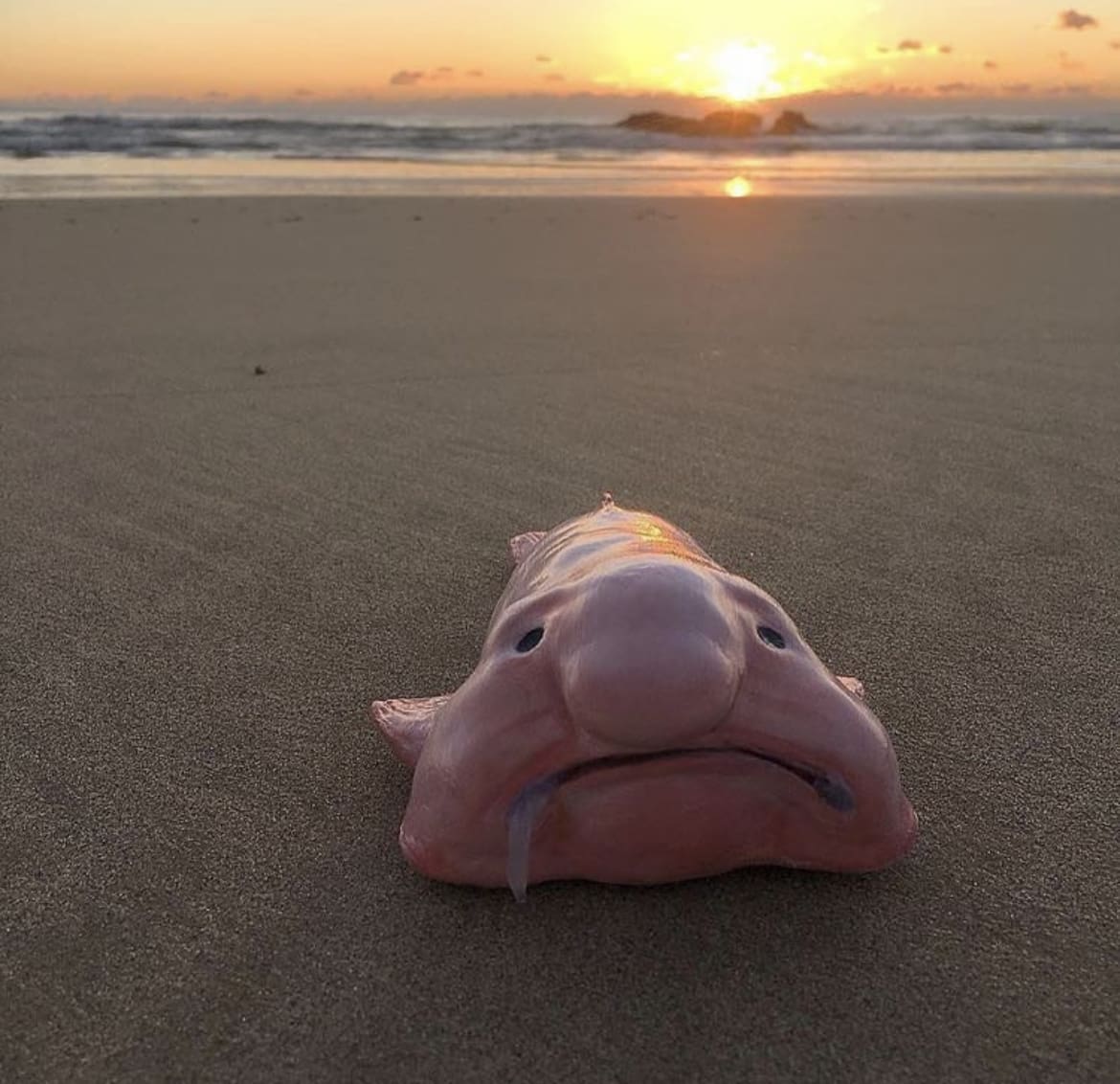
Get To Know The Blob Fish
So, you’ve probably seen this face only a mother could love plastered across memes and " ugliest animal " polls, right? Meet the blob fish, or Psychrolutes marcidus if you want to get all scientific about it. This gelatinous wonder isn't just a fixture of internet fame; it’s a bona fide inhabitant of the deep sea, living life at pressures that would squish the rest of us into a human pancake.
So What is the Blob Fish, Anyway?
Residing at depths of 600 to 1,200 meters where the pressure is an insane 60 to 120 times greater than at sea level, this fish has adapted to an environment that’s about as forgiving as a landlord on rent day.
Why the buzz, though? Well, the blob fish breaks the mold of your typical Nemo or Dory. It’s not about flashy colors or sleek swimming; it’s about survival in the deep blue’s equivalent of outer space. This creature is a testament to the weird, the adaptive, and the outright miraculous nature of evolution. So, buckle up as we dive deep (pun intended) into the world of the blob fish, a creature that challenges our perceptions of beauty and resilience in the animal kingdom.
What Do Blob Fish Look Like?
Imagine if a fish decided to go as a puddle for Halloween—that's your blob fish. Out of water, it’s got this droopy, sad sack appearance that's spawned a thousand memes. But don’t let its deflated balloon look fool you; in its natural habitat, the blob fish leads a far less comical existence.
With a body density slightly less than water, the blob fish is a master of the effortless float. No need for a swim bladder here; its gelatinous body allows it to hover just above the seafloor, waiting to ambush unsuspecting prey. This almost gravity-defying act is the blob fish's secret weapon, letting it conserve energy in an environment where every calorie counts.
Size-wise, they’re not about to win any heavyweight titles. Typically, blob fish are about as long as a ruler, with some variation here and there. Their appearance, often described as a mix between a grumpy old man and a glob of goo, belies a creature perfectly adapted to life under extreme pressure.
How Big Are Blob Fish?
So, how big does this gloopy ambassador of the deep get? On average, blob fish are around 30 centimeters (about 12 inches) long. But, like any good fish tale, sizes can vary. Think of them as the underwater equivalent of a medium-sized lapdog—only, you know, less cuddly and a bit more on the squishy side.
Their size is pretty much perfect for the life they lead. Big enough to gulp down whatever unfortunate sea critters happen to drift their way, but not so large as to make life under extreme pressure untenable. It’s all about that sweet spot, and the blob fish has found its niche in a place most other creatures would find inhospitable.
Blob Fish Skin: Not Your Average Fish Scale
When you’re living under the kind of pressure that would turn other fish into fish sticks, you’ve got to have skin that can handle it. The blob fish's skin is a marvel of deep-sea adaptation. It’s not about winning beauty contests; it's about survival. This fish’s skin is thick, gooey, and gelatinous, providing just the right amount of resistance against the crushing depths. No scales here—just a smooth, jelly-like texture that would probably make for the world’s worst facial.
This squishy exterior plays a critical role in the blob fish’s life. It’s density is just right, allowing the fish to float above the sea floor without wasting energy on swimming. Think of it as nature’s way of giving the blob fish a perpetual hover mode. Plus, it's incredibly efficient. No need for a fancy swim bladder; the blob fish’s own body composition keeps it buoyant. In a place where efficiency is key, the blob fish's skin is its ticket to an easy ride.
Blob Fish Teeth
Now, before you start imagining the blob fish with a shark-like grin, let’s set the record straight: if the blob fish had a dental plan, it’d be pretty minimal. Its mouth is more about gulping than chewing, equipped to swallow marine snow (organic material that falls from higher in the water column) and small critters whole.
The blob fish’s diet is a low-effort affair, fitting for a creature that looks like it can’t be bothered. It’s not out chasing down meals; instead, it waits for the buffet to come to it. The design of its mouth and the near-absence of teeth reflect this laid-back dining style. So, no, it’s not going to bite—unless you’re a tiny sea creature that happens to float by.
Blob Fish Eyes
Given its underwhelming dental situation, you might wonder if the blob fish has better luck in the vision department. Living in the deep, dark depths of the ocean, you’d think evolution would hook it up with some night-vision goggles or something. Well, the blob fish’s eyes are small and not particularly well-adapted for seeing in the dark, murky waters it calls home.
This might seem like a raw deal, but remember, the blob fish doesn’t need to dodge predators or chase down speedy prey. Its lifestyle is more about sitting tight and waiting for food to come to it. The blob fish's eyes are good enough for detecting the faint silhouettes of food floating by, and in the deep sea, that’s all you really need. It’s a world where energy conservation is key, and every adaptation, no matter how seemingly underwhelming, serves a purpose.
Blob Fish Coloration
When it comes to fashion, the blob fish isn’t winning any awards, but in the high-pressure world of the deep sea, its coloration is all about functionality. Sporting a nondescript, muted palette that ranges from a dusky pink to a drab grey, the blob fish’s coloration is the perfect camouflage for the deep blue. This isn’t the bright, coral reef part of the ocean; it’s the murky, no-light zone where blending in means staying alive.
This subtle coloration helps the blob fish avoid becoming an easy target for the few predators that roam its deep-sea neighborhood. Plus, without any natural light, flashy colors wouldn’t be seen anyway. The blob fish’s look is perfectly adapted to its environment, ensuring it stays under the radar, both literally and figuratively.
What Do Blob Fish Eat?
You might expect the diet of the blob fish to be as bizarre as its appearance, but it's surprisingly mundane. Primarily, blob fish are opportunistic feeders, dining on whatever edible bits drift down to their level. This can include small crustaceans, sea pens, and other slow-moving or stationary deep-sea snacks. The blob fish’s eating strategy is the ultimate in energy conservation. Why swim after your food when you can just open your mouth and wait for dinner to float in?
The blob fish’s diet reflects its overall strategy: minimal effort for maximum gain. It’s not picky; when you live where it does, you can’t afford to be. Every meal is about making the most of what the deep sea provides, utilizing a lifestyle that conserves as much energy as possible. In the blob fish's world, it’s not about the thrill of the hunt; it’s about the wait for the drift.
Blob Fish Social Structure
If you’re picturing a social network of blob fishes hanging out and sharing the latest sea gossip, you might be a bit disappointed. Blob fishes are largely solitary creatures, rarely interacting with others of their kind. Their social structure, if you can call it that, is more about solitary survival than forming bonds or communities.
This doesn’t mean blob fishes are complete loners by choice. Their sparse population and the vastness of their deep-sea environment make encounters with other blob fishes rare. When they do meet, it’s usually by chance, and there’s little to no interaction. They don’t form schools or pairs; each blob fish is an independent unit, drifting through the deep sea and living a life of quiet solitude.
The lack of social structure among blob fishes is yet another adaptation to their environment. In the deep sea, resources are scarce, and competition is minimal. There’s no need for complex social behaviors when you spend your days floating alone, waiting for food to come your way. For the blob fish, solitude is not just a way of life; it’s the key to survival in one of the most inhospitable places on Earth.
How Do Blob Fish Reproduce?
Diving into the love life of the blob fish, you might be surprised to find it’s not as gloomy as their expression suggests. When it comes to reproduction, blob fishes maintain their low-energy ethos, but they do get the job done. The details are a bit murky—after all, observing blob fish in the wild, especially during intimate moments, is a challenge. However, it’s believed that like many deep-sea creatures, blob fishes employ external fertilization, where females release eggs into the water to be fertilized by males.
This method fits perfectly with their laid-back lifestyle. There’s no need for elaborate mating dances or long courtships in the deep sea. Instead, it’s about maximizing the chance of success with minimal effort. The females lay eggs on the ocean floor, often under rocks or in other protected areas, and the males fertilize them as they pass by. Once the deed is done, blob fish parents go their separate ways, leaving the eggs to develop and hatch on their own.
How Long Do Blob Fish Live?
Estimating the lifespan of a creature as elusive as the blob fish is tricky, but they’re believed to have relatively long lives for fish, potentially living for several decades. This extended lifespan is likely a result of their slow-paced lifestyle and the stable, albeit harsh, conditions of the deep sea.
The blob fish’s longevity is another testament to its efficiency. In an environment where every movement and every calorie counts, growing slowly and living long is a strategy that makes sense. It allows them to reproduce over a longer period and increases their chances of survival in the deep sea’s vast and sparsely populated expanses.
Is the Blob Fish Dangerous?
Let’s face it, the blob fish looks like it couldn’t chase you down even if it wanted to. And you’d be right to think so. Blob fishes pose no danger to humans—mostly because they’re deep-sea dwellers and our paths rarely cross. But even in their own domain, blob fishes are harmless. They’re not predators in the traditional sense; they’re scavengers and opportunistic feeders, living off what the ocean currents bring their way.
The idea of the blob fish being dangerous is a bit of a humorous notion. With their slow movements, gelatinous bodies, and passive feeding habits, they’re about as threatening as a bowl of Jell-O. The only risk they pose is to the tiny invertebrates that drift into their path. For the rest of the ocean—and for us humans—the blob fish is simply a fascinating example of nature’s adaptability, not a creature to be feared.
Are Blob Fish Territorial?
Given their solitary and passive nature, you might wonder if blob fish have any territorial instincts. In the vast and empty expanses of the deep sea, the concept of territory is a bit different from what you'd find in more populated waters. Blob fish do not exhibit territorial behavior in the traditional sense; they don’t guard specific patches of ocean floor or chase away intruders. Their survival strategy does not rely on defending a particular area but rather on being able to exist wherever there’s enough deep-sea detritus and small creatures to consume.
This lack of territorial aggression further underscores the blob fish’s energy-conservation lifestyle. In an environment where encounters with others of their kind are rare, and the effort required to actively defend a territory would far outweigh the benefits, the blob fish opts for a more nomadic existence, drifting wherever the currents and food supply take them.
Can Blob Fish Swim?
The image of the blob fish lazily floating in the deep might lead some to question its swimming abilities. Indeed, blob fish are not strong swimmers. Their bodies are designed more for buoyancy and drifting than for active, agile movement. The blob fish relies on its gelatinous body, which is slightly less dense than the surrounding water, to maintain its position in the water column with minimal effort.
Instead of swimming through the water like many fish, blob fish are more likely to use subtle movements to navigate their deep-sea environment. These movements are so minimal they might not even be considered swimming in a traditional sense. This adaptation is perfect for the energy-scarce deep sea, where conserving calories is crucial for survival.
How Fast Are Blob Fish?
Given their lack of swimming prowess, it’s probably no surprise that speed is not in the blob fish’s repertoire. You won’t find blob fish participating in any underwater races; they’re among the slowest-moving creatures in the ocean. Their mode of transportation is more about gentle drifting than speed, perfectly suited to their low-energy lifestyle and the environment they inhabit.
The blob fish’s lack of speed is yet another adaptation to the high-pressure, low-energy world of the deep sea. In a place where fast movements and high speeds would require more energy than the environment can provide, the blob fish’s slow, drifting way of life ensures it conserves every possible bit of energy, optimizing its chances of survival in the deep.
Threats to Blob Fish in the Wild
The blob fish faces several threats, many of which stem from human activities. Despite its deep-sea habitat, it's not immune to the impacts of fishing, particularly bottom trawling, which disrupts the seabed environment. This form of fishing can destroy the delicate balance of the blob fish’s ecosystem, affecting its food sources and directly endangering its population. Additionally, climate change poses a less direct but equally concerning threat, potentially altering the deep-sea environment in ways that could affect the blob fish and its neighbors.
The challenge in protecting the blob fish lies in the complexity of its habitat. The deep sea is a difficult place to study and even harder to manage for conservation. Efforts to mitigate these threats require international cooperation and a commitment to sustainable fishing practices and ocean conservation.
Where to See Blob Fish
For those intrigued by the blob fish and wishing to catch a glimpse outside of the digital realm, options are, unfortunately, limited. Their deep-sea habitat makes direct observation virtually impossible for casual enthusiasts. However, some specimens have been brought to the surface and preserved in museums and aquariums. The Australian Museum in Sydney, for example, has a blob fish specimen on display.
These preserved specimens offer a rare opportunity to see the blob fish up close, but they also serve as a reminder of the creature's vulnerability. Public education and awareness can play a significant role in the conservation of the blob fish and its habitat, making these displays more than just curiosities; they're a call to action.
Tips for Spotting Blob Fish
For the aspiring blob fish spotters, the reality is that seeing one in its natural habitat is unlikely. However, there are ways to engage with the world of the blob fish and deepen your understanding of this unique creature:
- Visit museums and aquariums that feature deep-sea exhibits.
- Support and follow deep-sea research expeditions online; many share findings and images from their dives.
- Engage with conservation organizations that focus on ocean protection, helping to preserve the habitat of the blob fish and countless other deep-sea creatures.
Facts about The Blob Fish
- The blob fish lives at depths where the pressure is dozens of times higher than at sea level.
- It has a gelatinous body that allows it to float just above the seafloor, conserving energy.
- Despite its somewhat sad appearance out of water, the blob fish is perfectly adapted to its deep-sea environment.
- It is not considered dangerous to humans or other large marine animals.
- The blob fish’s diet consists mainly of small invertebrates that float into its mouth.
Myths about The Blob Fish
- It's the ugliest fish in the sea: Beauty is in the eye of the beholder, and the blob fish’s appearance is a result of its deep-sea adaptations.
- It can be found all over the world: The blob fish is primarily found in the waters around Australia, Tasmania, and New Zealand.
- It's always been a popular oddity: The blob fish rose to internet fame relatively recently; before that, it was a little-known creature of the deep.
The blob fish, with its peculiar appearance and deep-sea lifestyle, captivates the imagination and highlights the diversity of life on our planet. It serves as a reminder of the wonders that lie hidden in the depths of the ocean and the importance of preserving these fragile ecosystems. Through understanding and appreciating creatures like the blob fish, we can foster a greater connection to the natural world and a stronger commitment to its protection.
Privacy Preference Center
Privacy preferences.
- Sahara Wildlife
Meet The Fennec Fox: The Iconic Desert Ambassador
- 3 April, 2024
- 5 Minutes Read
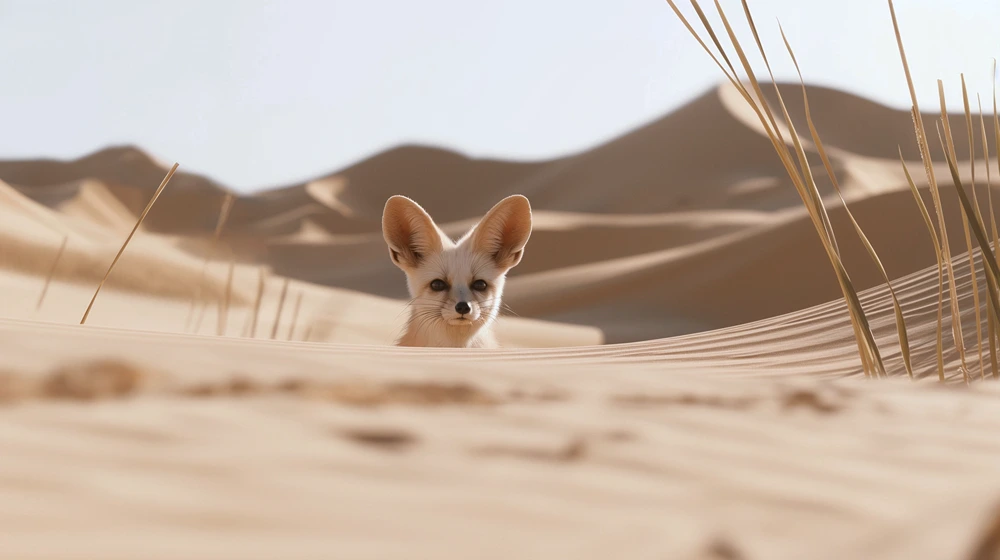
- Photo Credit: SafariSahara.com
In the heart of the greatest desert, the sahara, where the land is vast and the sun always shines, there’s a small animal that has made a big impression. Known for its oversized ears and friendly nature, this creature thrives in one of the toughest environments on earth. It’s the Fennec Fox.
In this article, we’ll get to know this iconic desert ambassador. We’ll cover its characteristics, habitat, diet, nocturnal lifestyle, ecological role, the challenges it faces, and the conservation efforts underway to protect it.
Who is the Fennec Fox?
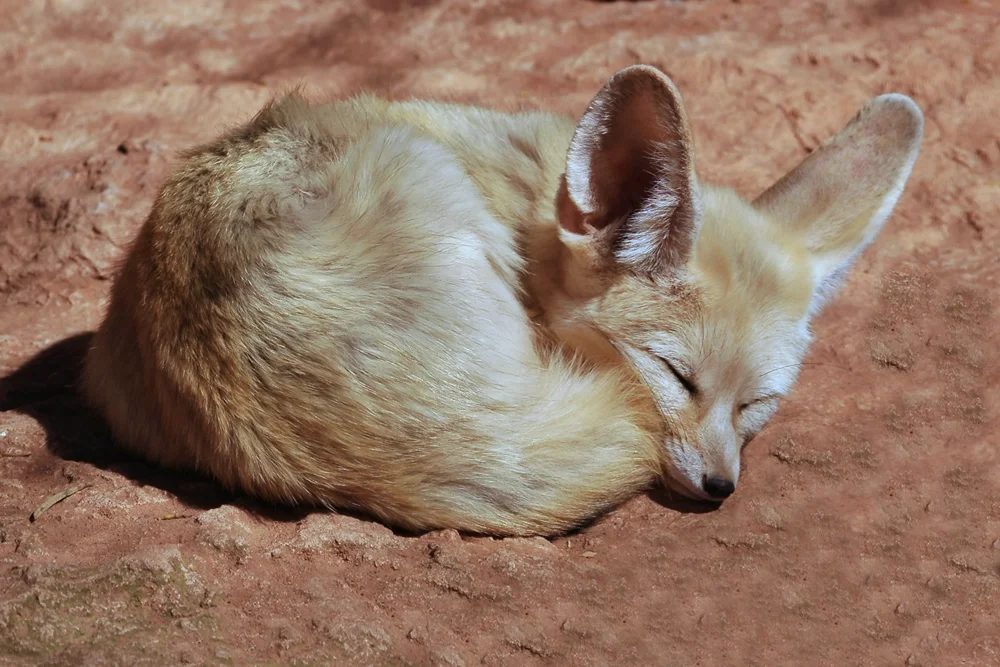
The Fennec Fox, a small nocturnal creature scientifically known as Vulpes zerda, is the smallest member of the canid family, weighing between 2 to 3 pounds. Its body size ranges from 4 to 16 inches in length, not including the tail, and it stands approximately 9 inches tall at the shoulders.
Known for its bat-like ears that can grow between 4 to 6 inches in length, which may be nearly as long as half of the fox’s body, making the Fennec Fox one of the most captivating creatures of the Sahara Desert.
Where do the Fennec Fox live?

The Sahara Desert, a vast expanse of relentless heat and shifting sands, is more than just a backdrop for the Fennec Fox; it is their home. This vast terrain, recognized as the largest hot desert in the world, is as challenging as it is expansive, with extreme temperatures, scarce water sources.
Despite the Sahara’s diverse terrains, from the rolling sand dunes (ergs) to the expansive rocky plains (hamadas), the Fennec Fox has not only adapted but also thrived. Their habitat extends across the deserts of North Africa, ranging from Morocco and Mauritania to Egypt.
The Daily Life of a Desert Dweller
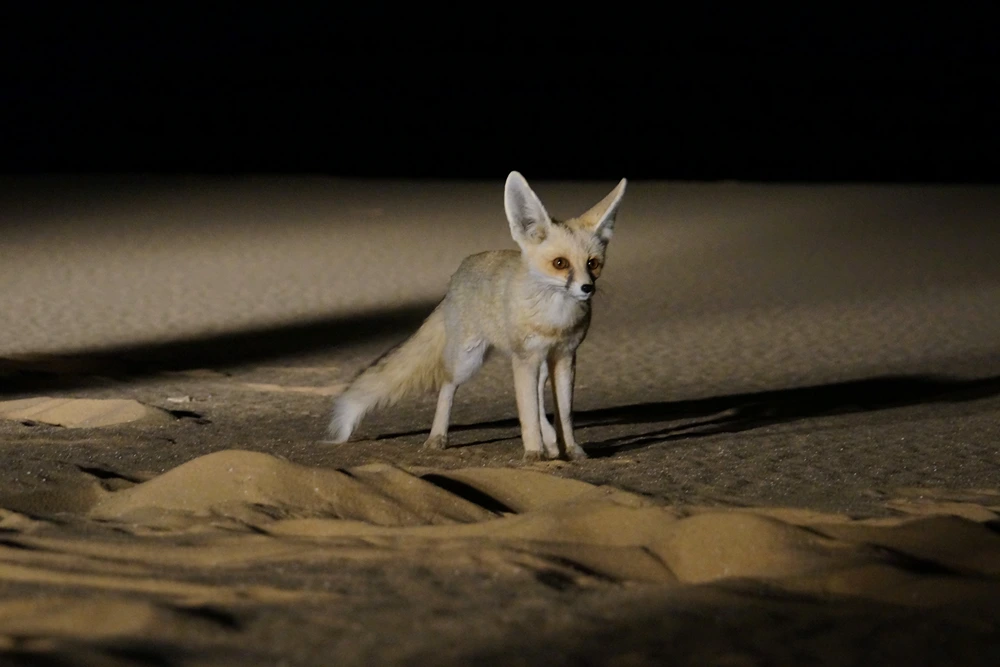
The Fennec Fox leads a nocturnal lifestyle, active during the night and resting during the day. This pattern helps it avoid the Sahara’s intense daytime heat. Its day begins as the sun sets, when the desert cools, providing a cozy environment for hunting and socializing.
Fennec Foxes are omnivores, feeding on a diet that includes insects, plants, and small animals. Their wide-ranging diet is crucial for survival in an environment where food sources can be scarce and unpredictable.
Social interaction is also a key part of their nocturnal life. Fennec Foxes live in communities, often in groups of up to ten individuals, where they communicate through various vocalizations and body language.
The Fennec Fox lives in burrows, not just as heat shelters but as communal spaces. These extensive underground networks have multiple entrances and rooms, offering a safe haven for the foxes.
The Ingenious Ear Adaptations
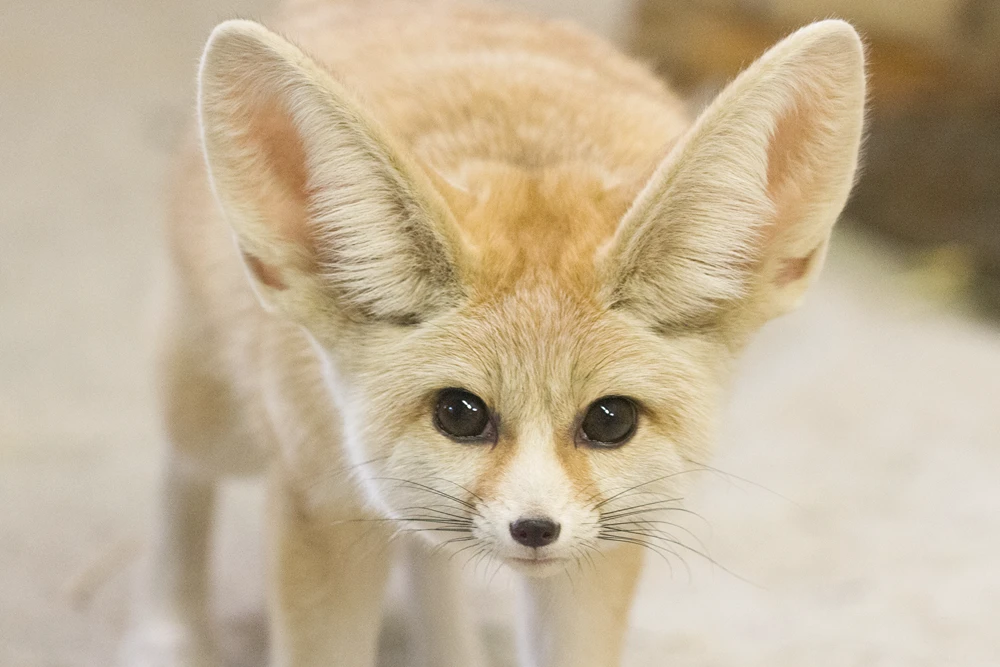
Among the many adaptations that allow the Fennec Fox to thrive in the Sahara Desert, its large ears are perhaps the most iconic. These aren’t just striking features; they’re vital tools for survival in the extreme desert conditions. Measuring up to 6 inches, the ears of the Fennec Fox serve multiple critical functions beyond their acute hearing.
Thermal Regulation
The desert is a land of extremes, where daytime temperatures can soar, making life challenging for its inhabitants. The Fennec Fox’s large ears filled with blood vessels that release heat, effectively regulating the fox’s body temperature in the scorching heat of the Sahara.
Hunting at Night
As nocturnal creatures, the Fennec Fox rely on their keen sense of hearing to locate prey in the dark. Their large ears can detect the subtlest sounds of movement, whether it’s the scuttle of an insect or the soft footsteps of a rodent. This exceptional hearing aids them in hunting efficiently, ensuring they find enough food to sustain themselves in the desert.
Communication
In the vastness of the Sahara, staying connected with family members is crucial for survival. The Fennec Fox utilizes its large ears to pick up on the subtle vocalizations of its kin, enabling it to communicate effectively over long distances. This communication is vital for maintaining strong social bonds and alerting each other to potential dangers.
Challenges Facing the Fennec Fox
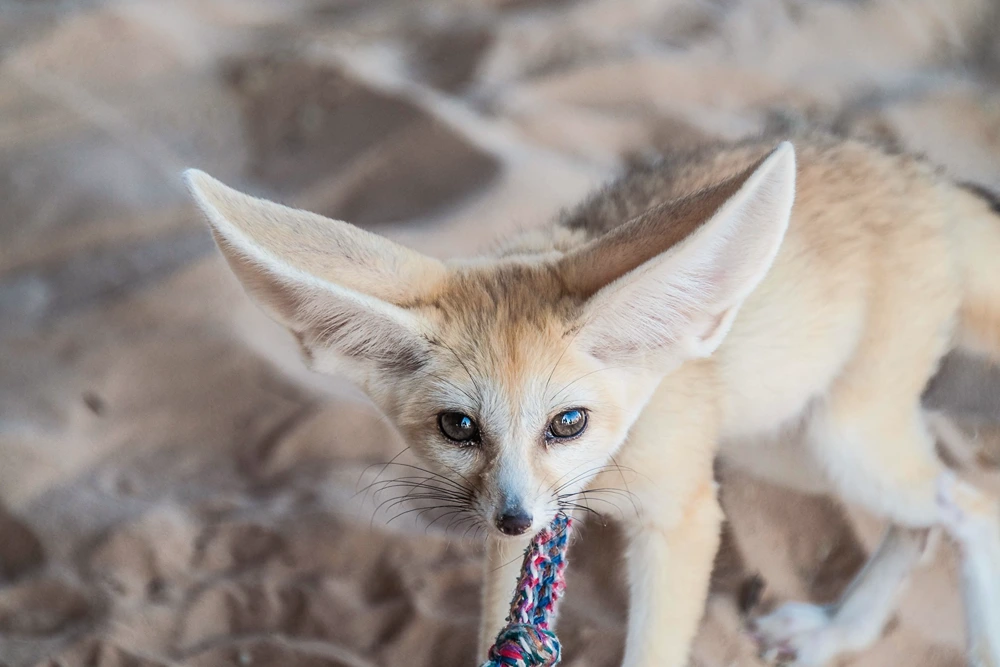
The Sahara Desert, with its extreme temperatures and scarce water, presents a harsh reality for its inhabitants. The Fennec Fox, despite its adept adaptations, faces significant challenges that threaten its survival. Key among these are habitat loss due to human expansion and the illegal pet trade, which disrupts their natural populations and habitats.
Habitat Loss
As human populations expand into sahara desert regions, the natural habitats of Fennec Foxes are increasingly encroached upon. This loss of habitat not only reduces their living space but also affects their access to food sources, posing a threat to their survival.
Illegal Pet Trade
The Fennec Fox’s unique and appealing appearance has made it a target for the illegal pet trade. Capturing these animals from the wild not only disrupts their natural populations but also places individual animals in situations where their specialized needs are unlikely to be met.
Fennec Fox Conservation Efforts
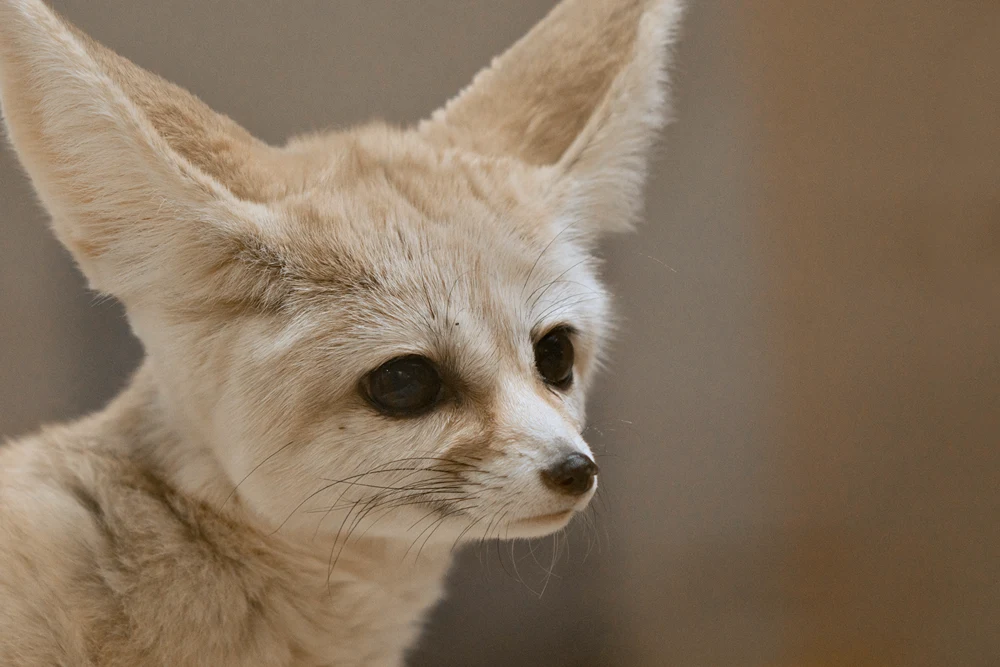
Protecting the Fennec Fox and its habitat requires a concerted effort from conservation organizations and governments. Here are ways we can contribute to the preservation of this remarkable desert dweller.
Support Conservation Organizations
Many NGOs and conservation groups are working tirelessly to protect the Fennec Fox and its natural habitat. One such organization is Sahara Conservation , a 501(c)(3) nonprofit registered in the United States (Tax ID #: 26-0171939). Donating to these organizations can provide them with the resources needed to continue their vital work.
Responsible Tourism
If visiting the Sahara, choose eco-friendly tours that minimize impact on the environment and its inhabitants. Supporting ecotourism can also encourage local communities to protect wildlife and natural resources.
Educate Others
Raising awareness about the Fennec Fox, its role in the ecosystem, and the threats it faces can inspire others to take action. Education can be a powerful tool in the fight against illegal wildlife trade and habitat loss.
Our Role as a Travel Agency

At Safari Sahara Travel Agency , we’re deeply committed to the conservation of the Sahara Desert’s unique wildlife, especially the enchanting Fennec Fox. Our approach to tourism is rooted in respect for nature and the principles of responsible and sustainable travel.
Through our carefully designed wildlife tours, we aim not only to showcase the beauty of the Sahara and its inhabitants but also to educate our guests about the critical importance of conservation efforts.
Our connection to the natural world is underscored by the story of the Fennec Fox, a tale of survival, adaptation, and the intricate balance of ecosystems. Protecting this remarkable animal and its habitat isn’t just about preserving a species; it’s about maintaining the health and diversity of our planet for future generations.
Joseph Taoubane
Join newsletter.
Stay current with the latest and exclusive articles.
Table of Contents
Related articles.

The Moroccan berber rug : a reflection of morocco’s deep history
Discover 10 Amazing Sahara Desert Animals You Must See

Discover the Hidden Beauty of the Sahara Desert in Morocco

+212 6 5149 3572
Reach Out To Reserve Your Tour Today!
Send us enquiry
Useful Links
- Privacy Policy
- Terms of Use
- About Agency
- Sahara Tours
Get in touch today
Open daily from 9:00 am to 4:30 pm -->

Vulpes zerda

These small foxes live in family groups of sometimes up to 10 individuals. These groups are often led by the parents and will sometimes share massive dens with other families.
Fennec Foxes show abundant play behavior and communicate with a complex collection of barks, yips, and growls. Despite this sociable nature, they prefer to hunt alone and are nocturnal. At the Honolulu Zoo, our Fennec Foxes will stay ‘up late’ enough into the late mornings, before settling down to sleep the day away.
PHYSICAL CHARACTERISTICS
The Fennec Fox is the smallest of the known fox species, and also possesses the largest ears of any fox. Both of these adaptations allow it to avoid overheating in hot desert environments. Another useful adaption are fur-covered paw pads to protect them against burning sand. Their coats are light and sandy in color, are thick and soft.
Fennecs are omnivores and will take whatever is available. In the wild, they regularly prey on birds, eggs, invertebrates, and other small animals. Extra food is sometimes hidden away for later. Much, if not all of their water is collected from eating fruits and roots of plants. At the Honolulu Zoo, some of our foxes are very fond of blueberries, and they enjoy live mealworms as treats during their training sessions.
REPRODUCTION & GROWTH
Fennec Foxes mate for life and sometimes adult offspring will remain with the family to help raise younger siblings. Females are only in heat for several days between January and February.
These small foxes live in family groups of sometimes up to 10 individuals. These groups are often led by the parents and will sometimes share massive dens with other families. Fennec Foxes show abundant play behavior and communicate with a complex collection of barks, yips, and growls. Despite this sociable nature, they prefer to hunt alone and are nocturnal. At the Honolulu Zoo, our Fennec Foxes will stay ‘up late’ enough into the late mornings, before settling down to sleep the day away.
NOTES ON CONSERVATION
The Fennec Fox enjoys a wide range with stable populations, so it is listed as a species of Least Concern by the IUCN Red List. Some wild individuals are collected for the pet trade, but the Honolulu Zoo cautions against keeping animals directly from the wild, as they are untrusting of humans, and their nocturnal habits make for poor companions.
AT THE HONOLULU ZOO
The Honolulu Zoo is home to a mated pair of Fennec Foxes (Moana and Aukai) and their adult son, Vitea.
Vulpes zerda . (n.d.). Retrieved January 13, 2017, from http://www.iucnredlist.org/details/41588/0
Adams, R. (n.d.). Vulpes zerda (fennec). Retrieved January 13, 2017, from http://animaldiversity.org/accounts/Vulpes_zerda/
Other Mammals

Hamadryas Baboon
Sacred Baboons are common throughout northeastern Africa, but are extinct in the Nile region and Egypt, where they originally received their name and were worshiped by the ancient Egyptians.
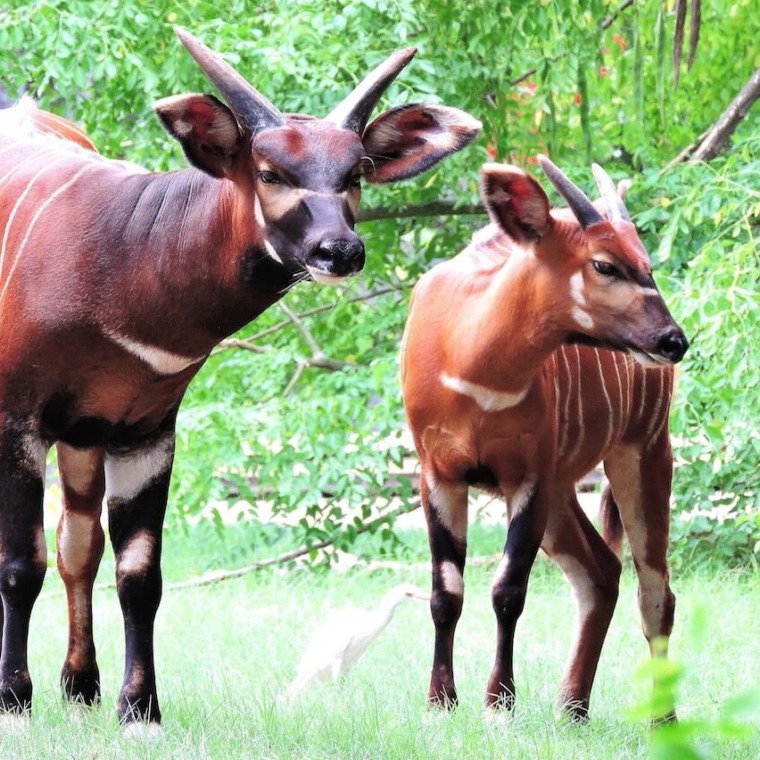
Bongo are most active at dawn and dusk, and often forage near the edges of wooded areas. They normally shy in the wild and flee into the forest for cover at the slightest provocation.
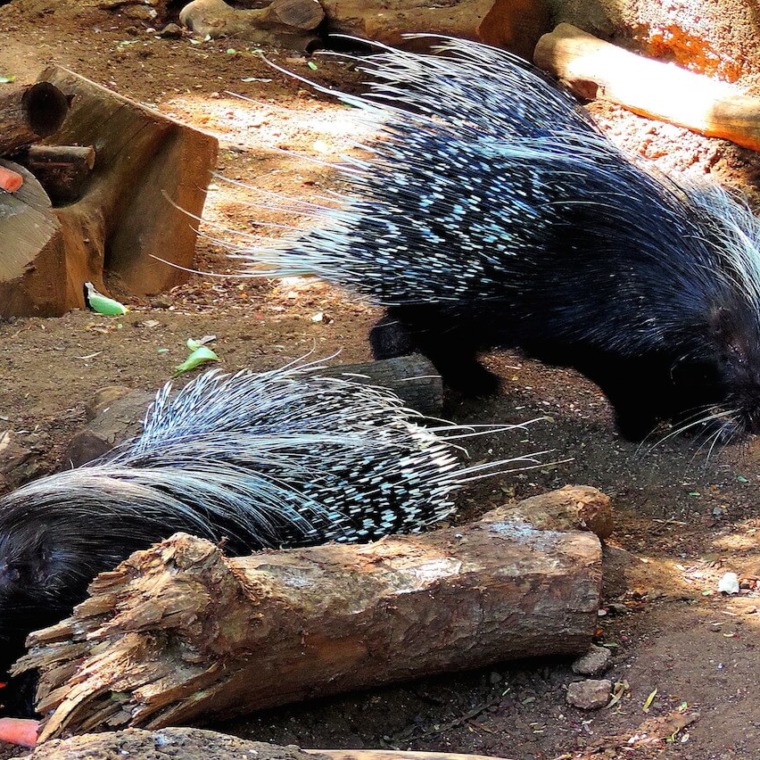
Crested Porcupine
The North African crested porcupine is nocturnal. They are very adaptable and can be found in forests, on plantations, in rocky or mountainous areas as well as in deserts.
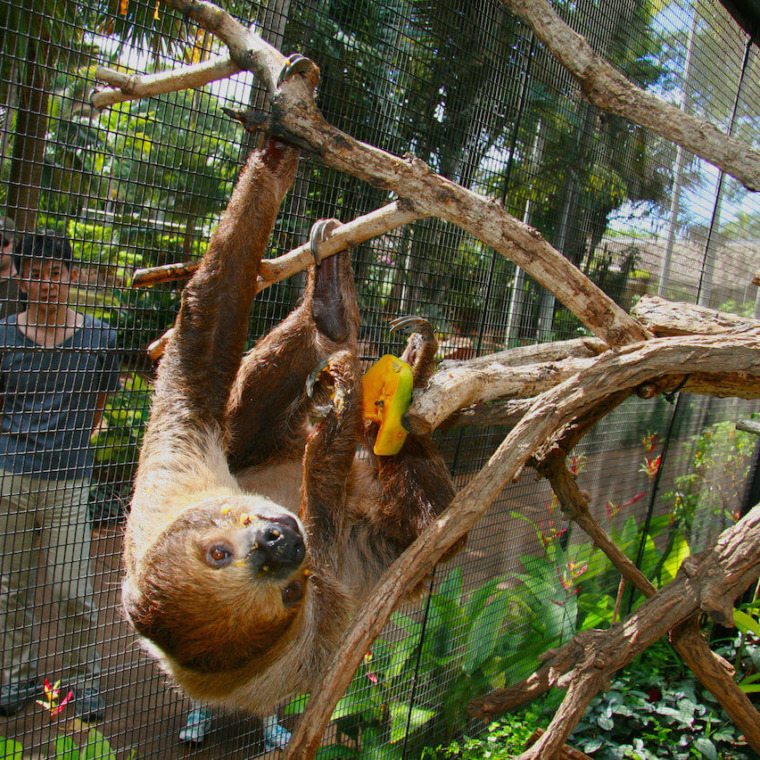
Linne’s Two-toed Sloth
Sloths are found in Central and South America in the rain forest canopy. The Linne’s two-toed sloth is found in such countries as Nicaragua, Columbia, Venezuela, Surinam, Guyana, French Guiana, North Central Brazil, and Northern Peru.
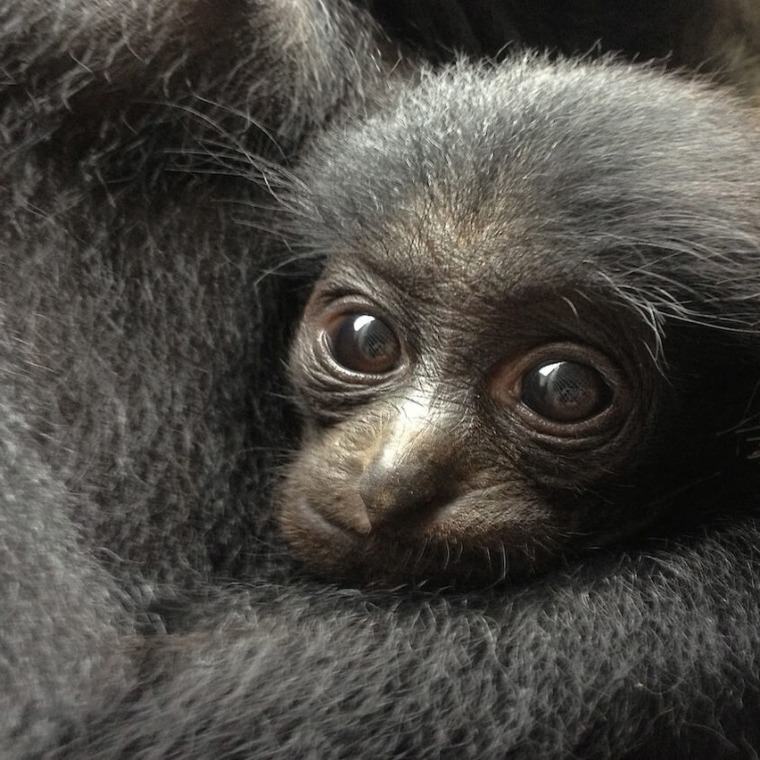
Siamangs range through southeastern Asia and are found in some numbers in the Malay Peninsula and Sumatra.
Privacy settings
With the slider, you can enable or disable different types of cookies:, this website will:.
- Remember which cookies group you accepted
- Essential: Remember your cookie permission setting
- Essential: Allow session cookies
- Essential: Gather information you input into a contact forms, newsletter and other forms across all pages
- Essential: Keep track of what you input in a shopping cart
- Essential: Authenticate that you are logged into your user account
- Essential: Remember language version you selected
This website won't:
- Remember your login details
- Functionality: Remember social media settings
- Functionality: Remember selected region and country
- Analytics: Keep track of your visited pages and interaction taken
- Analytics: Keep track about your location and region based on your IP number
- Analytics: Keep track of the time spent on each page
- Analytics: Increase the data quality of the statistics functions
- Advertising: Tailor information and advertising to your interests based on e.g. the content you have visited before. (Currently we do not use targeting or targeting cookies.
- Advertising: Gather personally identifiable information such as name and location
- Functionality: Remember social media settingsl Functionality: Remember selected region and country
- Advertising: Use information for tailored advertising with third parties
- Advertising: Allow you to connect to social sites
- Advertising: Identify device you are using
- Advertising: Allow you to connect to social sitesl Advertising: Identify device you are using

- Ready-made safaris
- Experiences
- Special offers
- Accommodation
- Start planning
- Booking terms
- When to go on safari - month by month
- East or Southern Africa safari?
- Solo travellers
- Women on safari
- Accommodation types & luxury levels
- General tips & advice
- All stories
- Afrika Odyssey Expedition
- Photographer of the Year
- Read on our app
- 2024 entries
- 2024 details
- 2024 prizes
- 2024 entry form
- 2023 winners
- Collar a lion
- Save a pangolin
- Rules of engagement
- Job vacancies
- Ukuri - safari camps

African canids – 11 fascinating species
Today, 11 African canids, from excitable African painted wolves and shrewd jackals to the tiny fox species, hunt the continent’s desert, alpine grassland, savanna and woodland.
Some 40 million years ago, the first identifiable canid (dog) species, Prohesperocyon wilsoni , arose in what is now Texas. The fossilised remains were classified as Canid partially because of the absent, upper third molars and an enlarged bulla (a hollow structure in the ear). As canids diversified across North America, evolution favoured them with several cursorial adaptations including long limbs and lightweight bodies. They were built to run from the start – a family trait that served them well and has survived in most species. When cooling climates exposed the Bering land bridge, canid ancestors raced, trotted, and slunk across to spread through Asia, Europe and eventually Africa.
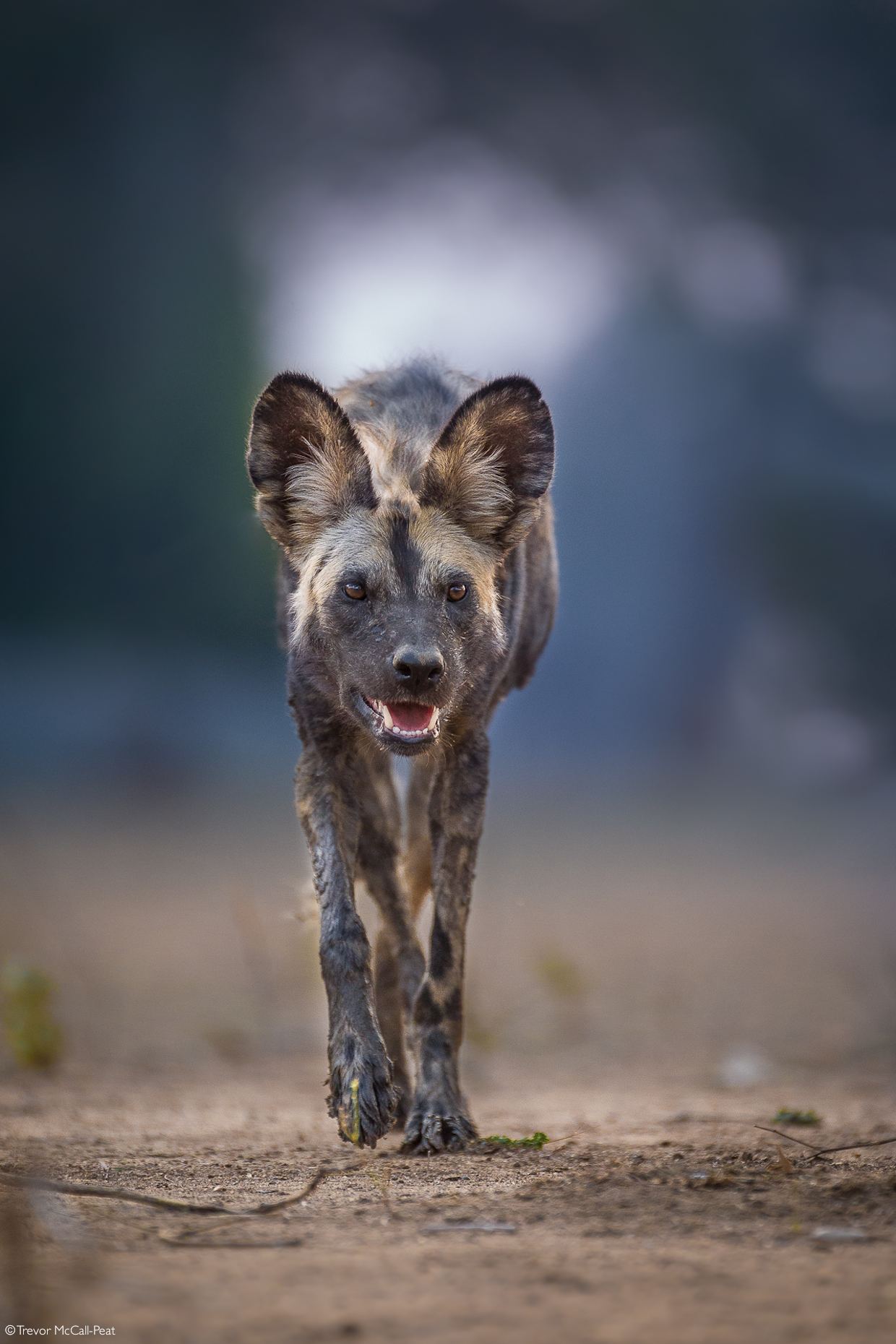
African painted wolf ( Lycaon pictus )
The most well-known African canid, African painted wolves (wild dogs), are the third-largest extant canid in the world and the largest in Africa. They are coursing, cooperative hunters, with lithe, athletic bodies built for speed and stamina. Their frenetic hunting style exploits panic and confusion, creating fast-paced, exhilarating sightings for those fortunate enough to encounter a pack on the move.
African painted wolves live in tight-knit packs, and there is little so heart-warming as watching pack members affectionately reaffirming their bonds. In social situations, the intimate relationships are expressed in joyful greeting ceremonies and play sessions, accompanied by an endearing array of squeaks, yips and whines. The alpha pair typically monopolises breeding, while the rest of the pack devote their attentions to feeding and caring for both the mother and her pups during the denning period.
They are the only member of the Lycaon genus and the only canid to have four toes on the front foot (they lack a dewclaw). Human persecution, habitat loss and fragmentation, and disease have all played a role in devastating African painted wolf populations. They are currently listed as “Endangered” on the IUCN Red List. Further reading: What’s in a name?

Black-backed and side-striped jackals ( Canis mesomelas and Canis adustus )
It is bewildering that the average safari-goer dismisses jackals, intent rather on chasing down traditionally iconic creatures. This is unfortunate because jackals are attractive and adventurous little predators in their own right. Both species are consummate survivors with an indiscriminate palate and a boldness that belies their slender physiques. Jackals are opportunistic omnivores that can quickly and efficiently dispatch invertebrates, birds, reptiles, or even small antelope, but will also readily wolf down fallen fruit or seeds. Furthermore, any animal that dares to snatch the scraps out from beneath a hungry lion’s nose should be entitled to automatic respect.
Jackals are monogamous and territorial, though they may gather in larger numbers when there is a more substantial carcass. Grown offspring from the previous year’s litter occasionally stay and help their parents with subsequent pups – before dispersing. Interestingly, though the black-backed jackal is the smaller of the two, where black-backed and side-striped jackals do occur in the same place, the black-backed tends to dominate interactions.
African golden wolf ( Canis lupaster )
The African golden wolf is notable mainly for the insights it has provided researchers of African canid evolution. Until recently, it was classified as an African variant of the golden jackal, which is widespread throughout the Middle East and Asia. Though scientists had long argued for a distinction between the two species, it was only in 2015 that a series of genetic studies revealed that the golden wolf is more closely related to grey wolves, Ethiopian wolves, and coyotes than it is to Asian golden jackals.
Slightly larger than the two jackal species, African golden wolves can catch and kill prey nearly three times their own mass. This is unusual however, and golden wolves tend to confine themselves to smaller prey species such as rodents, birds, lizards, snakes, and insects.
The wolf-like ancient Egyptian deities such as Anubis (the god of death) may have been based on African golden wolves.

Ethiopian wolf ( Canis simensis )
The Ethiopian wolf has the lamentable honour of being the most endangered carnivore in Africa. Fewer than 500 individuals remain, though this is an optimistic estimate. An IUCN estimate made in 2011 suggested a declining population of just 197 mature individuals.
They are endemic to the Ethiopian Highlands and found at altitudes over 3,000m above sea level, with more than half found in the Bale Mountains. The remaining five populations are isolated and fragmented; threatened by habitat degradation, conflict with humans and diseases carried by feral domestic dogs.
While most canid species are fairly generalist feeders, these beautiful, russet-coated Simien wolves are particularly adept at hunting Afroalpine rodents, especially big-headed mole-rats. The wolves wait patiently until a rodent emerges from its underground burrow before pouncing and digging frantically at the entrance. Interestingly, some wolves form temporary associations with geladas, and research indicates that their hunting efforts are more successful when they associate with these foraging troops. The wolves do not attempt to hunt the geladas, and the primates appear unconcerned by the canids’ presence.
While Ethiopian wolves tend to be solitary hunters, they live in small packs with an established hierarchy and one breeding female, who, when she dies, is usually replaced by one of her daughters.

Bat-eared fox ( Otocyon megalotis )
These little canids are the only insectivorous canid species in the world and, despite their common name, are not true foxes (genus Vulpes ). Instead, they are the only Otocyon member, set apart by their unusual dentition adapted for demolishing invertebrates. They have up to 50 teeth (most canids have around 42), with reduced shearing surfaces on the molars and unique morphological adaptations which allow for extremely rapid chewing. The majority of their prey consists of harvester termites.
Bat-eared foxes are highly social and live in mated pairs or small family groups that forage, play and rest together. Somewhat unusually, the males take on the majority of caretaking activities where the young are concerned.
They are easily identified by their enormous ears (second only to the fennec fox below), and their scientific name refers specifically to this characteristic: “mega” meaning large and “otus” meaning ear.

Cape fox ( Vulpes chama )
The only true fox species in sub-Saharan Africa, the delicate Cape fox prefers semi-arid and arid habitats. In true fox fashion, they are omnivores with a taste for everything from small mammals to seeds and fruit. Though common throughout most of Southern Africa, Cape foxes are nocturnal and seldom seen except in certain reserves where they have become habituated to people.
Though they appear to form monogamous bonds, Cape foxes prefer to forage alone, and the male and female usually only associate during the breeding season. When the kits are born in underground burrows, the male will care for and defend both the mother and young for the first few weeks.

Fennec fox ( Vulpes zerda )
The fennec fox is the smallest canid species on the planet, weighing less than 2kg. They are perfectly adapted for the aridity and blistering temperatures of their Sahara Desert habitat. Most noticeably, their enormous ears, proportionately the largest of any canid species in the world, help dissipate heat – not unlike the ears of an elephant. Their tiny paws are covered in dense fur to protect against extreme heat and maintain traction on the desert sands. Fennec foxes’ most astonishing achievement is the ability to pant at 690 breaths per minute (over ten breaths per second!) without the expected adverse effects of hyperventilation.
They forage for insects, reptiles, small mammals and birds at night. Plants supplement the diet and aid with hydration.
The fennec fox’s Disney-like appearance has made it a popular exotic pet, even though it is ill-suited to a domestic existence away from its natural desert habitat. Though they are highly social, little is known about the intricacies of their societies, and most behavioural observations have been gleaned from captive individuals.

Pale fox ( Vulpes pallida )
Pale foxes are the least studied of all African canids, and little is known about their day-to-day lives or individual numbers. They inhabit the Sahel region of the African continent (the transition zone between the Sahara Desert and savannahs further south). They are distinguished from the Rüppell’s fox (see below) by the black tip on their tails. Just a fraction smaller than the Cape fox, pale foxes are omnivorous and predominantly nocturnal.
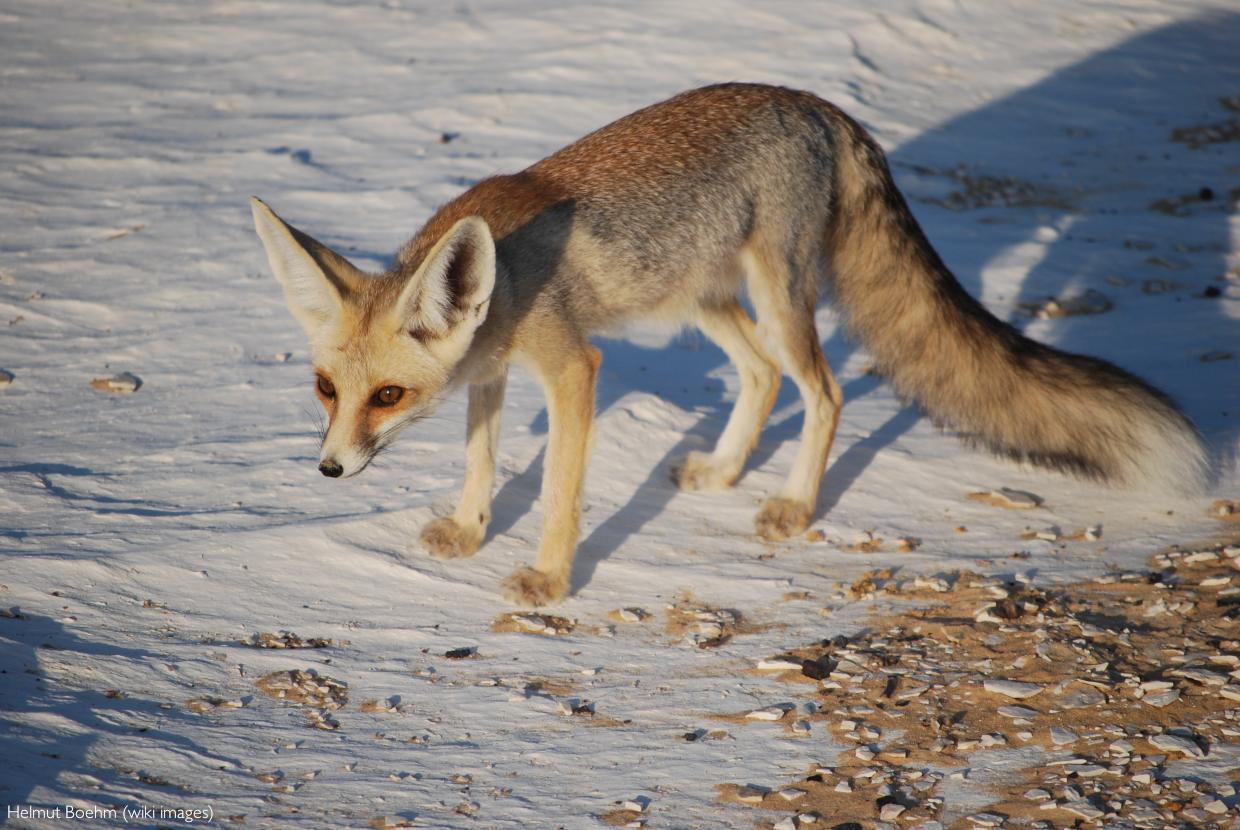
Rüppell’s fox ( Vulpes ruepelli )
The Rüppell’s fox is confined to the continent’s northernmost reaches and is distinguished by a white-tipped tail and black markings under the eye. Like all desert-dwelling foxes, they have enormous ears, though not quite to the same degree as the fennec fox. Though the species is widely distributed, there is little available information on Rüppell’s foxes.

Red fox ( Vulpes vulpes )
Typically associated with the countryside and alleys of European cities, few people realise that red foxes also occur in Africa’s northern fringes. This species is largest of the true foxes, though the southern grey desert subspecies is significantly smaller and less brightly coloured than its European counterparts. These animals are not as well adapted to truly arid areas as other desert foxes and tend to be more common around rivers and oases where there is better access to water.
Barking up the family tree
As the canid ancestors loped their way across Asia and into Africa, they faced competition from the two other hyper-carnivorous predator families: the Felidae (cats) and the Hyaenidae (hyenas). For all predators, the competitive landscape was changing as prey species evolved to run faster through increasingly open habitats. This evolutionary arms race was to shape all three families. The felids came to rely almost exclusively on stealth and ambush, while the dog-like hyenas (distinct from their bone-crunching relatives) all but disappeared ( with one exception ).
[Editorial note: Blanford’s fox ( Vulpes cana ) has been recorded on the Sinai Peninsula in Egypt. There is only one record of an individual collected west of the Suez Canal. While it is possible there are resident populations in the African portions of Egypt, this is unconfirmed, and we have thus omitted this animal from our list.]
HOW TO GET THE MOST OUT OF AFRICA GEOGRAPHIC:
- Travel with us . Travel in Africa is about knowing when and where to go, and with whom. A few weeks too early / late and a few kilometres off course and you could miss the greatest show on Earth. And wouldn’t that be a pity? Browse our ready-made packages or answer a few questions to start planning your dream safari .
- Subscribe to our FREE newsletter / download our FREE app to enjoy the following benefits.
- Plan your safaris in remote parks protected by African Parks via our sister company https://ukuri.travel/ - safari camps for responsible travellers

Friend's Email Address
Your Email Address
Calvin the Fennec Fox

The Fennec Fox
On November 8th 2011 Calvin and his three siblings arrived at the Center. They were born on July 25th 2011 at the Lionshare Educational Organization based in Greenwich, CT.
The mother was unable to care for her litter so the LEO Conservation Center reached out to Greenwich-based Adopt-a-Dog who connected them with Mama, a rescued foxhound who was currently nursing. Mama successfully raised all four fennec fox kits.
The two siblings found homes at the Metro Richmond Zoo, VA; Safari West Zoo, CA.
Resident at our West Hartford CT campus
CT Wildlife Center
- Our Mission
- Our Facilities
- Where Our Animals Come From
Our Animals
- Crocodilians
You Can Help
- Helping the CT Wildlife Center
- Animal Sponsorships


The fennec fox is a small fox found in the African desert that is well known for its overly large bat-like ears.
African Elephant
African grey parrot, african wild dog, albino burmese python, amazon tree boa, american alligator, american desert hare, arctic hare, asian elephant, bactrian camel, bearded dragon, bengal tiger, black panther, black rhinoceros, black widow spider, blue and gold macaw, blue-footed booby, boa constrictor, budgerigar ("budgie"), cape buffalo, chain kingsnake, clouded leopard, coral snake, crested gecko, desert tortoise, domestic pig, dromedary camel, eastern chipmunk, eastern cottontail rabbit, eastern diamondback rattlesnake, emerald tree boa, florida panther, flying squirrel, giant tortoise, gray squirrel, great grey owl, great horned owl, green-winged macaw, grizzly bear, harpy eagle, hippopotamus, honey badger, horned lizard, howler monkey, hyacinth macaw, indian rhino, kermode bear, king vulture, komodo dragon, leopard gecko, long-eared owl, mallard duck, explore the safari.
Ready to start exploring by a topic search below.
Discover Other Animals
Begin discovering other animals below.

- Best Sellers
- New Releases
- Animal Toys
on orders over $60
on orders over $150
- 0-1 (Infant)
- 1-2 (Toddler)
- 3-4 (Preschool)
- 5-6 (Kindergarten)
- 7-9 (Elementary)
- 10-12 (PreTeen)
- 13-17 (Teens)
- Novelty (18+)
- Novelty (21+)
- Safari Ltd.
- EUGY 3D Puzzles
- Shop for a Cause
- Retired Figurines
- Language & Literacy
- Mathematical
- Social Emotional
- Social Studies & Geography
- Arts & Crafts
- Blocks & Building
- Good Luck Minis®
- TOOBS® - Miniature Figurines
- Incredible Creatures ®
- Wild Safari ® Prehistoric World
- Great Dinos
- Mythical Realms®
- Wild Wildlife
- Wild Safari ® Wildlife
- Wild Safari® North American Wildlife
- Wings of the World Birds
- Winner's Circle Horses
- Safari Farm
- Wild Safari ® Sea Life
- Best in Show
- Safariology & Life Cycles
- All Figurines
- Mathematical Toys
- Scientific Toys
- Outdoor Toys
- Eco-Friendly Plush
- Luxury Plush
- Puzzles & Games
- Soothies, Teethers, & Rattles
- Toy Storage
- Wooden Toys
- For Baby Boys
- For Baby Girls
- Gender Neutral
- Birthday Boy
- Birthday Girl
- Birthday Gifts for Anyone
- Spring Toys
- Mother's Day
- Father's Day
- SafariPedia
- Return Policy
- Shipping & Handling
- International Retailers
6" Plush Wild Onez Fennec Fox

This adorable little Fennec Fox plush toy is sitting pretty, and with its cute oversized ears, it's ready for cuddles!
Characteristics: Petting Zoo Plush has been a leader in plush stuffed animal toys for decades, and their Wild Onez line features tons of adorable plush animal toys, like this endearing Fennec Fox stuffed animal ! Made with recycled materials.
Size: 6 inches
Age: 3 years and up
- Our Process
- Bernie The Gator
- Product Guide
- Profession Discounts
- 2023 Catalog
- Wholesale Website
- Wholesale Application
- Safety Reports
Top Collections
Let's get connected.

- Privacy Policy
- Terms & Conditions
- Accessibility Statement
Copyright © 2024 Safari Ltd®.
Added to your cart:

Get the most of your stay in Moscow

TOP-11 Moscow Parks to Visit
I have chosen the best 11 Moscow parks to visit and spend a beautiful time for you. Do not miss and choose one that you like the most – cycling, festivals, flowers, panoramic views and many other things are waiting for you!
Gorky Park (The Central Park of Culture and Leisure) – The main one of the Moscow Parks
In my opinion this park could be called the main park of the city. Why? Because of its huge territory, the central location and the amount of people visiting the park daily. It was founded in 1928 and in 2011 it was totally reconstructed. Now it pleases visitors with modern objects and soft green lawns.
- Oktybrskaya or Park Kultuty metro station, Krimsky Val, 9
The Gorky park is a the right choice for everyone! The youth will like a free WiFi, bicycles, skateboards and other rentals; the couples will enjoy spending time near the river, watching a sunset; parents will appreciate colorful playgrounds and a room for mother and child. Everyone can find something for themselves: from yoga classes to watching movies in a cozy summer cinema, from dance classes to volleyball playground. Gorky Park is also the venue for all kinds of exhibitions, festivals, events for children and adults. During the winter there is one of the biggest skating rinks in the park.
Museon Art Park – A Second Gorky they say
“Museon” is located on the opposite side of Krimsky Val street. And right now some people believe that Gorky and Museon together is a one space sharing the same beauty.
- Oktybrskaya or Park Kultuty metro station, Krimsky Val, 2
The Park of Arts was named this way because there is the largest composition of open-air sculptures in Russia. In its territory there are already more than 1000 unique exhibits: from monuments of the socialist realism era to various kinds of contemporary art. But this is not all the attractions of the park. In recent years, “Museon” has become an important cultural site of the city. The park regularly hold many different concerts, festivals, educational projects in the field of art and design. There is a Central House of the Artist, a comfortable summer cinema and other attractions on territory. Be sure to stroll pedestrian Crimean embankment, which looks like a modern park.
Neskuchny Garden – True Russian Nature is Here
Neskuchny garden is located on the right bank of the Moscow River. Today it is also seen as a part of the Gorky Park. This landscape park is one of the oldest in the city and is protected by the state. Its name was received from the Neskuchnoye Estate of Prince Trubetskoi which is still located in the park.
- Leninsky Prospekt metro station, Leninsky Prospect, 30
This park is famous mostly for its location close to the Gorky park. It is a quite place with true nature, lots of trees and squirrels and also ancient architecture. As in every park, there are sports and playgrounds, cafes and even a football field.
Zaryadye Park – 5 Steps Away From The Red Square
The area of this brand new park was opened only in September 2017 and located in the very heart of Moscow – right near the Red Square.
- Open from 10AM to 10PM
- Teatralnaya, Okhotnyi ryad, Ploschad Revolutsii
The park has 4 zones, each of them represent different parts of Russian landscapes. Above the river there is a floating bridge from where you get to see one of the best panoramic views on Moscow. Other attractions of the park are 5D cinema where you can take a flight above Moscow, few cafes and restaurants, pretty lakes with fishes and old preserved churches. In addition there is still being built a philharmonic hall, covered with a huge dome and an Ice cage where the temperature will always stay below zero degrees.
When you are on the Red Square do not miss it!
All-Russia Exhibition Center (VDNKh) – The Soviet Style Moscow Park
Park VDNKh – one of the most famous parks in Moscow. This park is one of the sights of the city as it hasn’t changed much since the Soviet era.
- VDNKh metro station, Prospect Mira, 119
The symbol of VDNKh is a fountain with 16 women symbolizing the friendship of the nations of the USSR. Around this fountain there are all the pavilions representing 16 republics. Now inside the pavilions you find various shops, cafes and exhibitions. If you go deep inside the park you will find a rocket Vostok and and an aircraft. What is funny the inside of the aircraft there is actually a photo exhibition. Near the northern entrance you there is a famous sculpture “Worker and Kolkhoz Woman”. It is extremely famous among Russians as all the movies by Mosfilm corporation used to start with the picture of this statue. But if you go further inside the park you will reach a very calm area. A lake is there, forest and birds singing. Since the park occupies a large area I suggest you to rent a bicycle.
Sokolniki Park – A Place For A Hunt Or For Leisure?
The park got its name because of the royal falconry, which took place there in the past when there was a dense forest. (Sokol means a falcon.) In 2011 it was significantly transformed: updated lawns, landscaped ponds and picnic areas, restored summer cinema and theater, a large rose garden, sports grounds, bicycle paths and other things.
- Sokolniki metro station, Sokolnichesky Val, 1, p. 1
From the main entrance along the alley you can walk to the Sokolniki circle, where 8 alleys form 9 sectors, in each of them you will find trees of the same breed. The park is famous for its rosary, as well as flower decoration. On the territory of the park there are concert halls, a library, amusement zone, dances zone and many many other attractions. In winter the park has a skating rink (a free of charge one) and ski runs. During the warm season you can rent a bicycle.
Tsaritsino Park – A Different World Inside Moscow
Here you can walk for hours, admiring the most beautiful nature and magnificent architecture.
- Open from 6AM to 12AM
- Tsaritsyno metro station, Dolsky, 1
The most amazing part of the park is the lake with a light and musical fountain. Every evening the fountain starts the show. Lights and music combined make you feel like you are not in Moscow but in a fairy tale. The park is also well equipped for sports lovers and healthy lifestyle. There are volleyball and basketball courts, a tennis court, sports facilities for acrobatics, bodybuilding equipment.
What I personally like about this park is the atmosphere. This place is actually far from the city center but I love going there anyway. Whenever I go there I feel like I left Moscow with all its hectic lifestyle. It is the place where I relax, enjoy myself or a company of my friends and feel kind of different. By the way totally suggested for a date!
Kolomenskoye Park – Combination Of Reserve and Architecture
The Kolomenskoye park is actually a Museum-Reserve. It is a former residence of Russian tsars and one of the most scenic places in Moscow.
- May to September – open from 8AM to 12AM, October to April – from 8AM to 9PM
- Kolomenskoye metro station, Andropov Ave, 39
Alike with Tsaritsino park Kolomenskoye park has its own special atmosphere with all the architecture, trees, ponds and even a river bank. The park regularly hosts various folk festivals and different fairs. In summer time you can play with kites or rent a bicycle and ride around the huge area of the park.
I love the view that you get on the city from one of the hills near the river. I love the apple trees alleys and the beautiful churches. It is also a bit far from the city center but yet worth going there. One of my best friends even celebrated her wedding there.
Aptekarsky Garden or Botanical garden of the Moscow State University – The Best Botanical Garden in The World
Aptekar in Russian language means a pharmacist so basically it is a pharmacist’s garden. It was founded in 1706 by Peter The Great for growing medicinal plants for the royal family. But later they moved it from under the walls of the Kremlin to the current location.
- Open from 10AM to 8PM
- Prospect Mira metro station, Prospekt Mira, 26
In the botanical garden there are no attractions and noisy crowds of tourists. The area of the garden is not as big as any other park in Moscow. And the entrance is not free. But this exactly what makes this park one of the most comfortable in the city. In the Aptekarsky garden they grow thousands of different plants, flowers and trees. Some of the trees are more than 300 years old. They held different festivals there: flowers festivals, sand and ice sculptures expositions.
For me it is one of the most beautiful parks not only in Moscow but in the world. I have never seen so many different flowers and plants anywhere else. And trust me I am a real park lover. And what is more the staff really takes care about every single tree or plant there, some of the trees have names and stories. I love it there and I think the price is really worth what you get.
Victory Park – A Park That Makes Us Remember The War
The park is located on the Poklonnaya Hill and it has one of the world’s largest memorial complexes dedicated to the World War II. The park was opened for the 50th anniversary of the Victory on May 9, 1995. It is also one of the main venues in the city for holding a variety of mass events.
- Park Pobedy metro station, Brothers Fonchenko, 7
On the main avenue of the park there are with 1418 fountains – exactly as long as the war lasted. Fountains make five water terraces, symbolizing five years of military operations. And in the center of the park there is the Museum of the Great Patriotic War. If you are interested in the history of the war do not miss it. The Poklonnaya Hill is a part of the park and from the hill you get one of the best views on the city of Moscow. And I could say this is the best place for watching the fireworks during the mass celebrations. But be aware it gets too crowded then. As in most of the other big parks you can rent a bicycle or rollers there.
Izmailovsky Park – A Mix of a Big Forest and Attractions
Izmaylovsky Park occupies a huge green territory, making up a large part of the Izmailovo district. The park consists of two parts: Izmaylovsky Park of Culture and Rest and the forest park of Izmailovo. First part is full of attractions and restaurants while the second one is like a real forest with pine trees, birch groves, beautiful clearings and ponds.
- Izmaylovskaya, Shosse Entuziastov or Partizanskaya metro stations, Izmaylovsky Park
It is easy to spend there a whole day. A large landscaped area and a lot of various entertainments for children and adults will help you not to get bored. An observation wheel, a boat station, children’s playgrounds, a dance floor, sports grounds, a skate park – all this is only a small part of the possible leisure activities. In the park there are bike paths and a rental services.
I don’t go there often to be honest. But the park is very very close whenever to a souvenir market on Partizanskaya metro station. And whenever the weather is nice and I have enough of free time I stroll through the alleys of the park and enjoy the nature. So if you are going to the souvenir market too and you have enough free time then do go to the park too.
5 thoughts on “TOP-11 Moscow Parks to Visit”
Pingback: Places to visit in Moscow – Sheran Bhattacharyya
Yes, sure 🙂 This is my top list 🙂
Yes, sure. These are my favorites!
I like this blog very much. Please keep sharing it in future too.
Thanks for sharing.
Thank you! 🙂
Leave a Comment Cancel Reply
Your email address will not be published. Required fields are marked *
Watch CBS News
At least 40 killed and dozens injured in Moscow concert hall shooting; ISIS claims responsibility
Updated on: March 22, 2024 / 8:30 PM EDT / CBS/AP
Several gunmen burst into a large concert hall on the edge of Moscow on Friday and sprayed the crowd with automatic gunfire, killing at least 40 people, injuring more than 100 others and setting fire to the venue in a brazen attack just days after President Vladimir Putin cemented his grip on power in a highly orchestrated electoral landslide.
Moscow Mayor Sergei Sobyanin described the attack as a "huge tragedy" and which state authorities are investigating as terrorism. The attack, which left the concert hall in flames with a collapsed roof, was the deadliest attack in Russia in years and came as the country's war in Ukraine dragged into a third year.
The Islamic State group has claimed responsibility for the attack in a statement posted on affiliated channels on social media. In a statement posted by its Aamaq news agency, the group said it attacked a large gathering of Christians in the city of Krasnogorsk on the outskirts of the Russian capital of Moscow, killing and wounding hundreds. It was not immediately possible to verify the authenticity of the claim.
A U.S. official tells CBS News the U.S. has intelligence confirming the Islamic State's claims of responsibility, and that they have no reason to doubt those claims. The U.S. official also confirmed that the U.S. provided intelligence to Russia about a potential attack under the intelligence community's Duty to Warn requirement.
National Security Council spokesperson Adrienne Watson confirmed that in a statement provided to CBS News Friday evening.
"Earlier this month, the U.S. government had information about a planned terrorist attack in Moscow —potentially targeting large gatherings, to include concerts— which prompted the State Department to issue a public advisory to Americans in Russia," Watson said. "The U.S. government also shared this information with Russian authorities in accordance with its longstanding 'duty to warn' policy."
A U.S. law enforcement official tells CBS News that there is no known threat to the U.S. emanating from the Moscow attack.
Russia's Federal Security Service, the main domestic security and counter-terrorism agency, said 40 people were killed and more than 100 were wounded in the attack at Crocus City Hall, a large music hall on Moscow's western edge.
The assailants threw explosives, triggering the massive blaze at the hall, which can accommodate 6,000, according to Russian news outlets. Video from outside showed the building on fire, with a huge cloud of smoke rising through the night sky. The street was lit up by the blinking blue lights of dozens of firetrucks, ambulances and other emergency vehicles.
The attack took place as crowds gathered for a performance by the famous Russian rock band Picnic. Russian news reports said concertgoers were being evacuated, but that an unknown number could have been trapped by the blaze.
The prosecutor's office said several men in combat fatigues entered the concert hall and fired on concertgoers.

Repeated volleys of gunfire could be heard in videos posted by Russian media and on Telegram channels. One showed two men with rifles moving through the venue. Another showed a man inside the auditorium and saying the assailants had set it on fire, as gunshots rang out incessantly in the background.
Other videos showed up to four attackers, armed with assault rifles and wearing caps, who were shooting at screaming people at point-blank range.
Guards at the concert hall didn't have guns, and some could have been killed at the start of the attack, Russian media reported. It wasn't immediately clear what happened to the assailants, but some Russian news outlets suggested that they fled before special forces and riot police arrived.
Russian authorities said security has been tightened at Moscow's airports, railway stations and the capital's sprawling subway system. Moscow's mayor canceled all mass gatherings, and theaters and museums shut for the weekend. Other Russian regions also tightened security.

The Kremlin hasn't blamed anyone for the attack, but some Russian lawmakers were quick to accuse Ukraine of being behind it. Hours before the attack, the Russian military launched a sweeping barrage on Ukraine's power system, crippling the country's biggest hydroelectric plant and other energy facilities and leaving more than a million people without electricity.
John Kirby, a spokesman for the White House National Security Council, said Friday that he couldn't yet speak about all the details but that "the images are just horrible. And just hard to watch."
"Our thoughts are going to be with the victims of this terrible, terrible shooting attack," Kirby said. "There are some moms and dads and brothers and sisters and sons and daughters who haven't gotten the news yet. This is going to be a tough day."
The attack followed a statement issued earlier this month by the U.S. Embassy in Moscow that urged Americans to avoid crowded places in the Russian capital in view of "imminent" plans by extremists to target large gatherings in Moscow, a warning that was repeated by several other Western embassies.
Asked about the embassy's notice issued on March 7, Kirby referred the question to the State Department, adding: "I don't think that was related to this specific attack."
Responding to a question about whether Washington had any prior information about the assault, Kirby responded: "I'm not aware of any advance knowledge that we had of this terrible attack."
Russia was shaken by a series of deadly terror attacks in the early 2000s during the fighting with separatists in the Russian province of Chechnya.
In October 2002, Chechen militants took about 800 people hostage at a Moscow theater. Two days later, Russian special forces stormed the building, and 129 hostages and 41 Chechen fighters died, most of them from the effects of narcotic gas Russian forces used to subdue the attackers.
And in September 2004, about 30 Chechen militants seized a school in Beslan in southern Russia, taking hundreds of hostages. The siege ended in a bloodbath two days later and more than 330 people, about half of them children, were killed.
CBS News' David Martin, Andy Triay and Olivia Gazis contributed to this report.
More from CBS News

Russia arrests another suspect in concert hall attack that killed 144

U.K. man charged with "Russia-backed arson" attack in London

Russia attacks Ukrainian energy sector as Kyiv launches drones

Russian court extends Evan Gershkovich's pretrial detention yet again
THE 5 BEST Moscow Safaris
Safaris in moscow.
- Adrenaline & Extreme Tours
- Gear Rentals
- Nature & Wildlife Tours
- 5.0 of 5 bubbles
- District Central (TsAO)
- 3rd Transport Ring (TTK)
- District North-Eastern (SVAO)
- District Eastern (VAO)
- District South-Western (YuZAO)
- Lomonosovskiy
- Ostankinskiy
- Meshchanskiy
- Krasnoselskiy
- Maryina Roshcha (Jewish Quarter)
- Good for Couples
- Good for Kids
- Good for Big Groups
- Adventurous
- Budget-friendly
- Good for a Rainy Day
- Hidden Gems
- Honeymoon spot
- Good for Adrenaline Seekers
- Things to do ranked using Tripadvisor data including reviews, ratings, photos, and popularity.

1. Rybokhotsoyuz

2. Easy Russia Tour Guide
3. UTS GROUP

4. 365AltaiMongolia

5. #1 Russia -Tanzania | Zanzibar, Serengeti Safari & Kilimanjaro Agency | BURIGI CHATO SAFARIS CO LTD

6. Aviashop.Ru

7. Transsib Moscow

8. BASK TOUR
- Easy Russia Tour Guide
- #1 Russia -Tanzania | Zanzibar, Serengeti Safari & Kilimanjaro Agency | BURIGI CHATO SAFARIS CO LTD
- 365AltaiMongolia

COMMENTS
Up to 10 years in the wild, up to 12 years under human care. Height. ~7 - 8.5 in (~18 - 22 cm) Weight. ~1.8 - 4.1 lbs (~0.8 - 1.87 kg) The IUCN Red List describes the fennec fox as a species of Least Concern, meaning conservationists around the world are not currently worried about the continuation of this species.
Many of our animals enjoyed Easter eggs! 🥚 Shown here are the fennec fox, red river hogs, ring-tailed lemurs, and warthogs. 🎥: Animal Caregivers Veronica Nabor, Lindsey Kaemingk, Nazmieh Kawasmi, and Ellie Gressman.
The Fennec fox primarily inhabits the Sahara Desert and other arid regions of North Africa. Its geographic distribution extends from Morocco and Algeria in the west to Egypt and Sudan in the east. These foxes have adapted to thrive in the desert environment, where food and water can be scarce.
Safari West in Santa Rosa, California is now home two two six-week-old Fennec Fox kits. Bella, is pictured above and last with Bev Baily, Animal Collections Manager for Safari West. Bill, Bella's brother, is seen having his breakfast in the second picture.
This diminutive desert dweller is smaller than a typical house cat. The fennec fox has a long, bushy tail, a small snout and a typically fox-like 'triangular' face. The species is famous for its distinctive long ears. These can be up to 15 cm (5.9 in) long; quite a size compared to the animal's relatively small body!
Fennec foxes are monogamous and mate for life. Litters consist of 2-5 kits, after a gestation period of about 50 days. Females stay with the kits until they are weaned, after 60 to 70 days; and males venture to hunt for food for the family. Kits reach sexual maturity at 10 months old. Like other canids, fennec foxes bark, as well as whimper and ...
The fennec fox is the smallest of all the world's foxes, but its large ears, measuring 6 inches, appear to be on loan from a bigger relative. Desert Adaptations Fennec foxes dwell in the sandy ...
The fennec fox (Vulpes zerda) is a small crepuscular fox native to the deserts of North Africa, ranging from Western Sahara and Mauritania to the Sinai Peninsula. Its most distinctive feature is its unusually large ears, which serve to dissipate heat and listen for underground prey. The fennec is the smallest fox species. Its coat, ears, and kidney functions have adapted to the desert ...
STATUS: Least Concern. HABITAT: Fennec Foxes dwell in North Africa in the sandy Sahara Desert. DIET: The Fennec Fox is an omnivore, which means that it eats plants and animals. Its diet includes desert plants, rodents, insects, bird, eggs, and rabbits. GENERAL: Fennec Foxes are nocturnal, which means that they are awake at night and sleep ...
The Fennec Fox is one of the smallest wild canine species and a popular pet in some parts of the world. Learn where they live, how big the are and what they eat ... THE TOP SAFARI DESTINATIONS IN SOUTHERN AFRICA: ... From the rain-drenched northern forests to the dry deciduous regions in the west and the bamboo groves of the east, Aye Ayes make ...
Explore the life of the Sahara's Fennec Fox, its unique adaptations, lifestyle, and the vital conservation efforts to protect this remarkable species.
The Fennec Fox enjoys a wide range with stable populations, so it is listed as a species of Least Concern by the IUCN Red List. Some wild individuals are collected for the pet trade, but the Honolulu Zoo cautions against keeping animals directly from the wild, as they are untrusting of humans, and their nocturnal habits make for poor companions.
The fennec fox is the smallest canid species on the planet, weighing less than 2kg. They are perfectly adapted for the aridity and blistering temperatures of their Sahara Desert habitat. Most noticeably, their enormous ears, proportionately the largest of any canid species in the world, help dissipate heat - not unlike the ears of an elephant.
Photo credits: Safari West. Santa Rosa CA's Safari West shared a new picture of their Fennec Fox kits Bella and Bill.. The pair (as well as their radar-like ears!) are growing up fast. Join us on Facebook to caption this photo in the comments section.
The Fennec Fox. On November 8th 2011 Calvin and his three siblings arrived at the Center. They were born on July 25th 2011 at the Lionshare Educational Organization based in Greenwich, CT. The mother was unable to care for her litter so the LEO Conservation Center reached out to Greenwich-based Adopt-a-Dog who connected them with Mama, a ...
Safari Ltd Fennec Fox Toys. Wild Safari Wildlife Fennec Fox Figurine . Sahara Desert Animals TOOB Set with Fennec Fox Mini Figure . 192 Piece Good Luck Minis set of Fennec Fox Mini Figures . Desert Fun Pack with Fennec Fox Good Luck Mini Figure. See More. Wildlife. Aardvark.
The Ramat Gan Safari introduced its new additions Sunday: four 7-week-old fennec fox kits. The four are the offspring of proud parents Penny, who was born in the UK and came to Israel five years ...
This adorable little Fennec Fox plush toy is sitting pretty, and with its cute oversized ears, it's ready for cuddles!. Characteristics: Petting Zoo Plush has been a leader in plush stuffed animal toys for decades, and their Wild Onez line features tons of adorable plush animal toys, like this endearing Fennec Fox stuffed animal!Made with recycled materials.
The Battle of Moscow was a military campaign that consisted of two periods of strategically significant fighting on a 600 km (370 mi) sector of the Eastern Front during World War II, between September 1941 and January 1942.The Soviet defensive effort frustrated Hitler's attack on Moscow, the capital and largest city of the Soviet Union.Moscow was one of the primary military and political ...
The Kolomenskoye park is actually a Museum-Reserve. It is a former residence of Russian tsars and one of the most scenic places in Moscow. Free. May to September - open from 8AM to 12AM, October to April - from 8AM to 9PM. Kolomenskoye metro station, Andropov Ave, 39.
Dozens killed in shooting in Moscow concert hall 01:59. Several gunmen burst into a large concert hall on the edge of Moscow on Friday and sprayed the crowd with automatic gunfire, killing at ...
5. #1 Russia -Tanzania | Zanzibar, Serengeti Safari & Kilimanjaro Agency | BURIGI CHATO SAFARIS CO LTD. Multi-day Tours • 4WD, ATV & Off-Road Tours. Open now. 6. Aviashop.Ru. ... 1-Hour West Islands & Eagle Bluff Lighthouse Cruise Seal Snorkeling with Animal Ocean in Hout Bay Postojna Cave & Predjama Castle from Trieste Pompeii, ...